Legal and Ethical Compliance: Disability Support Workbook Assessment
VerifiedAdded on 2023/01/06
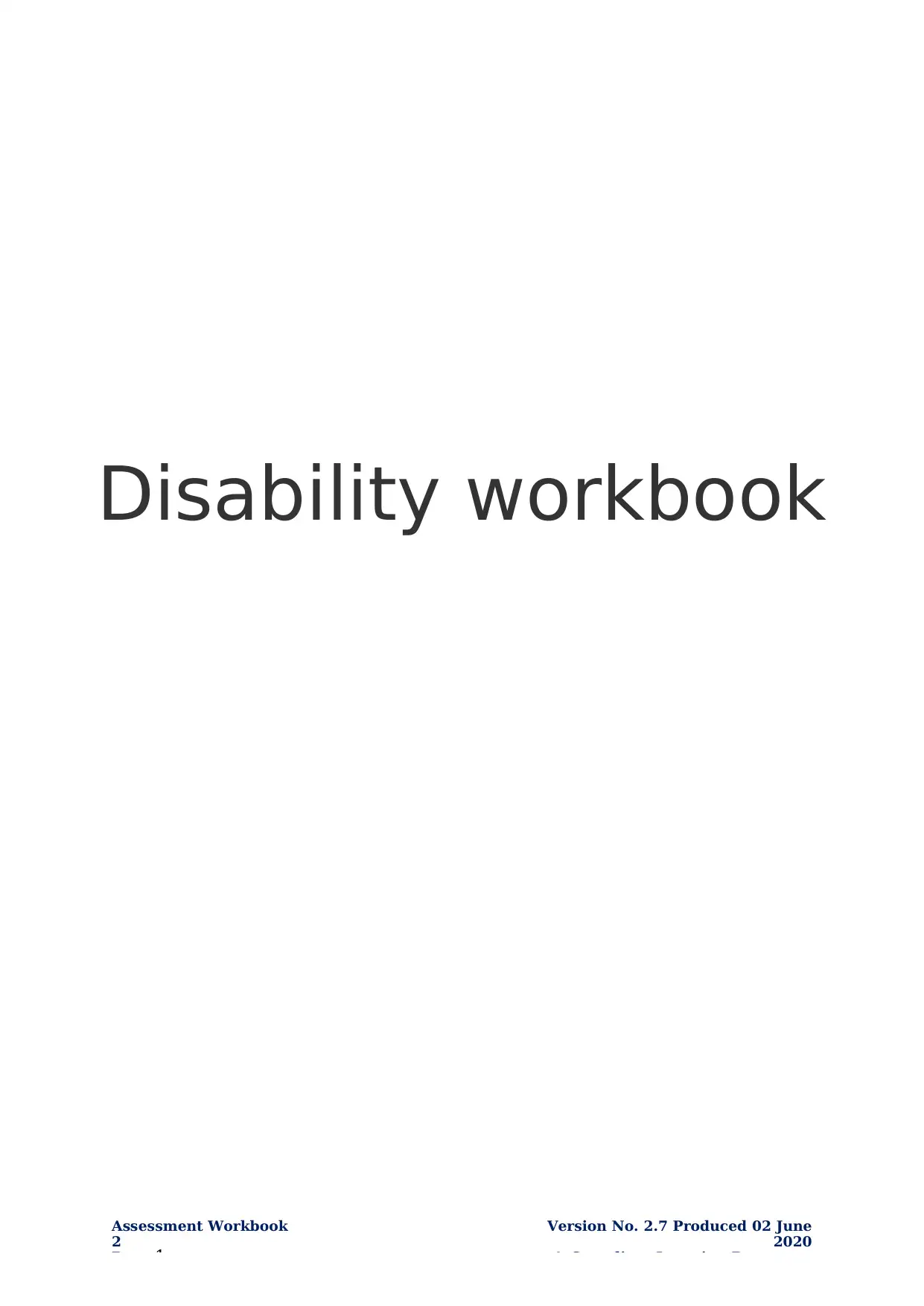
2
Page 1
Version No. 2.7 Produced 02 June
2020
© Compliant Learning Resources
Disability workbook
Paraphrase This Document
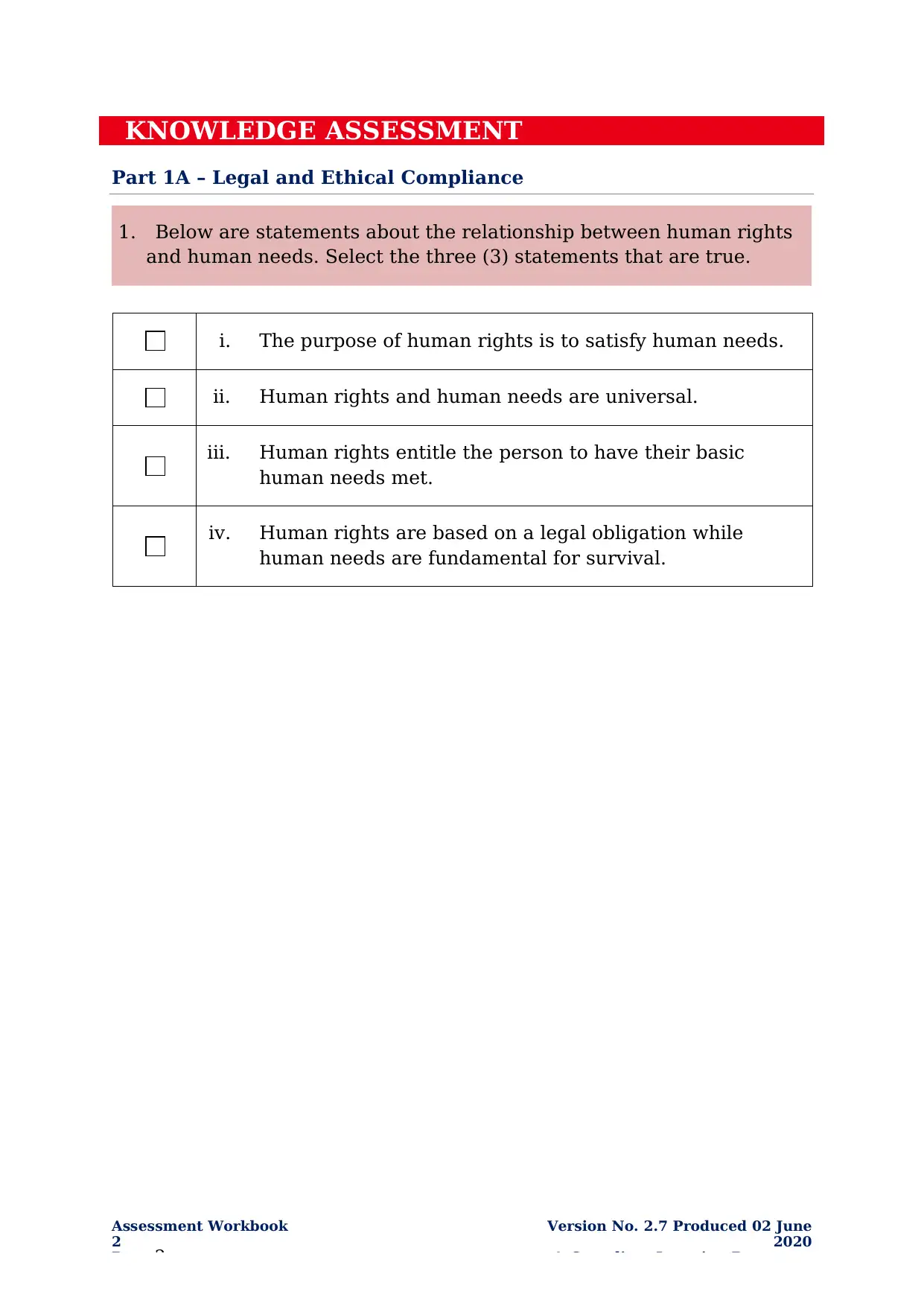
2
Page 2
Version No. 2.7 Produced 02 June
2020
© Compliant Learning Resources
KNOWLEDGE ASSESSMENT
Part 1A – Legal and Ethical Compliance
i. The purpose of human rights is to satisfy human needs.
ii. Human rights and human needs are universal.
iii. Human rights entitle the person to have their basic
human needs met.
iv. Human rights are based on a legal obligation while
human needs are fundamental for survival.
1. Below are statements about the relationship between human rights
and human needs. Select the three (3) statements that are true.
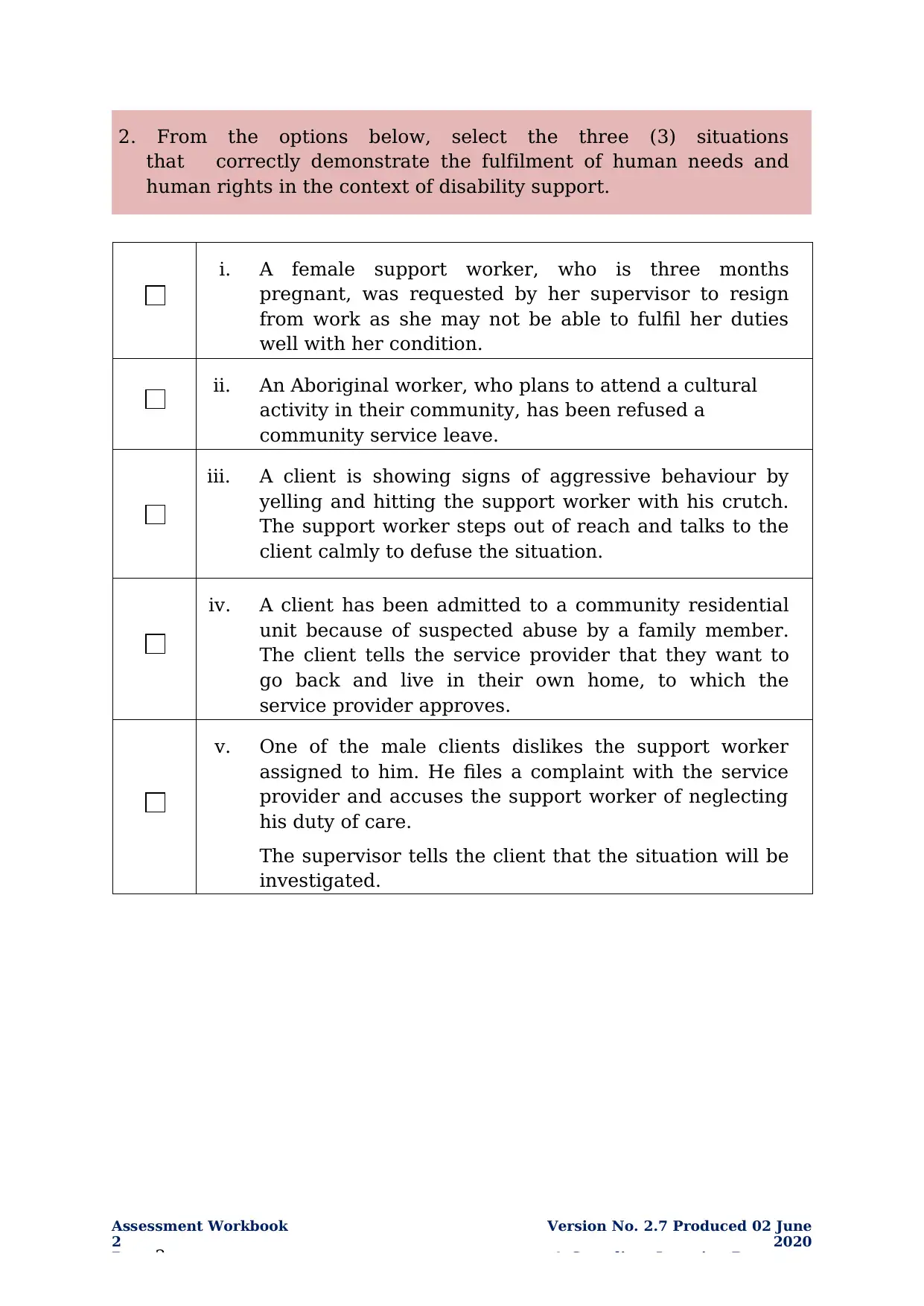
2
Page 3
Version No. 2.7 Produced 02 June
2020
© Compliant Learning Resources
i. A female support worker, who is three months
pregnant, was requested by her supervisor to resign
from work as she may not be able to fulfil her duties
well with her condition.
ii. An Aboriginal worker, who plans to attend a cultural
activity in their community, has been refused a
community service leave.
iii. A client is showing signs of aggressive behaviour by
yelling and hitting the support worker with his crutch.
The support worker steps out of reach and talks to the
client calmly to defuse the situation.
iv. A client has been admitted to a community residential
unit because of suspected abuse by a family member.
The client tells the service provider that they want to
go back and live in their own home, to which the
service provider approves.
v. One of the male clients dislikes the support worker
assigned to him. He files a complaint with the service
provider and accuses the support worker of neglecting
his duty of care.
The supervisor tells the client that the situation will be
investigated.
2. From the options below, select the three (3) situations
that correctly demonstrate the fulfilment of human needs and
human rights in the context of disability support.
You're viewing a preview
Unlock full access by subscribing today!
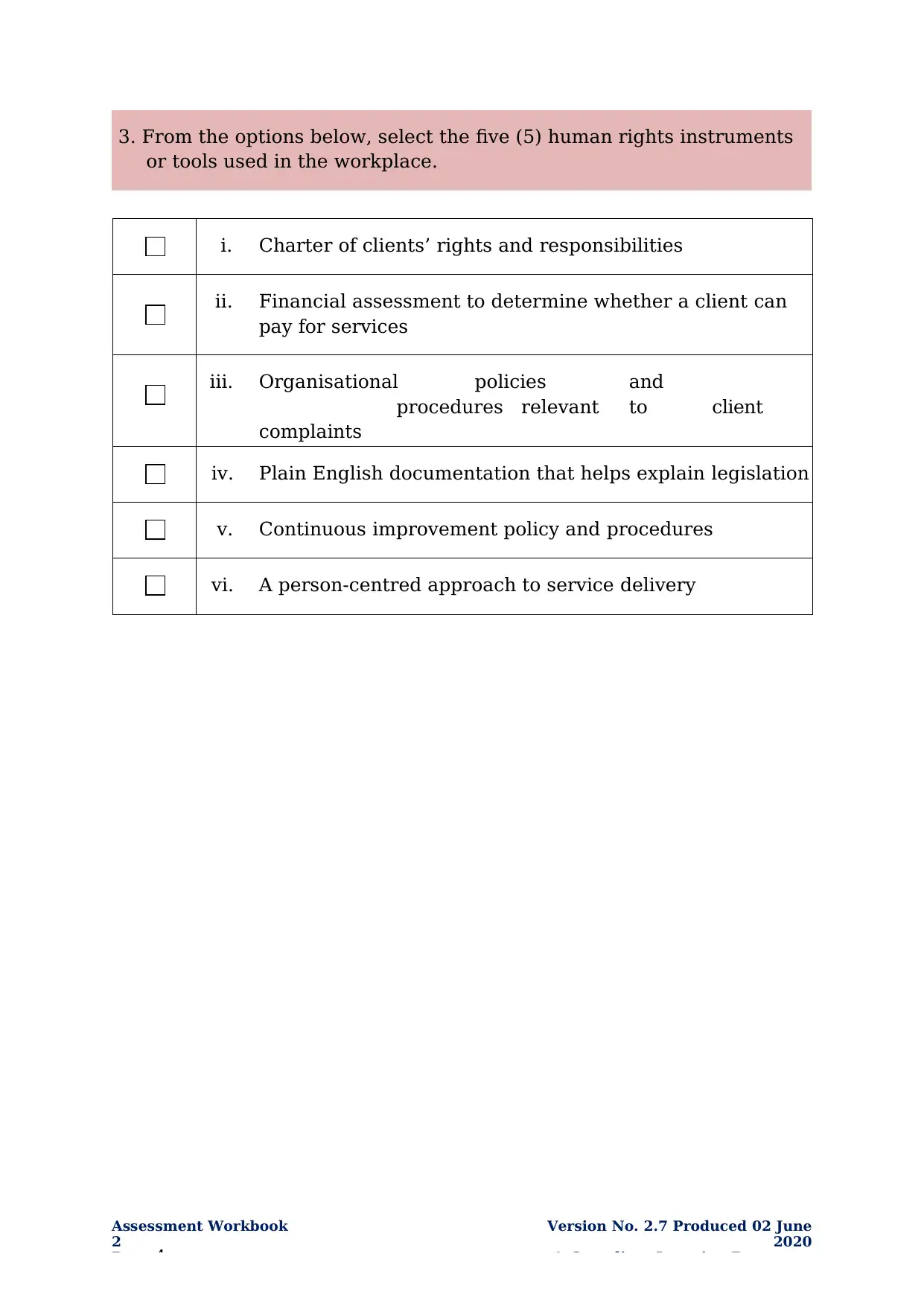
2
Page 4
Version No. 2.7 Produced 02 June
2020
© Compliant Learning Resources
i. Charter of clients’ rights and responsibilities
ii. Financial assessment to determine whether a client can
pay for services
iii. Organisational policies and
procedures relevant to client
complaints
iv. Plain English documentation that helps explain legislation
v. Continuous improvement policy and procedures
vi. A person-centred approach to service delivery
3. From the options below, select the five (5) human rights instruments
or tools used in the workplace.
Paraphrase This Document
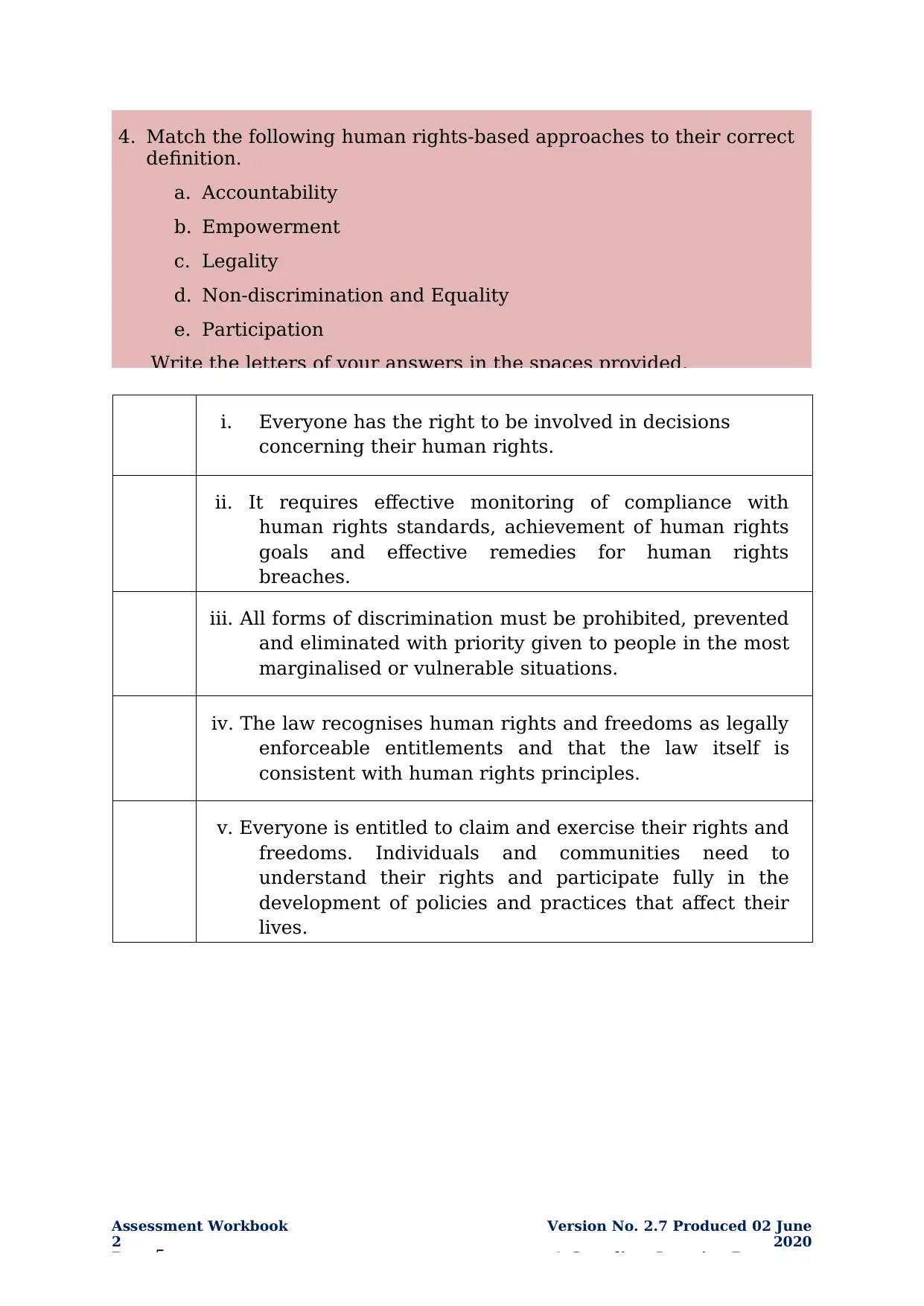
2
Page 5
Version No. 2.7 Produced 02 June
2020
© Compliant Learning Resources
i. Everyone has the right to be involved in decisions
concerning their human rights.
ii. It requires effective monitoring of compliance with
human rights standards, achievement of human rights
goals and effective remedies for human rights
breaches.
iii. All forms of discrimination must be prohibited, prevented
and eliminated with priority given to people in the most
marginalised or vulnerable situations.
iv. The law recognises human rights and freedoms as legally
enforceable entitlements and that the law itself is
consistent with human rights principles.
v. Everyone is entitled to claim and exercise their rights and
freedoms. Individuals and communities need to
understand their rights and participate fully in the
development of policies and practices that affect their
lives.
4. Match the following human rights-based approaches to their correct
definition.
a. Accountability
b. Empowerment
c. Legality
d. Non-discrimination and Equality
e. Participation
Write the letters of your answers in the spaces provided.
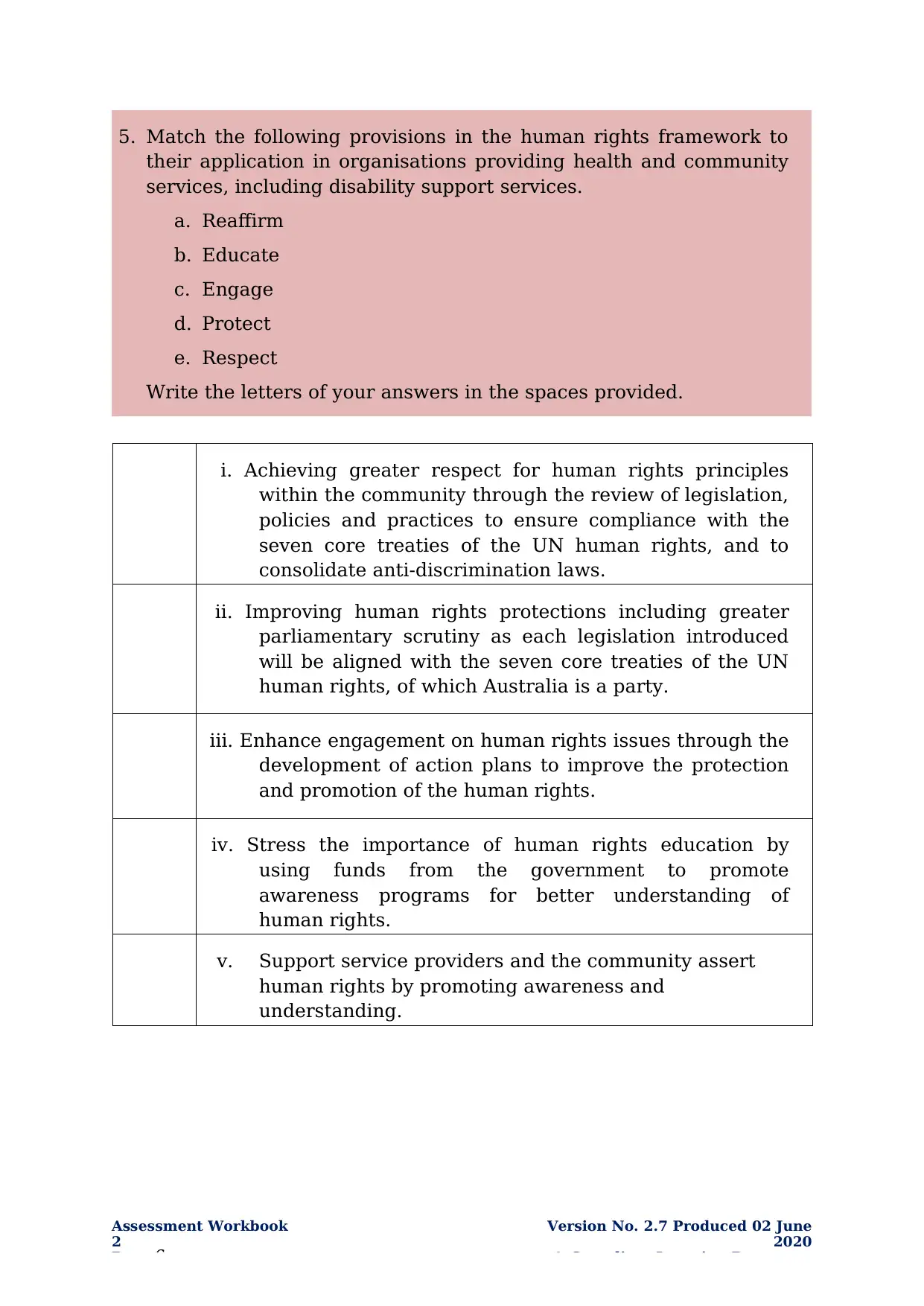
2
Page 6
Version No. 2.7 Produced 02 June
2020
© Compliant Learning Resources
i. Achieving greater respect for human rights principles
within the community through the review of legislation,
policies and practices to ensure compliance with the
seven core treaties of the UN human rights, and to
consolidate anti-discrimination laws.
ii. Improving human rights protections including greater
parliamentary scrutiny as each legislation introduced
will be aligned with the seven core treaties of the UN
human rights, of which Australia is a party.
iii. Enhance engagement on human rights issues through the
development of action plans to improve the protection
and promotion of the human rights.
iv. Stress the importance of human rights education by
using funds from the government to promote
awareness programs for better understanding of
human rights.
v. Support service providers and the community assert
human rights by promoting awareness and
understanding.
5. Match the following provisions in the human rights framework to
their application in organisations providing health and community
services, including disability support services.
a. Reaffirm
b. Educate
c. Engage
d. Protect
e. Respect
Write the letters of your answers in the spaces provided.
You're viewing a preview
Unlock full access by subscribing today!
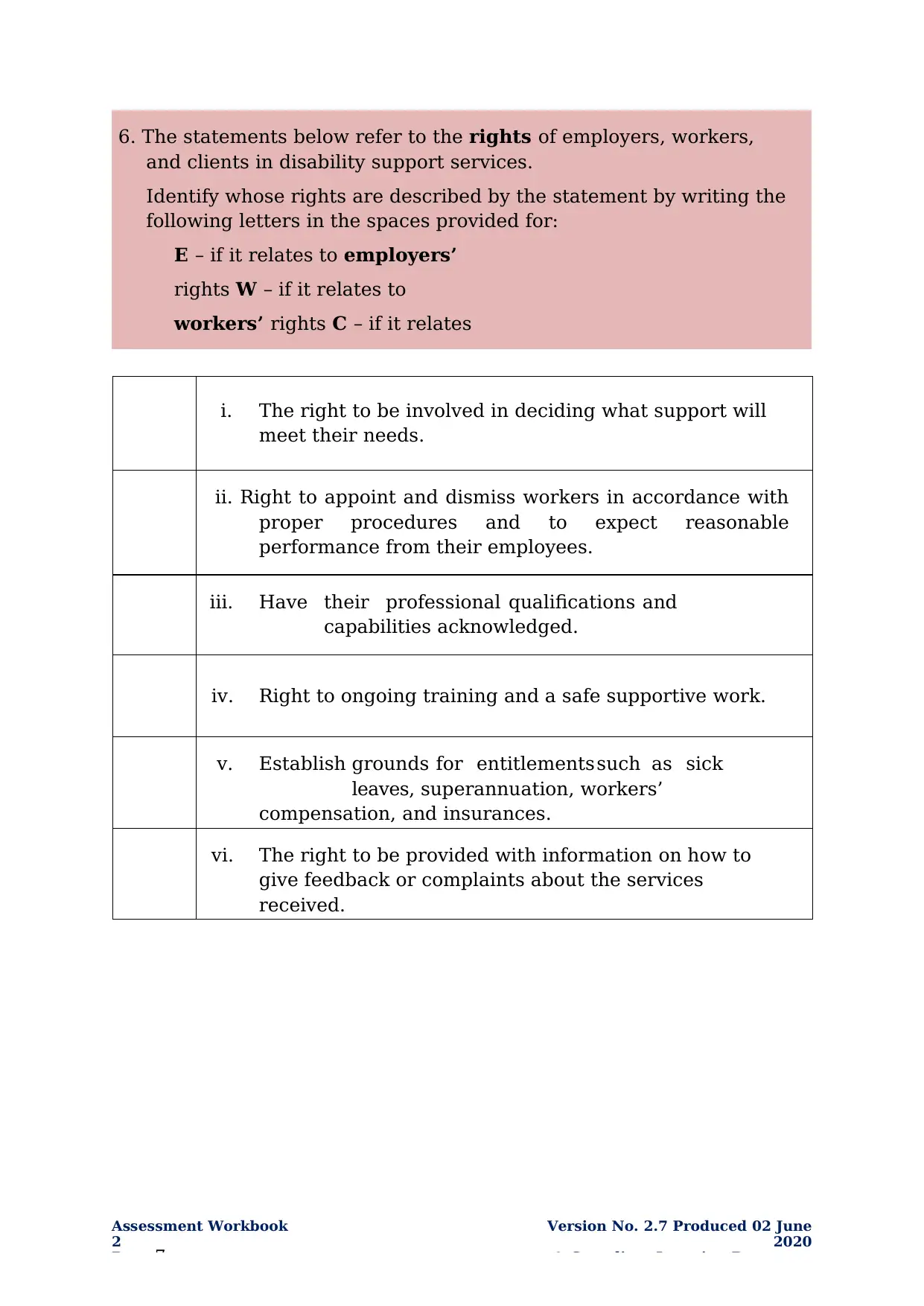
2
Page 7
Version No. 2.7 Produced 02 June
2020
© Compliant Learning Resources
i. The right to be involved in deciding what support will
meet their needs.
ii. Right to appoint and dismiss workers in accordance with
proper procedures and to expect reasonable
performance from their employees.
iii. Have their professional qualifications and
capabilities acknowledged.
iv. Right to ongoing training and a safe supportive work.
v. Establish grounds for entitlementssuch as sick
leaves, superannuation, workers’
compensation, and insurances.
vi. The right to be provided with information on how to
give feedback or complaints about the services
received.
6. The statements below refer to the rights of employers, workers,
and clients in disability support services.
Identify whose rights are described by the statement by writing the
following letters in the spaces provided for:
E – if it relates to employers’
rights W – if it relates to
workers’ rights C – if it relates
to clients’ rights
Paraphrase This Document
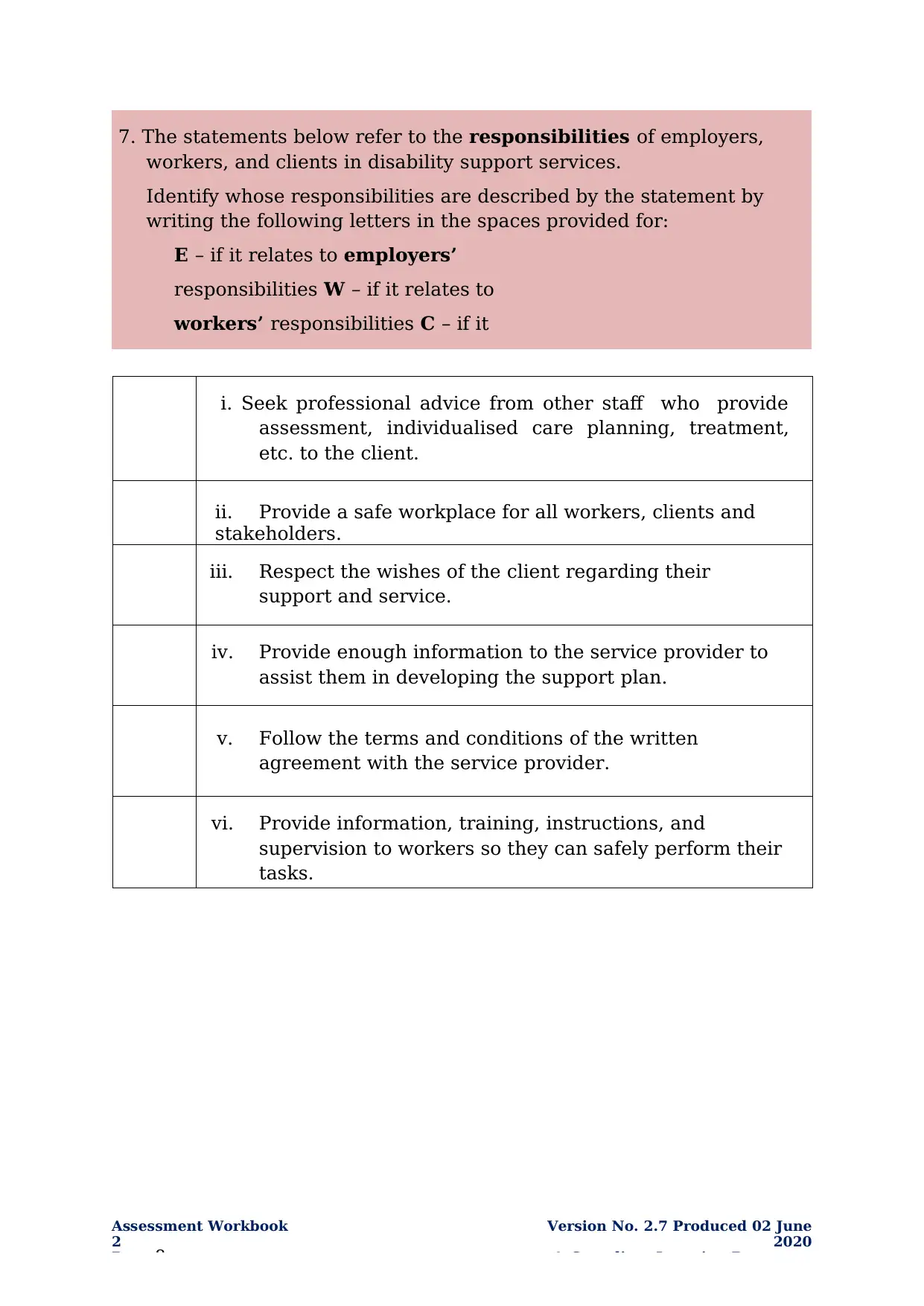
2
Page 8
Version No. 2.7 Produced 02 June
2020
© Compliant Learning Resources
i. Seek professional advice from other staff who provide
assessment, individualised care planning, treatment,
etc. to the client.
ii. Provide a safe workplace for all workers, clients and
stakeholders.
iii. Respect the wishes of the client regarding their
support and service.
iv. Provide enough information to the service provider to
assist them in developing the support plan.
v. Follow the terms and conditions of the written
agreement with the service provider.
vi. Provide information, training, instructions, and
supervision to workers so they can safely perform their
tasks.
7. The statements below refer to the responsibilities of employers,
workers, and clients in disability support services.
Identify whose responsibilities are described by the statement by
writing the following letters in the spaces provided for:
E – if it relates to employers’
responsibilities W – if it relates to
workers’ responsibilities C – if it
relates to clients’ responsibilities
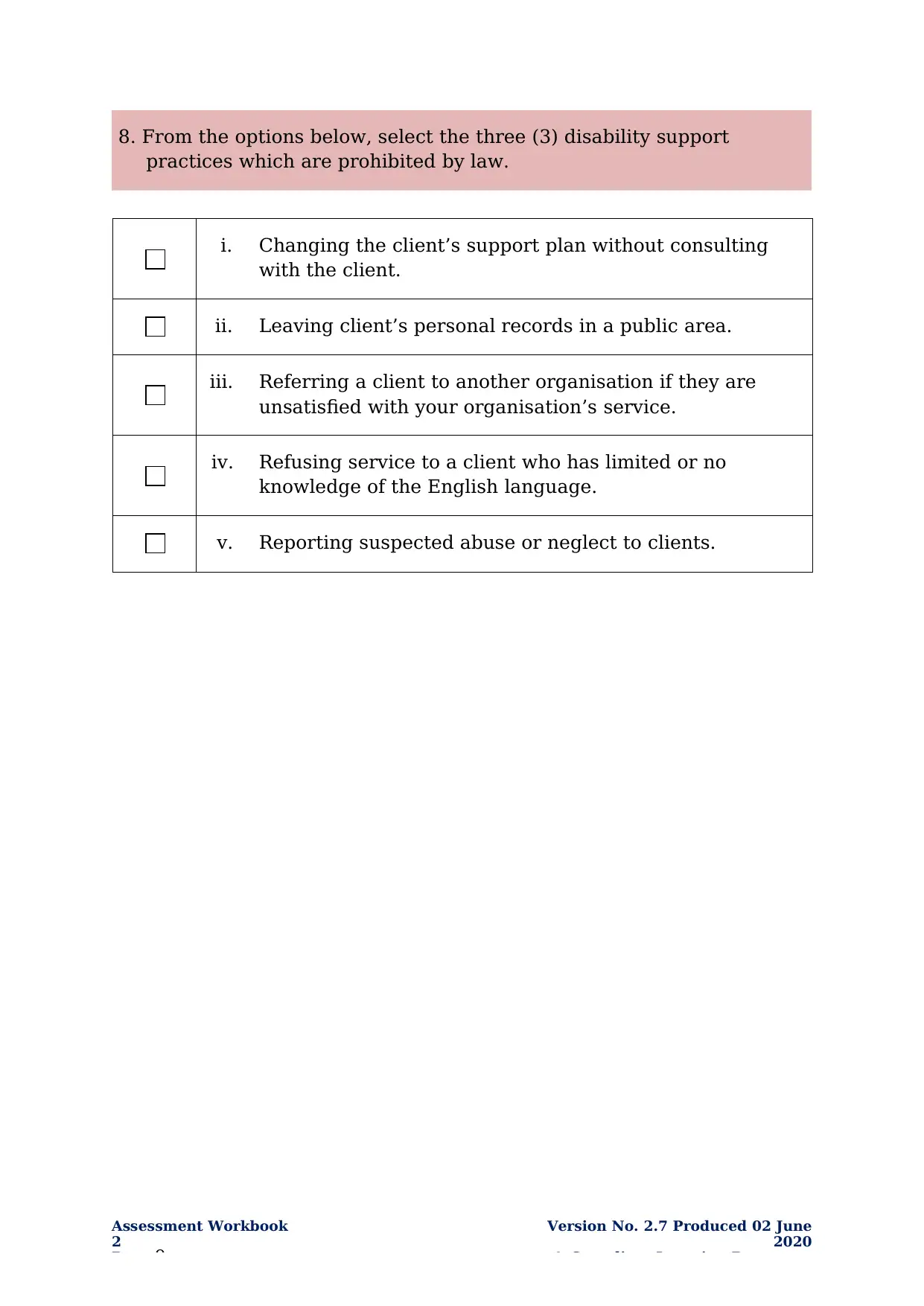
2
Page 9
Version No. 2.7 Produced 02 June
2020
© Compliant Learning Resources
i. Changing the client’s support plan without consulting
with the client.
ii. Leaving client’s personal records in a public area.
iii. Referring a client to another organisation if they are
unsatisfied with your organisation’s service.
iv. Refusing service to a client who has limited or no
knowledge of the English language.
v. Reporting suspected abuse or neglect to clients.
8. From the options below, select the three (3) disability support
practices which are prohibited by law.
You're viewing a preview
Unlock full access by subscribing today!
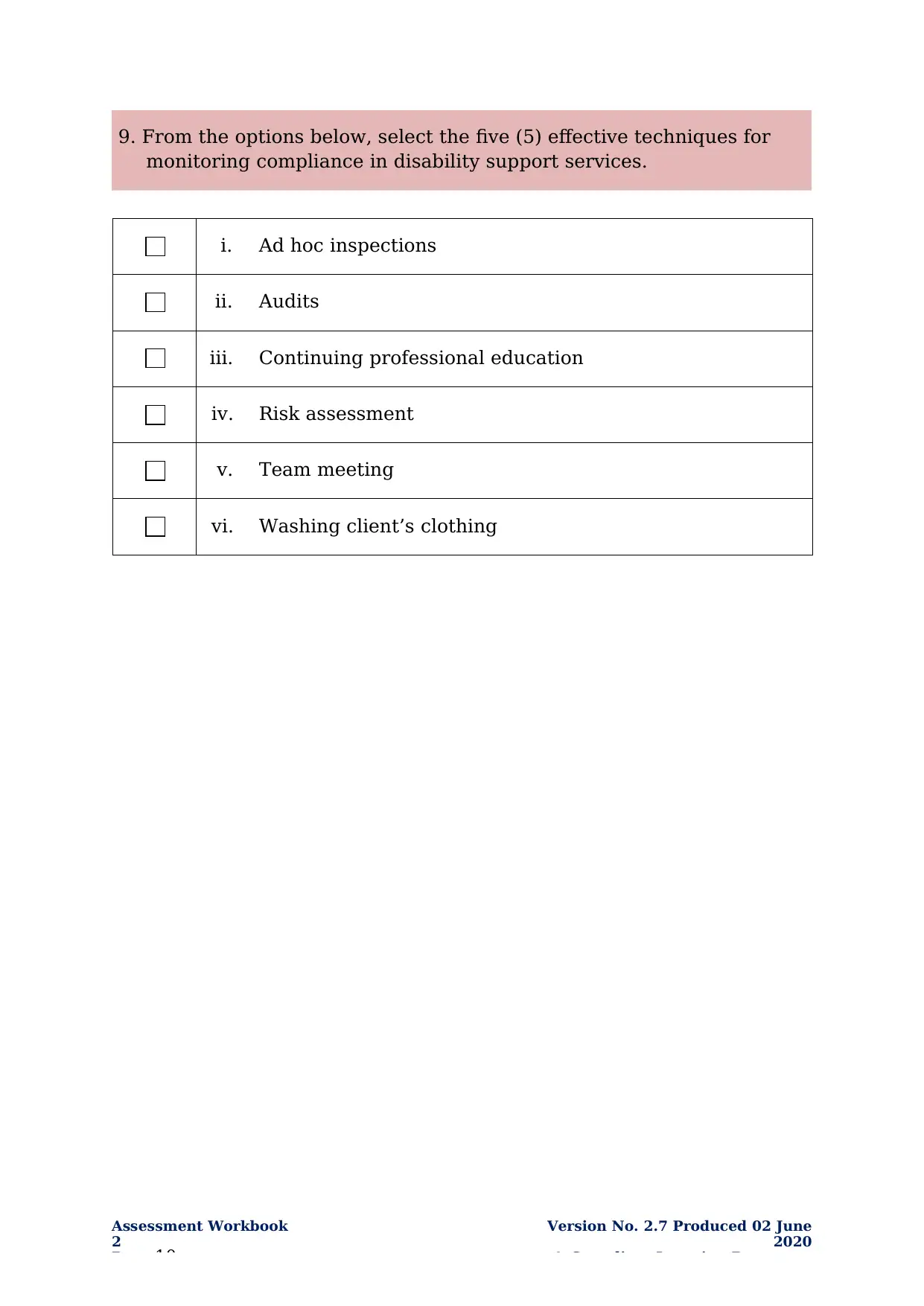
2
Page 10
Version No. 2.7 Produced 02 June
2020
© Compliant Learning Resources
i. Ad hoc inspections
ii. Audits
iii. Continuing professional education
iv. Risk assessment
v. Team meeting
vi. Washing client’s clothing
9. From the options below, select the five (5) effective techniques for
monitoring compliance in disability support services.
Paraphrase This Document
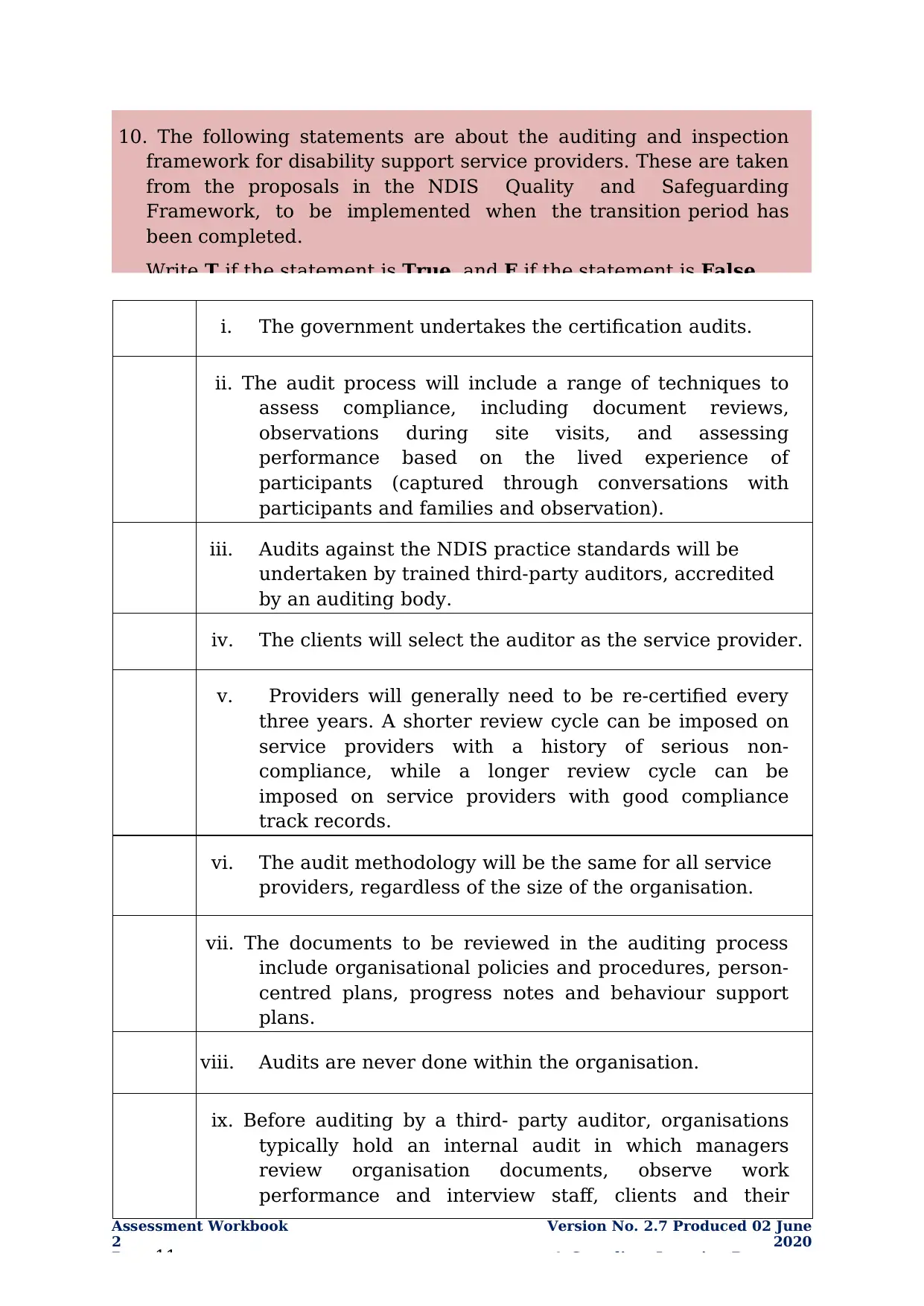
2
Page 11
Version No. 2.7 Produced 02 June
2020
© Compliant Learning Resources
i. The government undertakes the certification audits.
ii. The audit process will include a range of techniques to
assess compliance, including document reviews,
observations during site visits, and assessing
performance based on the lived experience of
participants (captured through conversations with
participants and families and observation).
iii. Audits against the NDIS practice standards will be
undertaken by trained third-party auditors, accredited
by an auditing body.
iv. The clients will select the auditor as the service provider.
v. Providers will generally need to be re-certified every
three years. A shorter review cycle can be imposed on
service providers with a history of serious non-
compliance, while a longer review cycle can be
imposed on service providers with good compliance
track records.
vi. The audit methodology will be the same for all service
providers, regardless of the size of the organisation.
vii. The documents to be reviewed in the auditing process
include organisational policies and procedures, person-
centred plans, progress notes and behaviour support
plans.
viii. Audits are never done within the organisation.
ix. Before auditing by a third- party auditor, organisations
typically hold an internal audit in which managers
review organisation documents, observe work
performance and interview staff, clients and their
10. The following statements are about the auditing and inspection
framework for disability support service providers. These are taken
from the proposals in the NDIS Quality and Safeguarding
Framework, to be implemented when the transition period has
been completed.
Write T if the statement is True, and F if the statement is False.
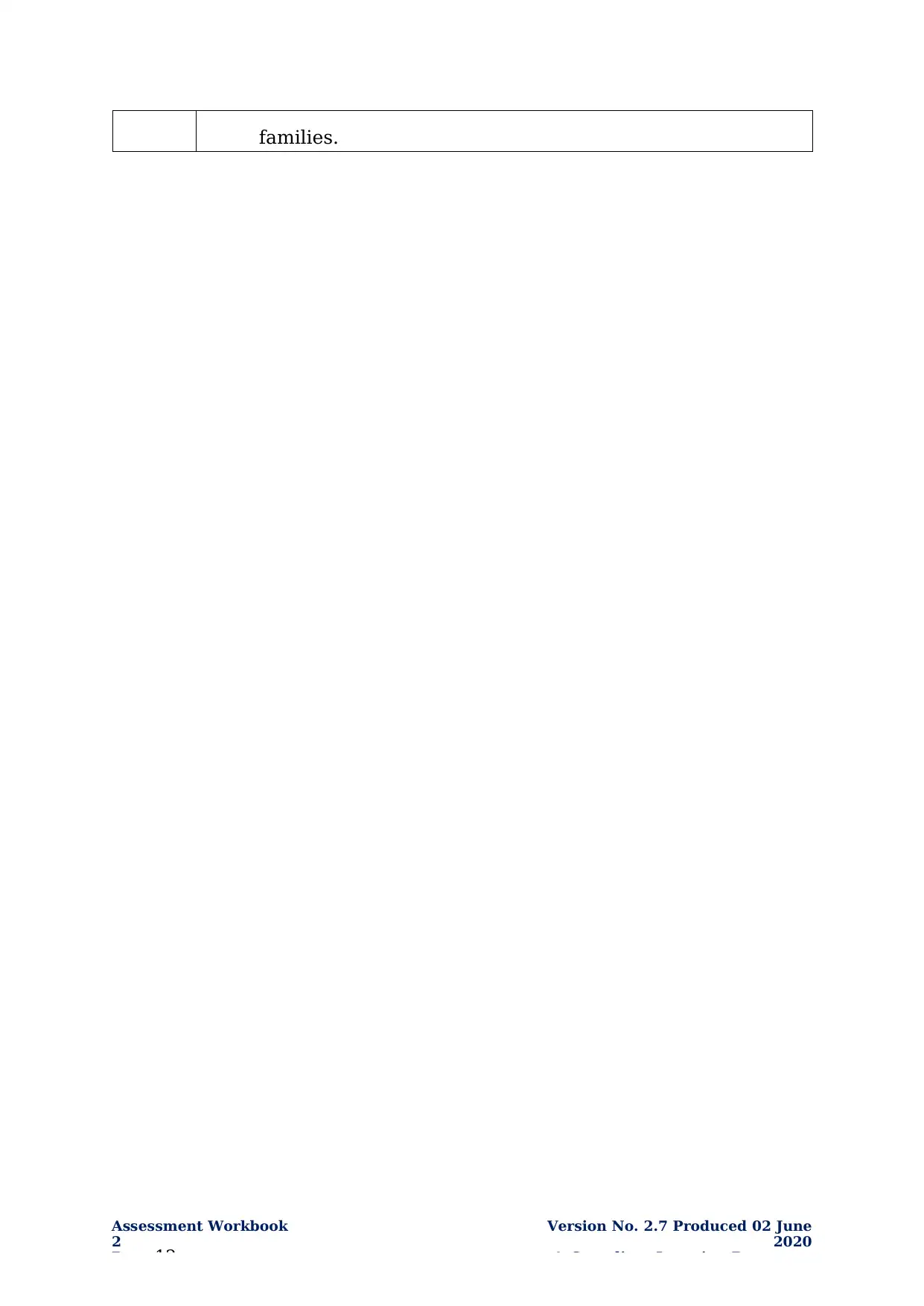
2
Page 12
Version No. 2.7 Produced 02 June
2020
© Compliant Learning Resources
families.
You're viewing a preview
Unlock full access by subscribing today!
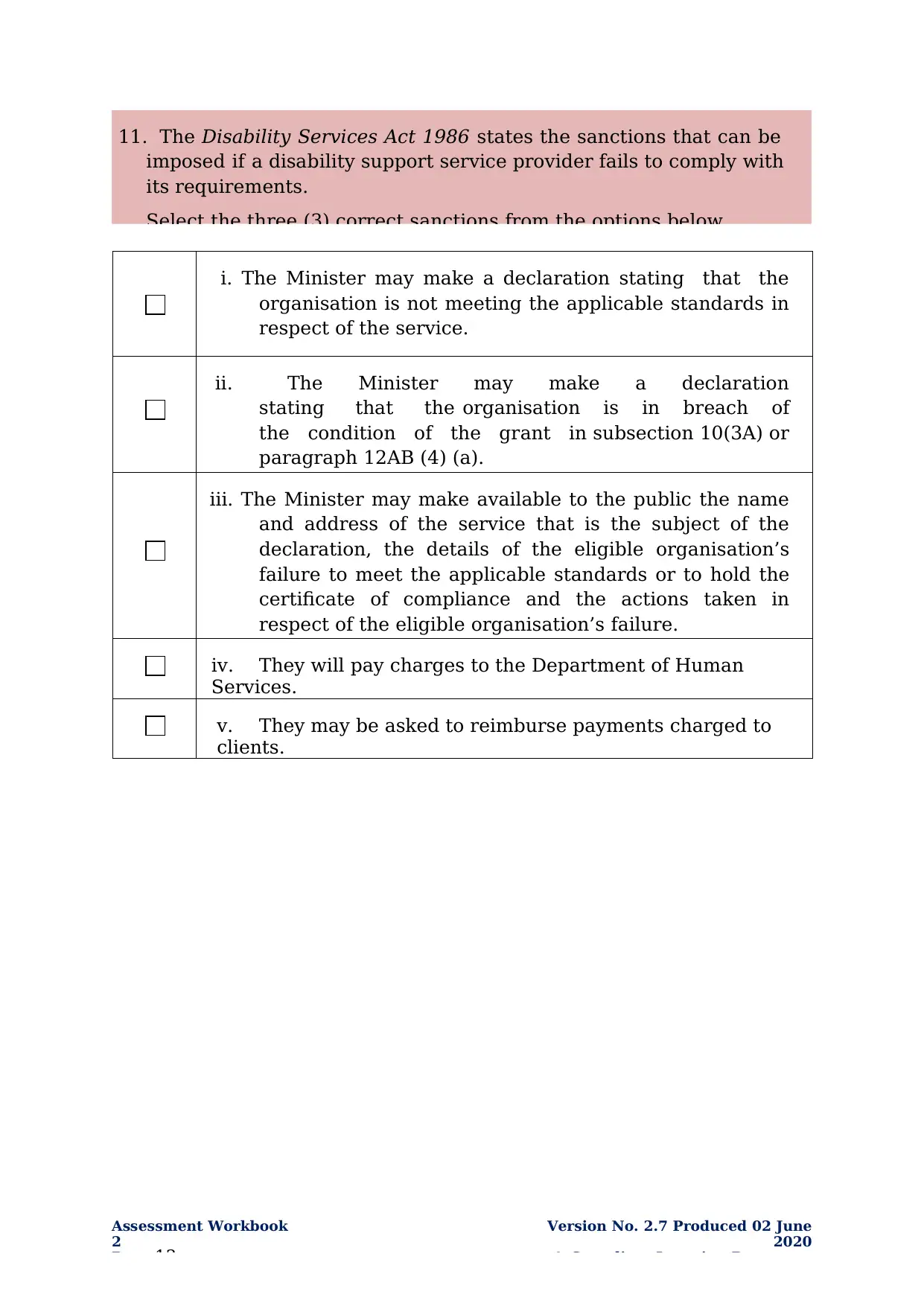
2
Page 13
Version No. 2.7 Produced 02 June
2020
© Compliant Learning Resources
i. The Minister may make a declaration stating that the
organisation is not meeting the applicable standards in
respect of the service.
ii. The Minister may make a declaration
stating that the organisation is in breach of
the condition of the grant in subsection 10(3A) or
paragraph 12AB (4) (a).
iii. The Minister may make available to the public the name
and address of the service that is the subject of the
declaration, the details of the eligible organisation’s
failure to meet the applicable standards or to hold the
certificate of compliance and the actions taken in
respect of the eligible organisation’s failure.
iv. They will pay charges to the Department of Human
Services.
v. They may be asked to reimburse payments charged to
clients.
11. The Disability Services Act 1986 states the sanctions that can be
imposed if a disability support service provider fails to comply with
its requirements.
Select the three (3) correct sanctions from the options below.
Paraphrase This Document
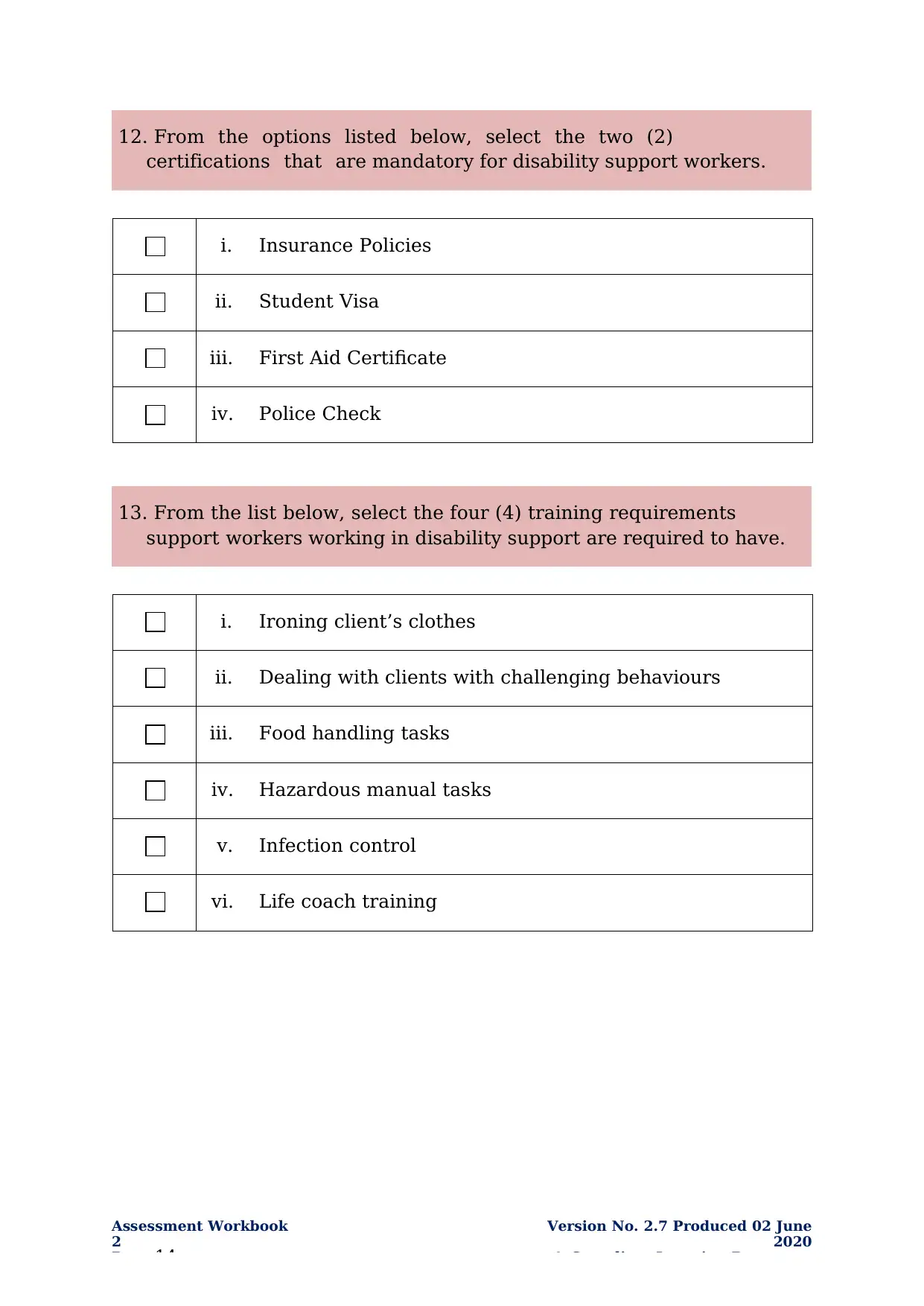
2
Page 14
Version No. 2.7 Produced 02 June
2020
© Compliant Learning Resources
i. Insurance Policies
ii. Student Visa
iii. First Aid Certificate
iv. Police Check
i. Ironing client’s clothes
ii. Dealing with clients with challenging behaviours
iii. Food handling tasks
iv. Hazardous manual tasks
v. Infection control
vi. Life coach training
13. From the list below, select the four (4) training requirements
support workers working in disability support are required to have.
12. From the options listed below, select the two (2)
certifications that are mandatory for disability support workers.
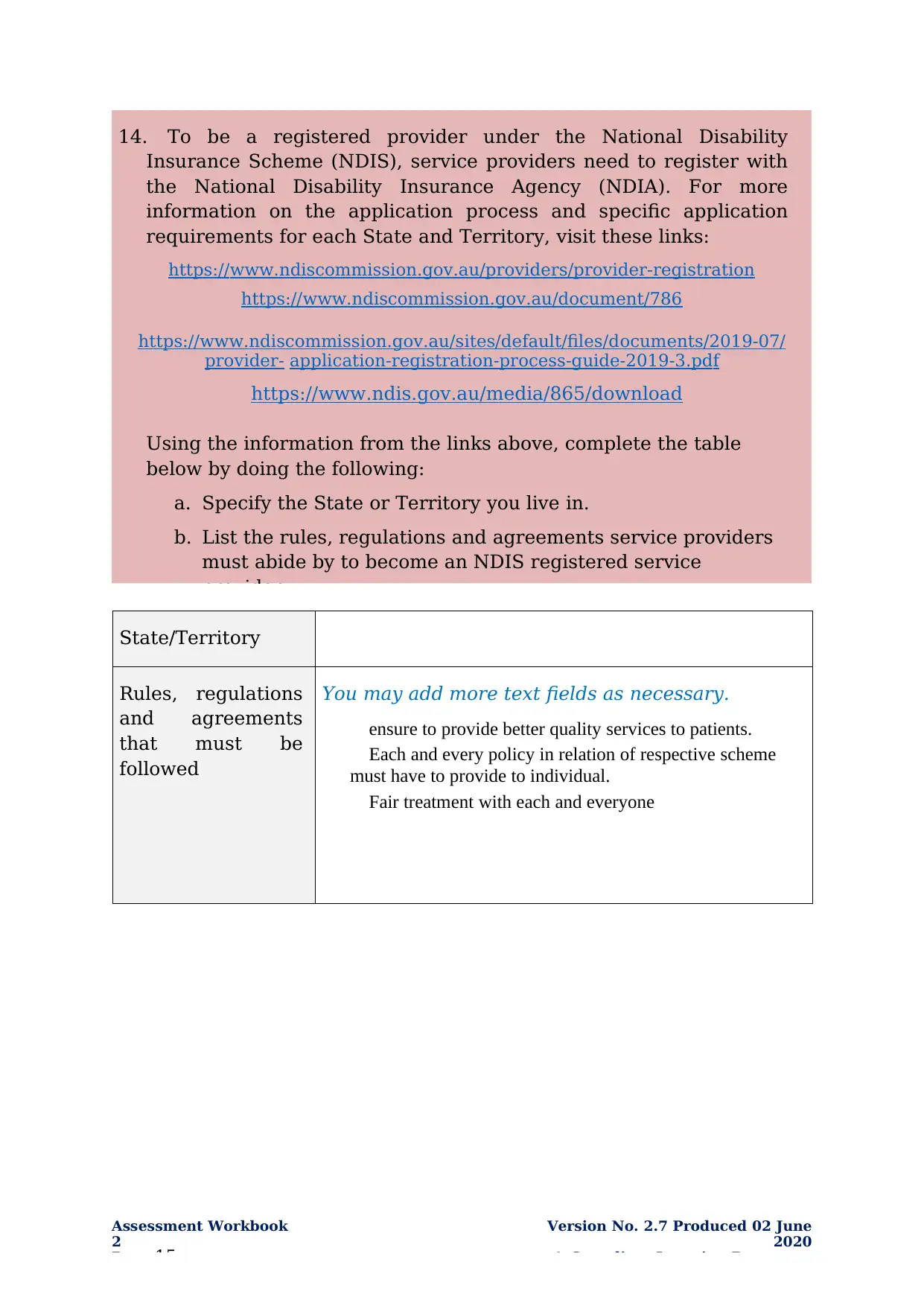
2
Page 15
Version No. 2.7 Produced 02 June
2020
© Compliant Learning Resources
State/Territory
Rules, regulations
and agreements
that must be
followed
You may add more text fields as necessary.
ensure to provide better quality services to patients.
Each and every policy in relation of respective scheme
must have to provide to individual.
Fair treatment with each and everyone
14. To be a registered provider under the National Disability
Insurance Scheme (NDIS), service providers need to register with
the National Disability Insurance Agency (NDIA). For more
information on the application process and specific application
requirements for each State and Territory, visit these links:
https://www.ndiscommission.gov.au/providers/provider-registration
https://www.ndiscommission.gov.au/document/786
https://www.ndiscommission.gov.au/sites/default/files/documents/2019-07/
provider- application-registration-process-guide-2019-3.pdf
https://www.ndis.gov.au/media/865/download
Using the information from the links above, complete the table
below by doing the following:
a. Specify the State or Territory you live in.
b. List the rules, regulations and agreements service providers
must abide by to become an NDIS registered service
provider.
You're viewing a preview
Unlock full access by subscribing today!
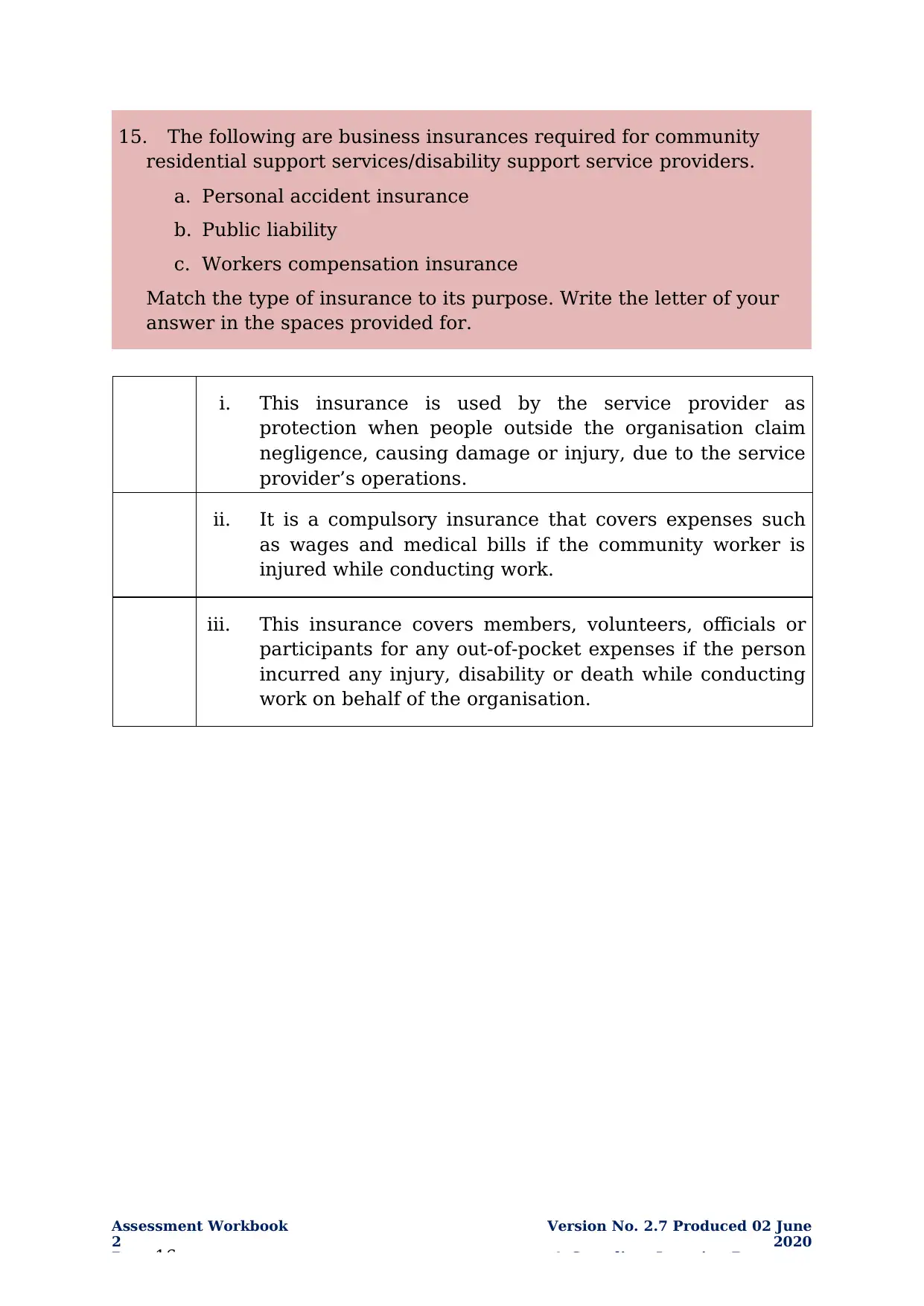
2
Page 16
Version No. 2.7 Produced 02 June
2020
© Compliant Learning Resources
i. This insurance is used by the service provider as
protection when people outside the organisation claim
negligence, causing damage or injury, due to the service
provider’s operations.
ii. It is a compulsory insurance that covers expenses such
as wages and medical bills if the community worker is
injured while conducting work.
iii. This insurance covers members, volunteers, officials or
participants for any out-of-pocket expenses if the person
incurred any injury, disability or death while conducting
work on behalf of the organisation.
15. The following are business insurances required for community
residential support services/disability support service providers.
a. Personal accident insurance
b. Public liability
c. Workers compensation insurance
Match the type of insurance to its purpose. Write the letter of your
answer in the spaces provided for.
Paraphrase This Document
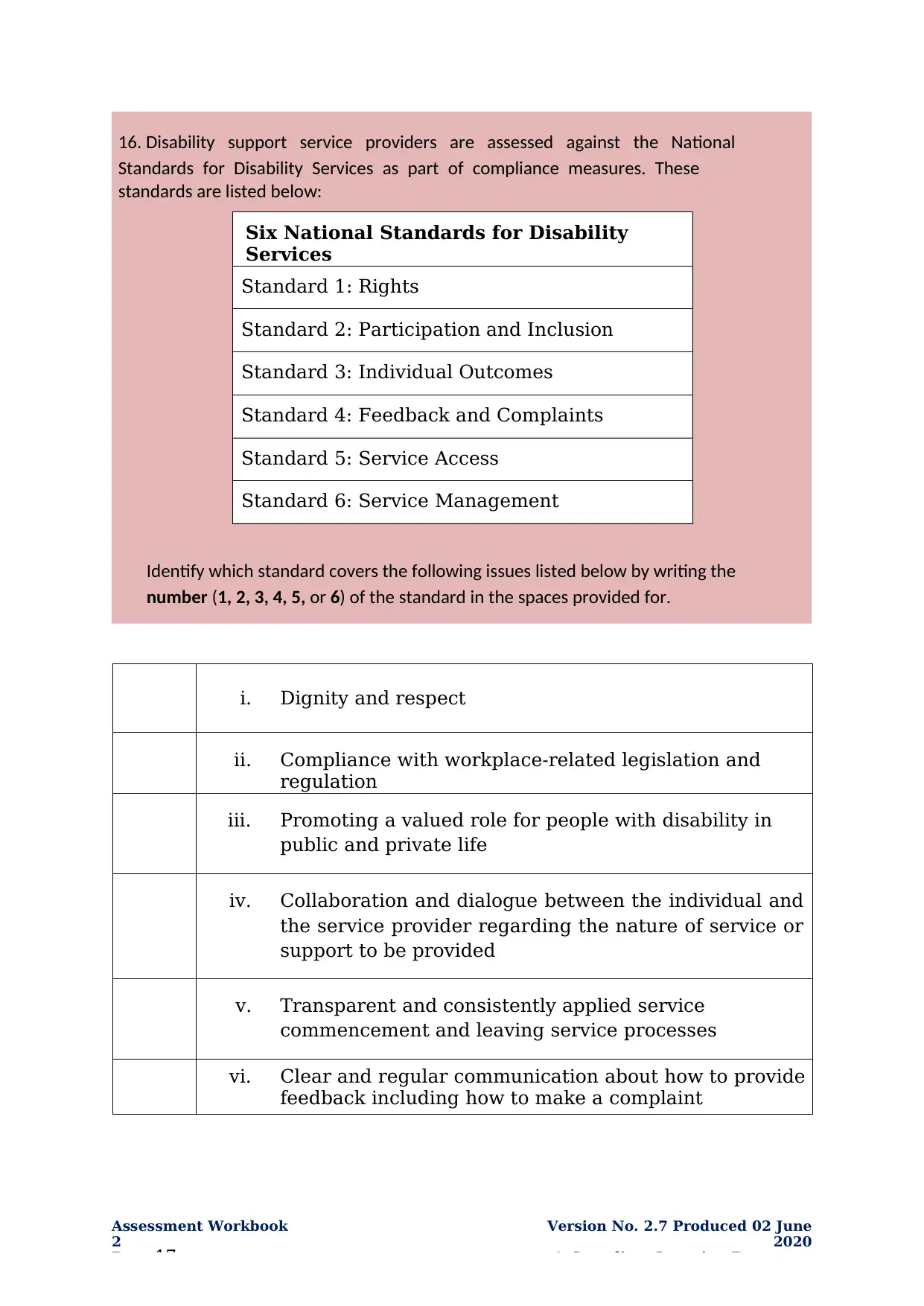
Standards for Disability Services as part of compliance measures. These
standards are listed below:
Identify which standard covers the following issues listed below by writing the
number (1, 2, 3, 4, 5, or 6) of the standard in the spaces provided for.
Assessment Workbook
2
Page 17
Version No. 2.7 Produced 02 June
2020
© Compliant Learning Resources
Six National Standards for Disability
Services
Standard 1: Rights
Standard 2: Participation and Inclusion
Standard 3: Individual Outcomes
Standard 4: Feedback and Complaints
Standard 5: Service Access
Standard 6: Service Management
i. Dignity and respect
ii. Compliance with workplace-related legislation and
regulation
iii. Promoting a valued role for people with disability in
public and private life
iv. Collaboration and dialogue between the individual and
the service provider regarding the nature of service or
support to be provided
v. Transparent and consistently applied service
commencement and leaving service processes
vi. Clear and regular communication about how to provide
feedback including how to make a complaint
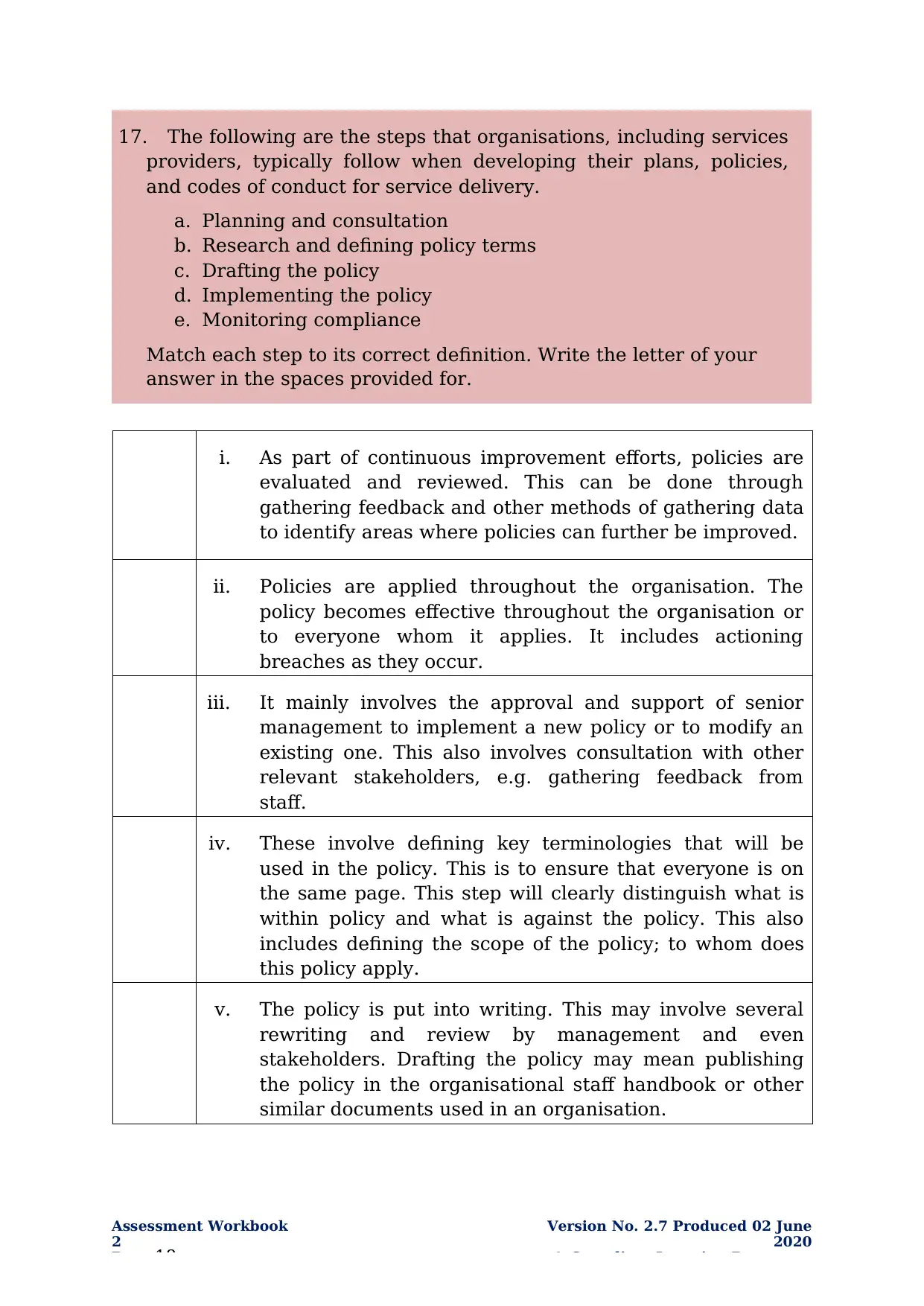
2
Page 18
Version No. 2.7 Produced 02 June
2020
© Compliant Learning Resources
i. As part of continuous improvement efforts, policies are
evaluated and reviewed. This can be done through
gathering feedback and other methods of gathering data
to identify areas where policies can further be improved.
ii. Policies are applied throughout the organisation. The
policy becomes effective throughout the organisation or
to everyone whom it applies. It includes actioning
breaches as they occur.
iii. It mainly involves the approval and support of senior
management to implement a new policy or to modify an
existing one. This also involves consultation with other
relevant stakeholders, e.g. gathering feedback from
staff.
iv. These involve defining key terminologies that will be
used in the policy. This is to ensure that everyone is on
the same page. This step will clearly distinguish what is
within policy and what is against the policy. This also
includes defining the scope of the policy; to whom does
this policy apply.
v. The policy is put into writing. This may involve several
rewriting and review by management and even
stakeholders. Drafting the policy may mean publishing
the policy in the organisational staff handbook or other
similar documents used in an organisation.
17. The following are the steps that organisations, including services
providers, typically follow when developing their plans, policies,
and codes of conduct for service delivery.
a. Planning and consultation
b. Research and defining policy terms
c. Drafting the policy
d. Implementing the policy
e. Monitoring compliance
Match each step to its correct definition. Write the letter of your
answer in the spaces provided for.
You're viewing a preview
Unlock full access by subscribing today!
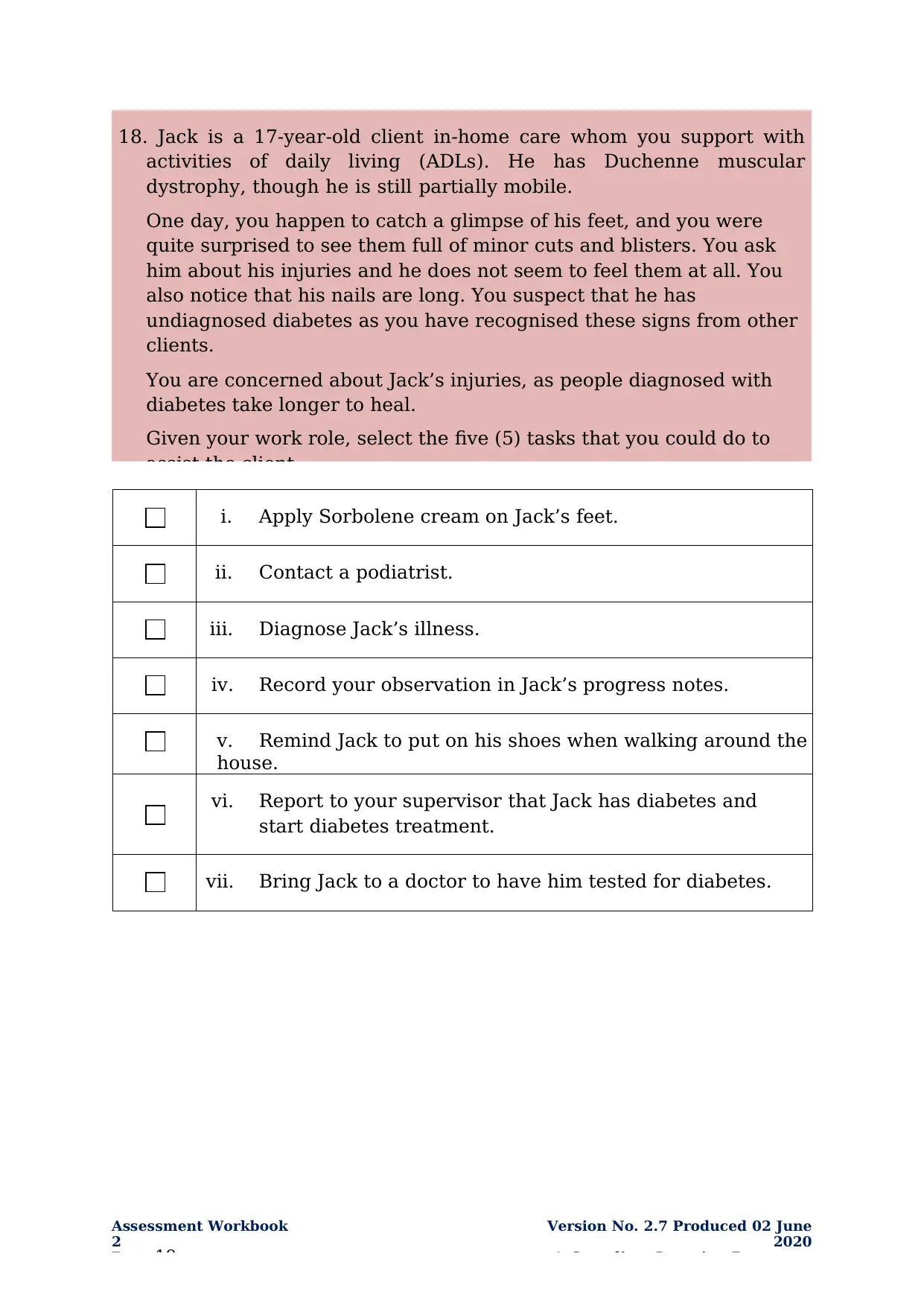
2
Page 19
Version No. 2.7 Produced 02 June
2020
© Compliant Learning Resources
i. Apply Sorbolene cream on Jack’s feet.
ii. Contact a podiatrist.
iii. Diagnose Jack’s illness.
iv. Record your observation in Jack’s progress notes.
v. Remind Jack to put on his shoes when walking around the
house.
vi. Report to your supervisor that Jack has diabetes and
start diabetes treatment.
vii. Bring Jack to a doctor to have him tested for diabetes.
18. Jack is a 17-year-old client in-home care whom you support with
activities of daily living (ADLs). He has Duchenne muscular
dystrophy, though he is still partially mobile.
One day, you happen to catch a glimpse of his feet, and you were
quite surprised to see them full of minor cuts and blisters. You ask
him about his injuries and he does not seem to feel them at all. You
also notice that his nails are long. You suspect that he has
undiagnosed diabetes as you have recognised these signs from other
clients.
You are concerned about Jack’s injuries, as people diagnosed with
diabetes take longer to heal.
Given your work role, select the five (5) tasks that you could do to
assist the client.
Paraphrase This Document
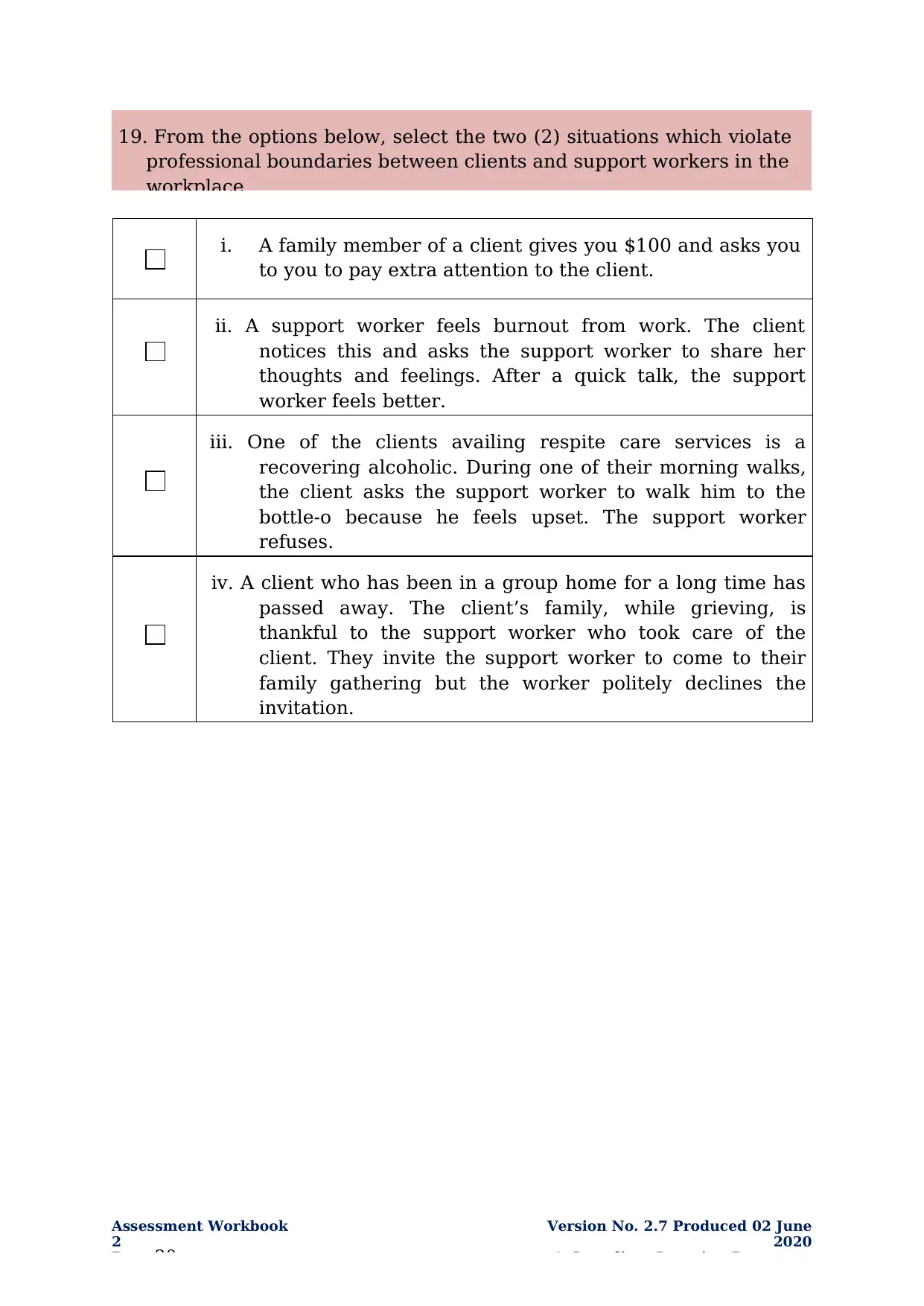
2
Page 20
Version No. 2.7 Produced 02 June
2020
© Compliant Learning Resources
i. A family member of a client gives you $100 and asks you
to you to pay extra attention to the client.
ii. A support worker feels burnout from work. The client
notices this and asks the support worker to share her
thoughts and feelings. After a quick talk, the support
worker feels better.
iii. One of the clients availing respite care services is a
recovering alcoholic. During one of their morning walks,
the client asks the support worker to walk him to the
bottle-o because he feels upset. The support worker
refuses.
iv. A client who has been in a group home for a long time has
passed away. The client’s family, while grieving, is
thankful to the support worker who took care of the
client. They invite the support worker to come to their
family gathering but the worker politely declines the
invitation.
19. From the options below, select the two (2) situations which violate
professional boundaries between clients and support workers in the
workplace.
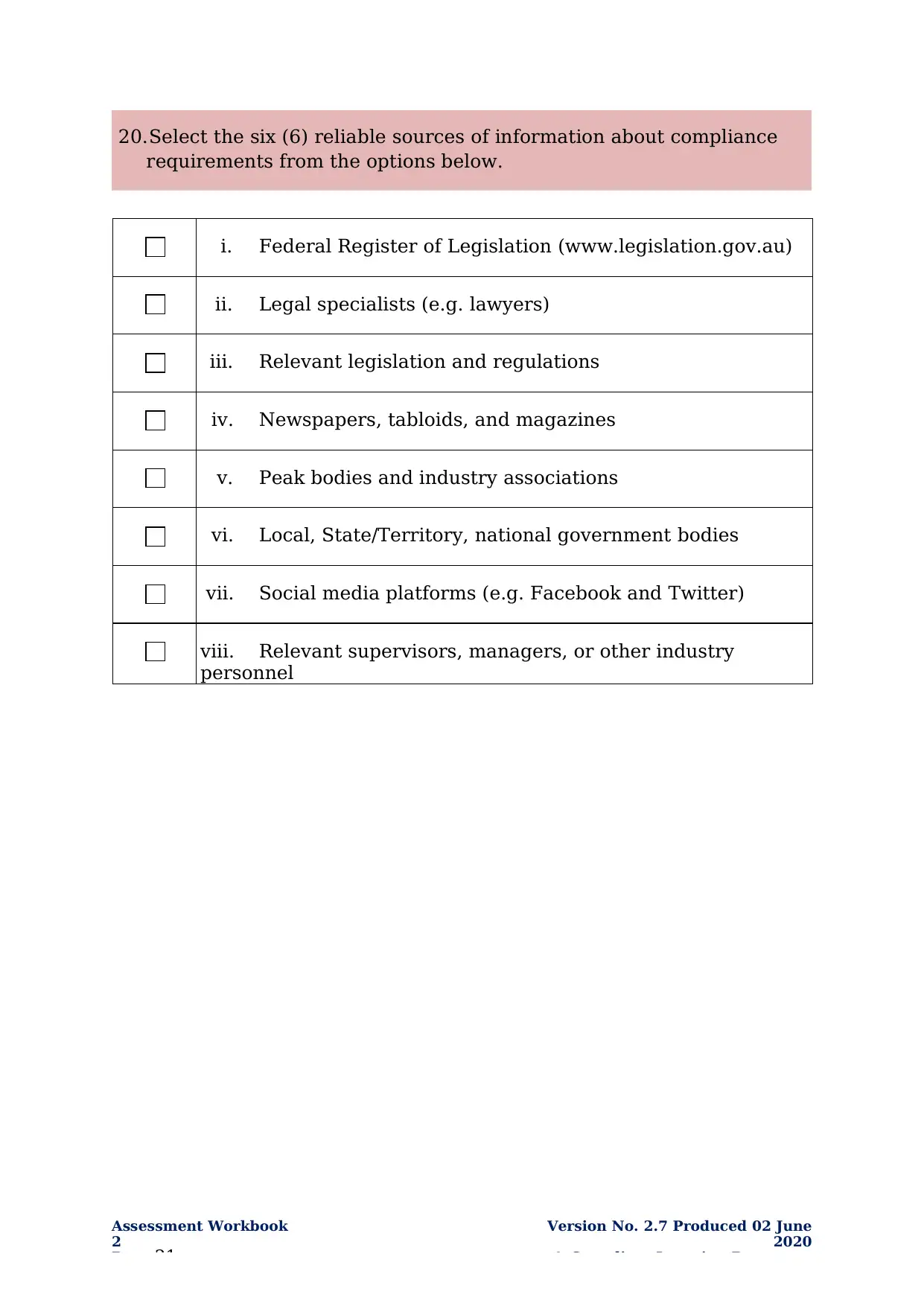
2
Page 21
Version No. 2.7 Produced 02 June
2020
© Compliant Learning Resources
i. Federal Register of Legislation (www.legislation.gov.au)
ii. Legal specialists (e.g. lawyers)
iii. Relevant legislation and regulations
iv. Newspapers, tabloids, and magazines
v. Peak bodies and industry associations
vi. Local, State/Territory, national government bodies
vii. Social media platforms (e.g. Facebook and Twitter)
viii. Relevant supervisors, managers, or other industry
personnel
20.Select the six (6) reliable sources of information about compliance
requirements from the options below.
You're viewing a preview
Unlock full access by subscribing today!
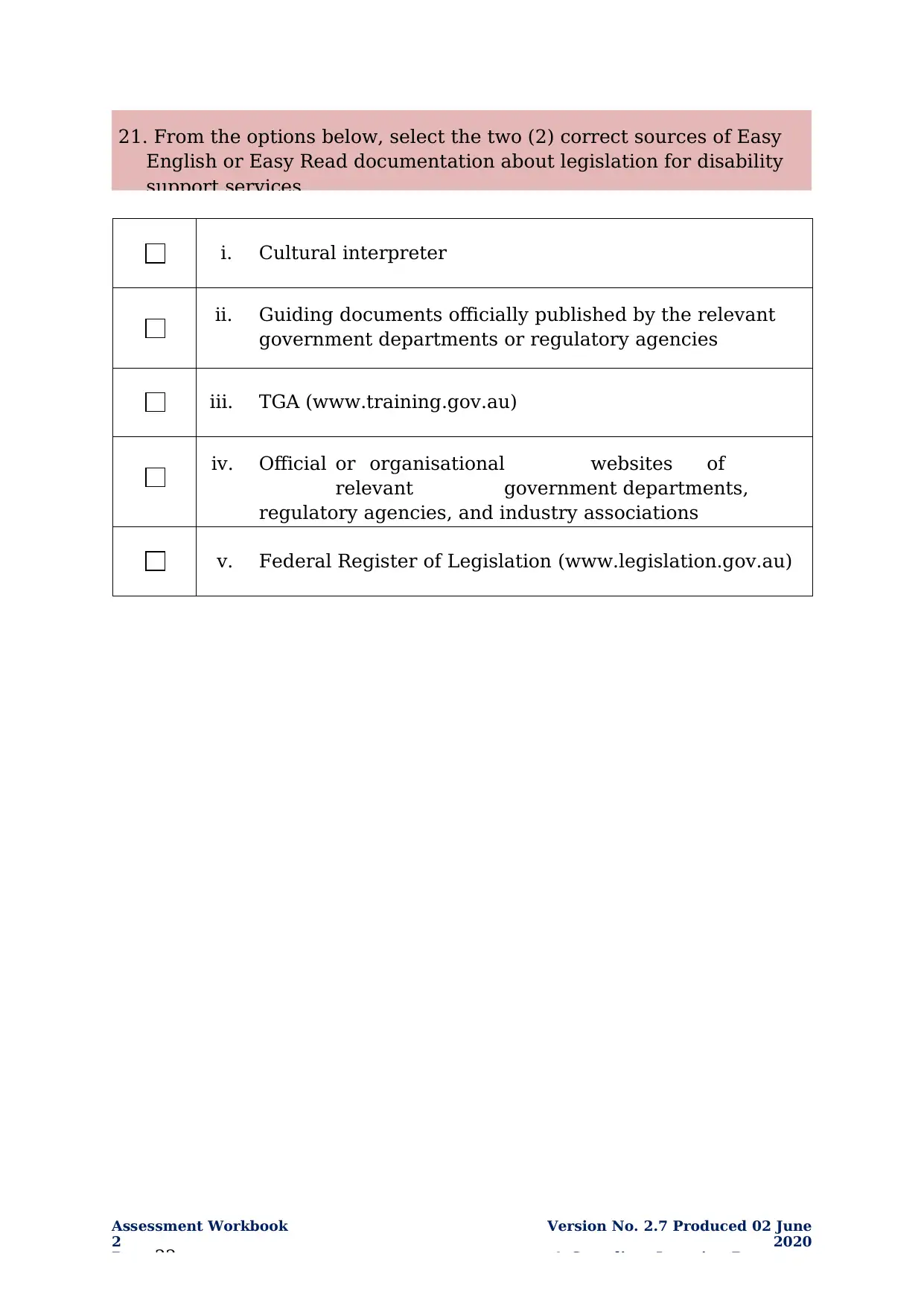
2
Page 22
Version No. 2.7 Produced 02 June
2020
© Compliant Learning Resources
i. Cultural interpreter
ii. Guiding documents officially published by the relevant
government departments or regulatory agencies
iii. TGA (www.training.gov.au)
iv. Official or organisational websites of
relevant government departments,
regulatory agencies, and industry associations
v. Federal Register of Legislation (www.legislation.gov.au)
21. From the options below, select the two (2) correct sources of Easy
English or Easy Read documentation about legislation for disability
support services.
Paraphrase This Document
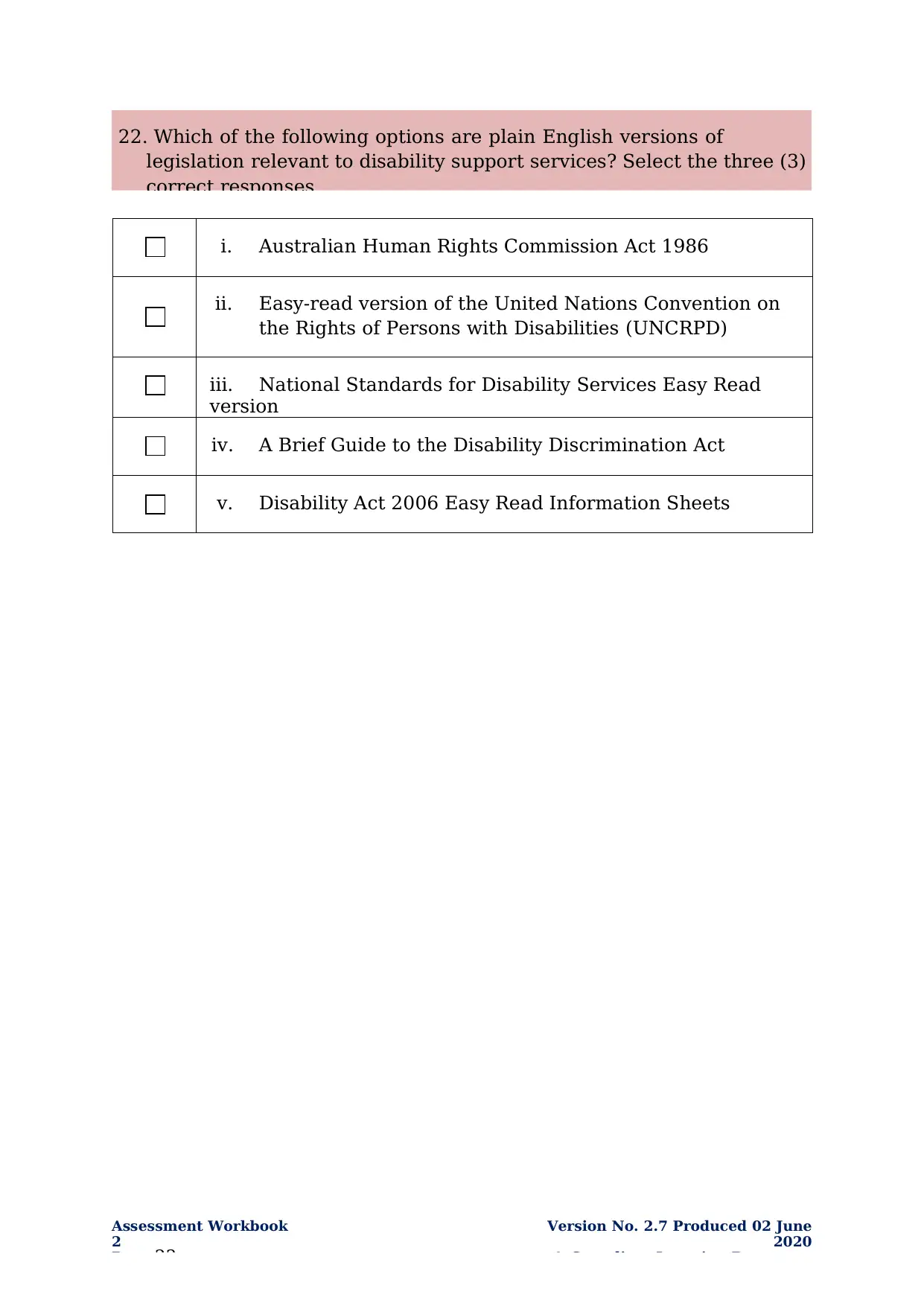
2
Page 23
Version No. 2.7 Produced 02 June
2020
© Compliant Learning Resources
i. Australian Human Rights Commission Act 1986
ii. Easy-read version of the United Nations Convention on
the Rights of Persons with Disabilities (UNCRPD)
iii. National Standards for Disability Services Easy Read
version
iv. A Brief Guide to the Disability Discrimination Act
v. Disability Act 2006 Easy Read Information Sheets
22. Which of the following options are plain English versions of
legislation relevant to disability support services? Select the three (3)
correct responses.

2
Page 24
Version No. 2.7 Produced 02 June
2020
© Compliant Learning Resources
a. Opening sentence:
What should my service do
b. What should my service do?
Your service should:
help patient in getting fast recovery
My services will provide assistance to disable person in managing there
activities by own.
Help disable person in becoming independent
23. Access the Easy English version of the National Standards for
Disability Services from this link:
National Standards for Disability
Services Answer the questions below.
a. Go to the chapter on Standard 3: Individual Outcomes, found
on page 18. Quote the opening sentence of the chapter.
b. Under the chapter on Standard 3: Individual Outcomes, you
will find a section titled “What should my service do?” Quote
the first three (3) bullet points listed there.
You're viewing a preview
Unlock full access by subscribing today!
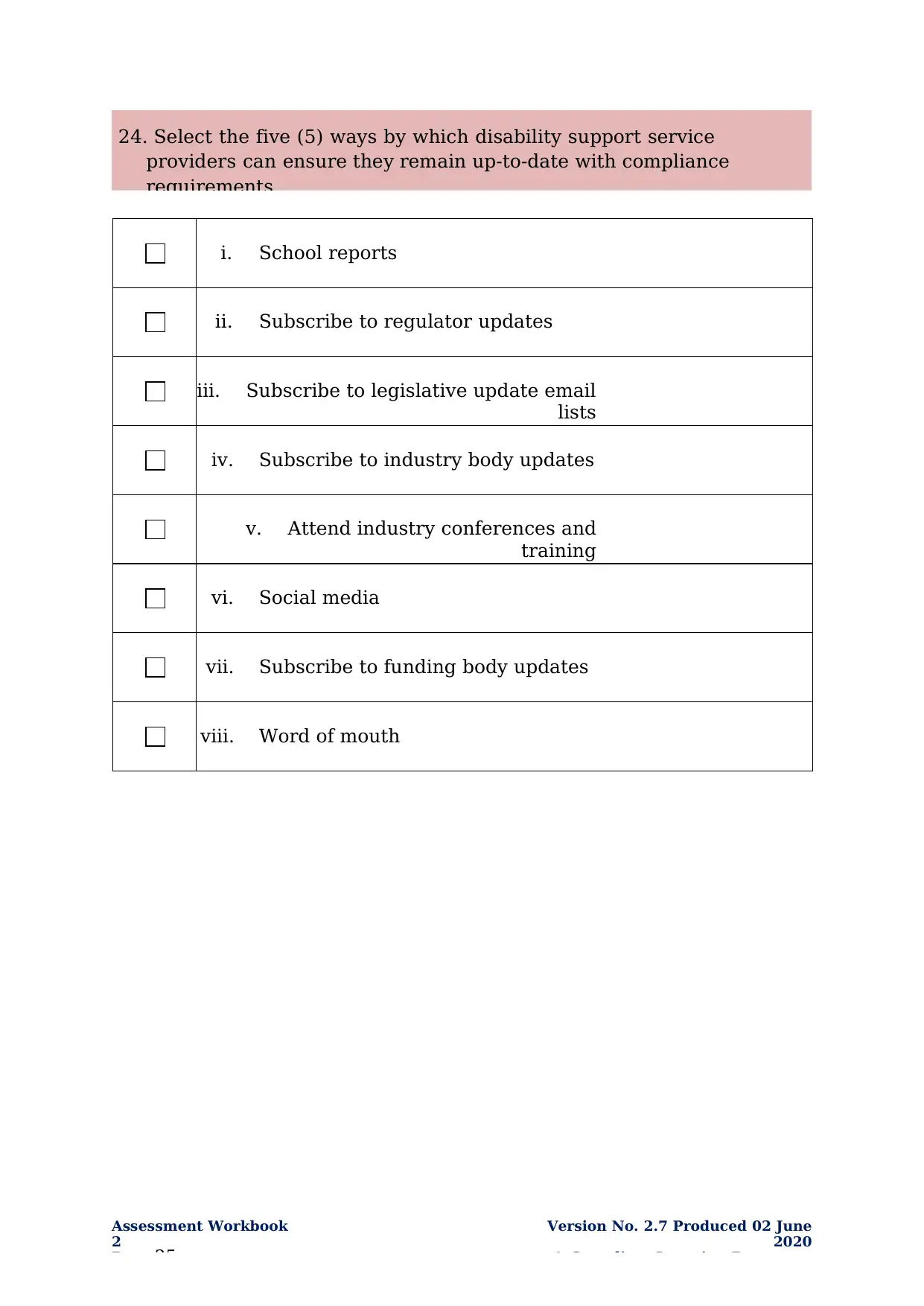
2
Page 25
Version No. 2.7 Produced 02 June
2020
© Compliant Learning Resources
i. School reports
ii. Subscribe to regulator updates
iii. Subscribe to legislative update email
lists
iv. Subscribe to industry body updates
v. Attend industry conferences and
training
vi. Social media
vii. Subscribe to funding body updates
viii. Word of mouth
24. Select the five (5) ways by which disability support service
providers can ensure they remain up-to-date with compliance
requirements.
Paraphrase This Document
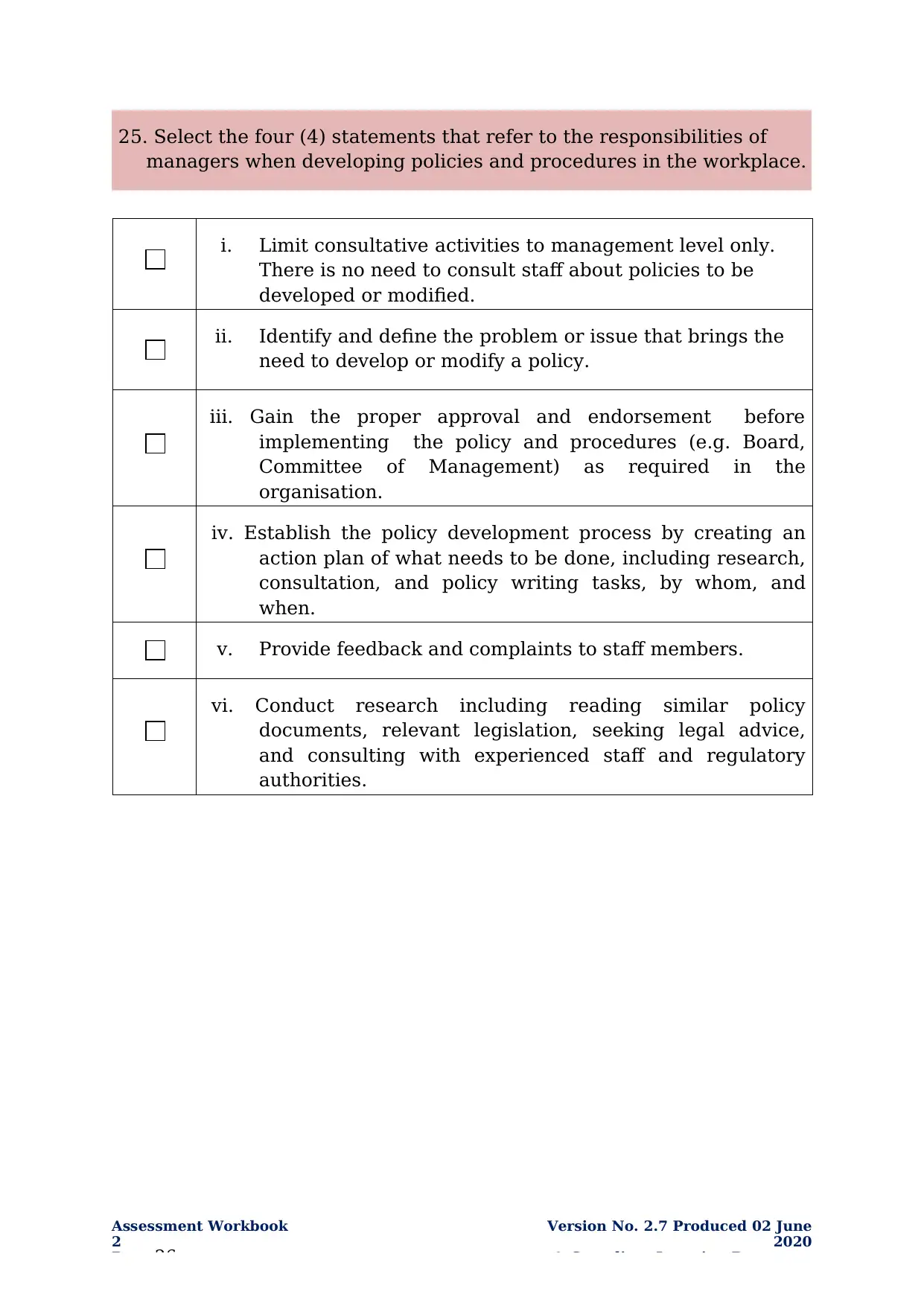
2
Page 26
Version No. 2.7 Produced 02 June
2020
© Compliant Learning Resources
i. Limit consultative activities to management level only.
There is no need to consult staff about policies to be
developed or modified.
ii. Identify and define the problem or issue that brings the
need to develop or modify a policy.
iii. Gain the proper approval and endorsement before
implementing the policy and procedures (e.g. Board,
Committee of Management) as required in the
organisation.
iv. Establish the policy development process by creating an
action plan of what needs to be done, including research,
consultation, and policy writing tasks, by whom, and
when.
v. Provide feedback and complaints to staff members.
vi. Conduct research including reading similar policy
documents, relevant legislation, seeking legal advice,
and consulting with experienced staff and regulatory
authorities.
25. Select the four (4) statements that refer to the responsibilities of
managers when developing policies and procedures in the workplace.
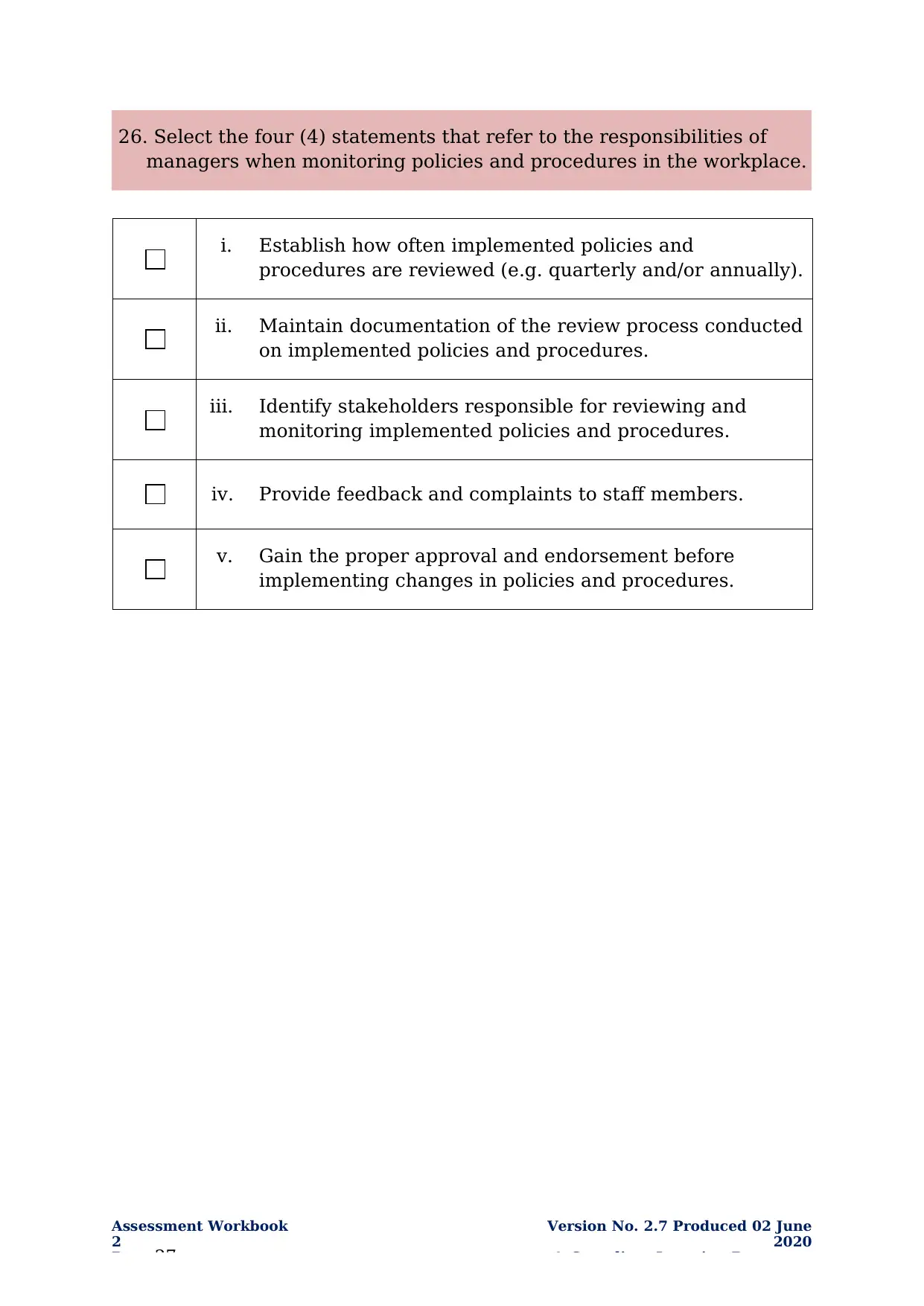
2
Page 27
Version No. 2.7 Produced 02 June
2020
© Compliant Learning Resources
i. Establish how often implemented policies and
procedures are reviewed (e.g. quarterly and/or annually).
ii. Maintain documentation of the review process conducted
on implemented policies and procedures.
iii. Identify stakeholders responsible for reviewing and
monitoring implemented policies and procedures.
iv. Provide feedback and complaints to staff members.
v. Gain the proper approval and endorsement before
implementing changes in policies and procedures.
26. Select the four (4) statements that refer to the responsibilities of
managers when monitoring policies and procedures in the workplace.
You're viewing a preview
Unlock full access by subscribing today!
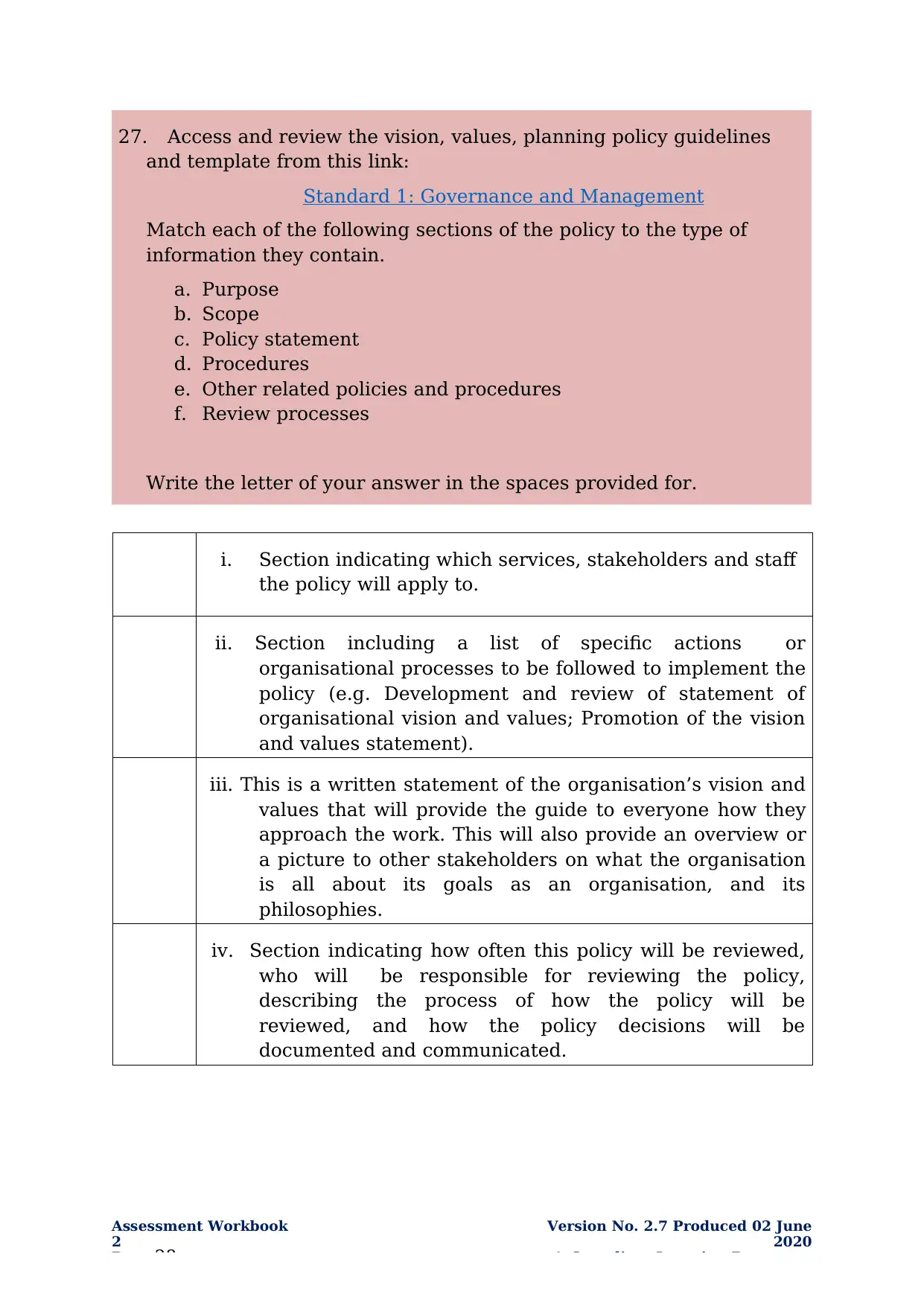
2
Page 28
Version No. 2.7 Produced 02 June
2020
© Compliant Learning Resources
i. Section indicating which services, stakeholders and staff
the policy will apply to.
ii. Section including a list of specific actions or
organisational processes to be followed to implement the
policy (e.g. Development and review of statement of
organisational vision and values; Promotion of the vision
and values statement).
iii. This is a written statement of the organisation’s vision and
values that will provide the guide to everyone how they
approach the work. This will also provide an overview or
a picture to other stakeholders on what the organisation
is all about its goals as an organisation, and its
philosophies.
iv. Section indicating how often this policy will be reviewed,
who will be responsible for reviewing the policy,
describing the process of how the policy will be
reviewed, and how the policy decisions will be
documented and communicated.
27. Access and review the vision, values, planning policy guidelines
and template from this link:
Standard 1: Governance and Management
Match each of the following sections of the policy to the type of
information they contain.
a. Purpose
b. Scope
c. Policy statement
d. Procedures
e. Other related policies and procedures
f. Review processes
Write the letter of your answer in the spaces provided for.
Paraphrase This Document
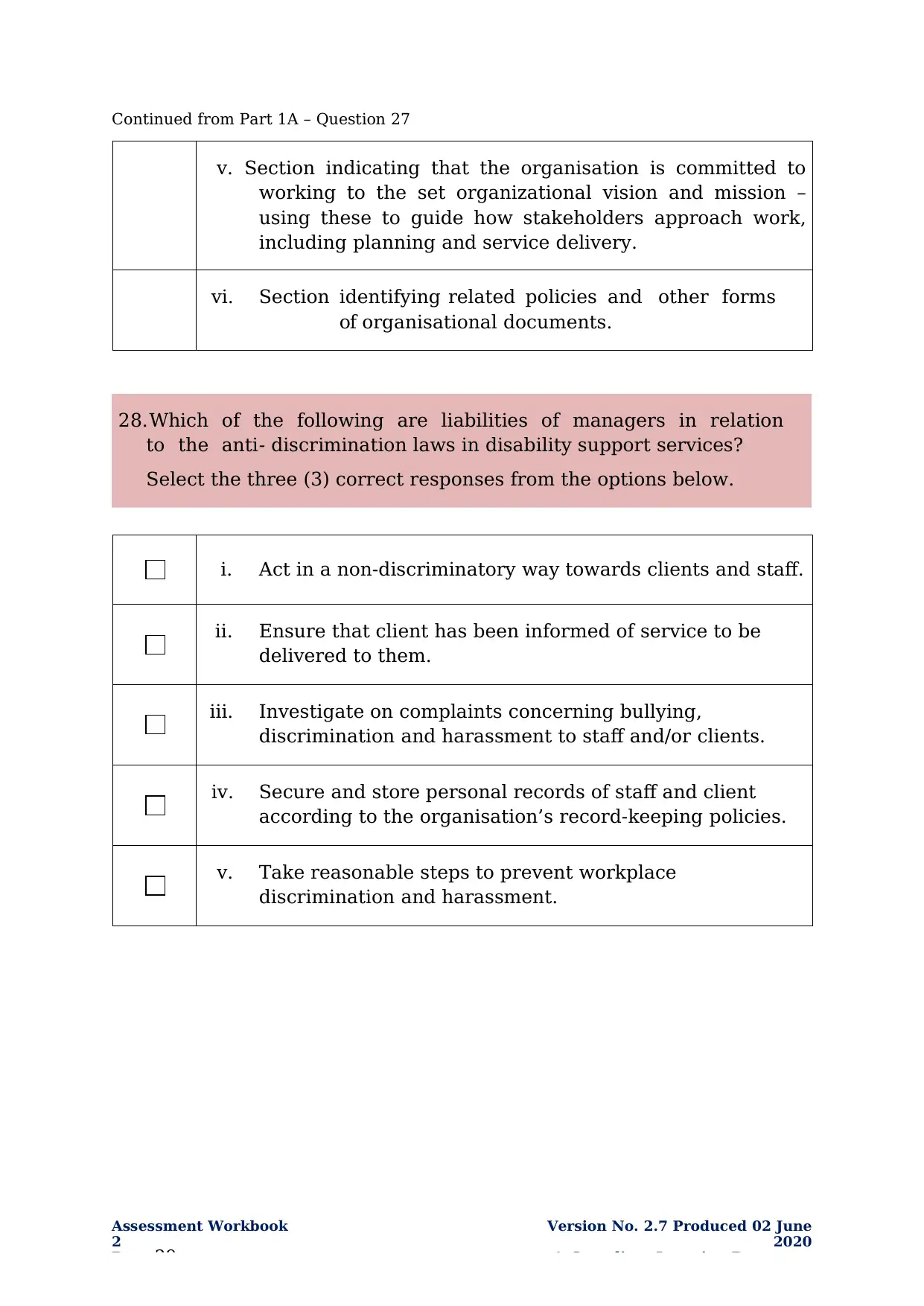
2
Page 29
Version No. 2.7 Produced 02 June
2020
© Compliant Learning Resources
Continued from Part 1A – Question 27
v. Section indicating that the organisation is committed to
working to the set organizational vision and mission –
using these to guide how stakeholders approach work,
including planning and service delivery.
vi. Section identifying related policies and other forms
of organisational documents.
i. Act in a non-discriminatory way towards clients and staff.
ii. Ensure that client has been informed of service to be
delivered to them.
iii. Investigate on complaints concerning bullying,
discrimination and harassment to staff and/or clients.
iv. Secure and store personal records of staff and client
according to the organisation’s record-keeping policies.
v. Take reasonable steps to prevent workplace
discrimination and harassment.
28.Which of the following are liabilities of managers in relation
to the anti- discrimination laws in disability support services?
Select the three (3) correct responses from the options below.
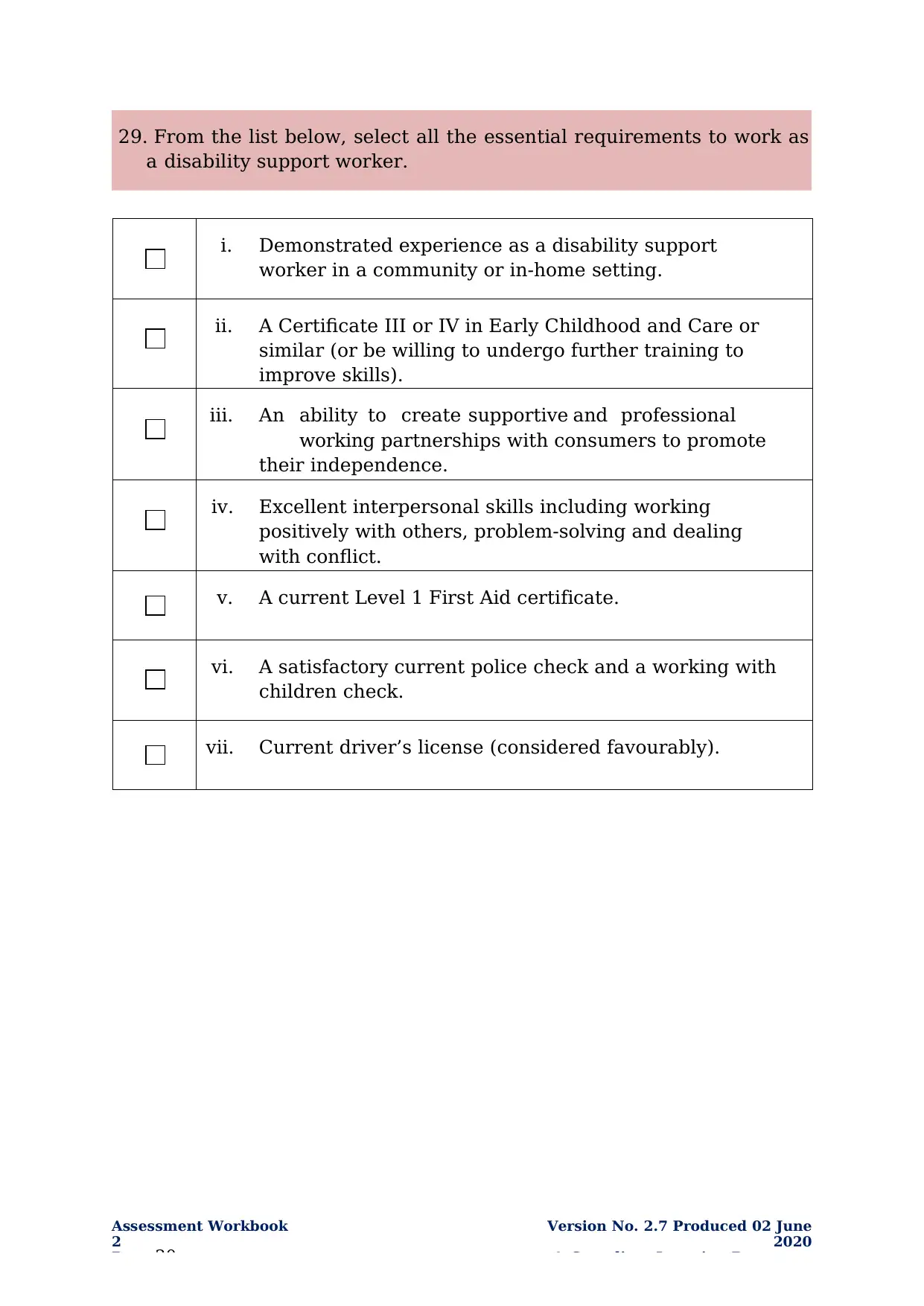
2
Page 30
Version No. 2.7 Produced 02 June
2020
© Compliant Learning Resources
i. Demonstrated experience as a disability support
worker in a community or in-home setting.
ii. A Certificate III or IV in Early Childhood and Care or
similar (or be willing to undergo further training to
improve skills).
iii. An ability to create supportive and professional
working partnerships with consumers to promote
their independence.
iv. Excellent interpersonal skills including working
positively with others, problem-solving and dealing
with conflict.
v. A current Level 1 First Aid certificate.
vi. A satisfactory current police check and a working with
children check.
vii. Current driver’s license (considered favourably).
29. From the list below, select all the essential requirements to work as
a disability support worker.
You're viewing a preview
Unlock full access by subscribing today!
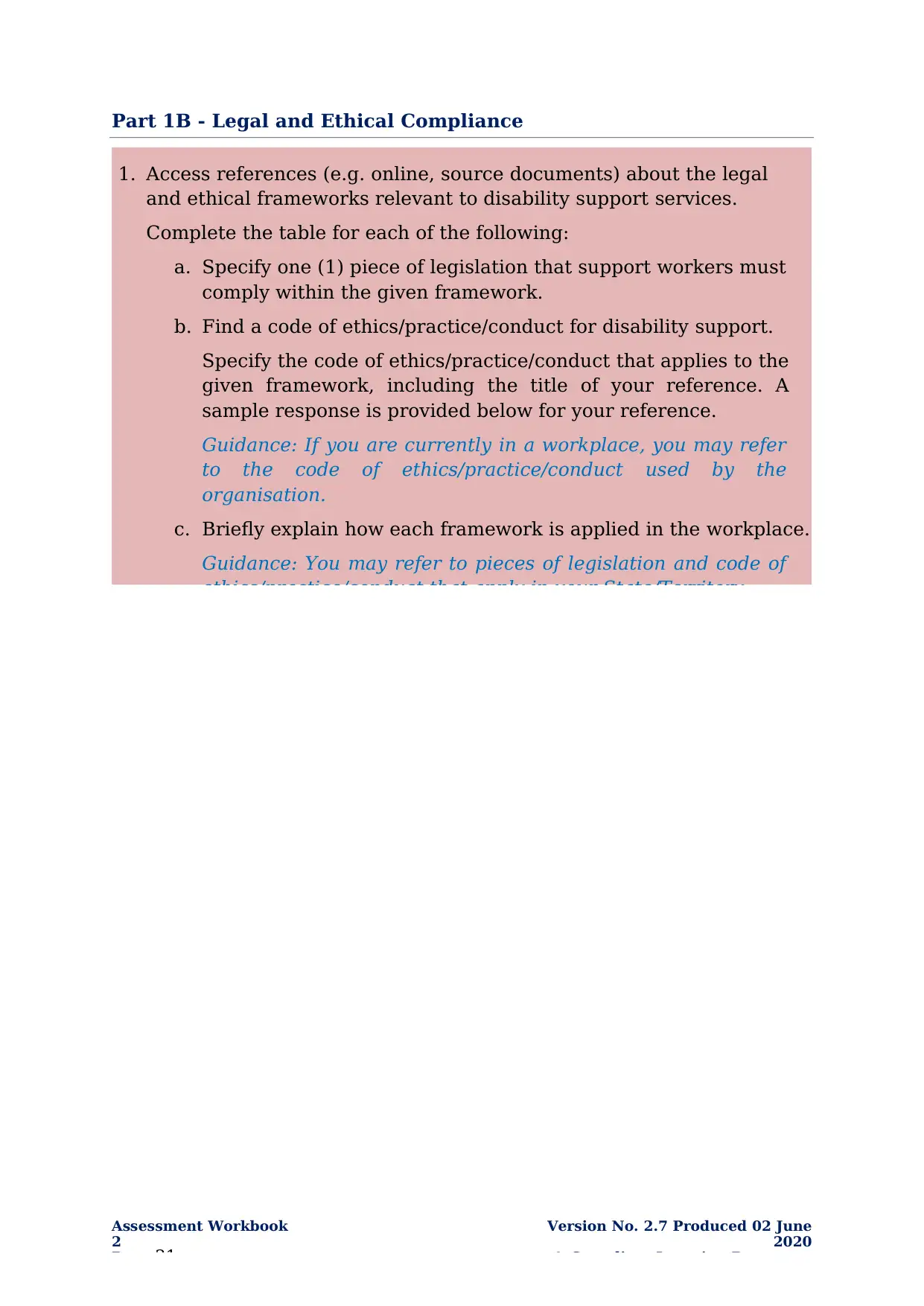
2
Page 31
Version No. 2.7 Produced 02 June
2020
© Compliant Learning Resources
Part 1B - Legal and Ethical Compliance
1. Access references (e.g. online, source documents) about the legal
and ethical frameworks relevant to disability support services.
Complete the table for each of the following:
a. Specify one (1) piece of legislation that support workers must
comply within the given framework.
b. Find a code of ethics/practice/conduct for disability support.
Specify the code of ethics/practice/conduct that applies to the
given framework, including the title of your reference. A
sample response is provided below for your reference.
Guidance: If you are currently in a workplace, you may refer
to the code of ethics/practice/conduct used by the
organisation.
c. Briefly explain how each framework is applied in the workplace.
Guidance: You may refer to pieces of legislation and code of
ethics/practice/conduct that apply in your State/Territory.
Paraphrase This Document
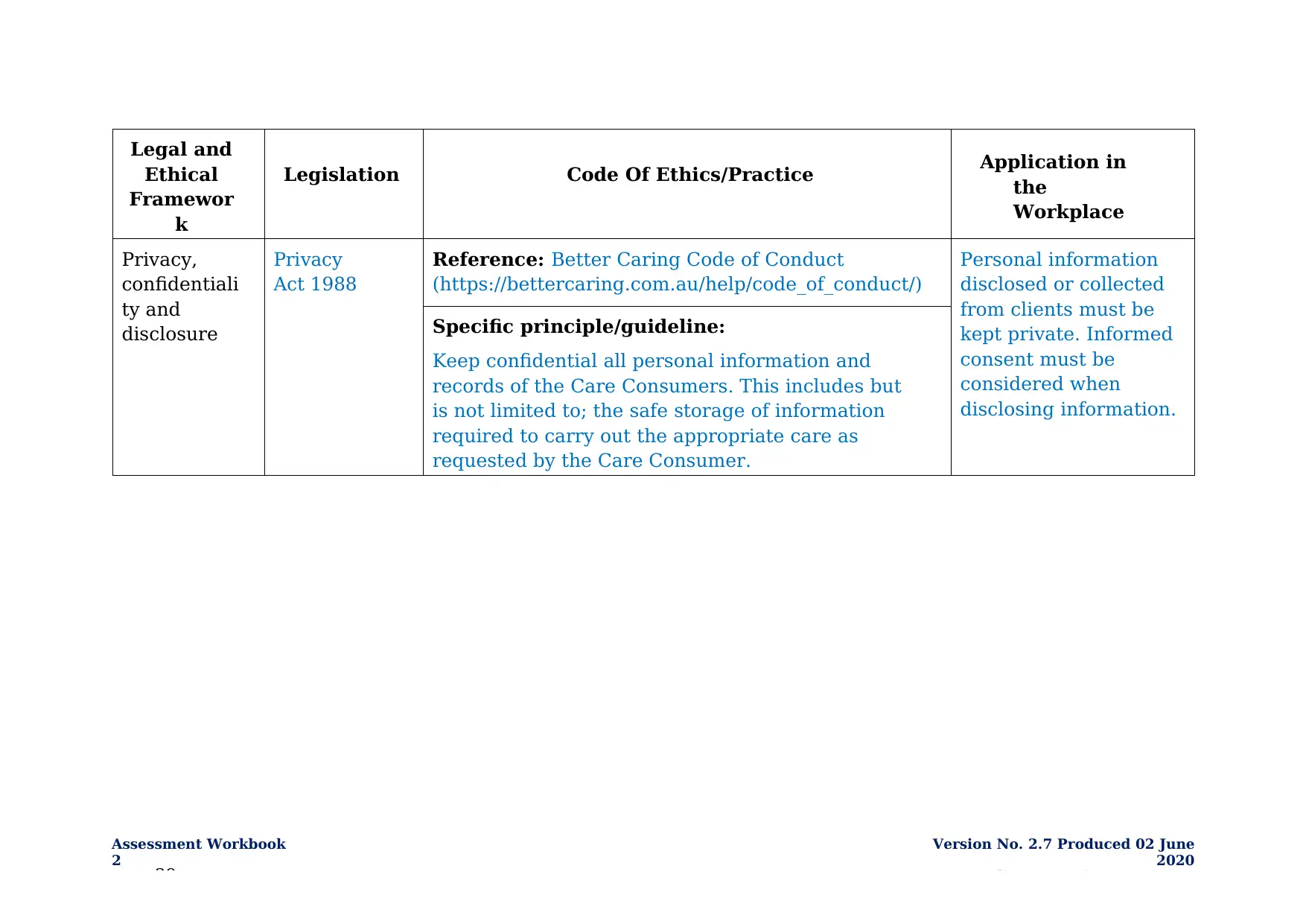
2
Page 39
Version No. 2.7 Produced 02 June
2020
© Compliant Learning Resources
Legal and
Ethical
Framewor
k
Legislation Code Of Ethics/Practice Application in
the
Workplace
Privacy,
confidentiali
ty and
disclosure
Privacy
Act 1988
Reference: Better Caring Code of Conduct
(https://bettercaring.com.au/help/code_of_conduct/)
Personal information
disclosed or collected
from clients must be
kept private. Informed
consent must be
considered when
disclosing information.
Specific principle/guideline:
Keep confidential all personal information and
records of the Care Consumers. This includes but
is not limited to; the safe storage of information
required to carry out the appropriate care as
requested by the Care Consumer.
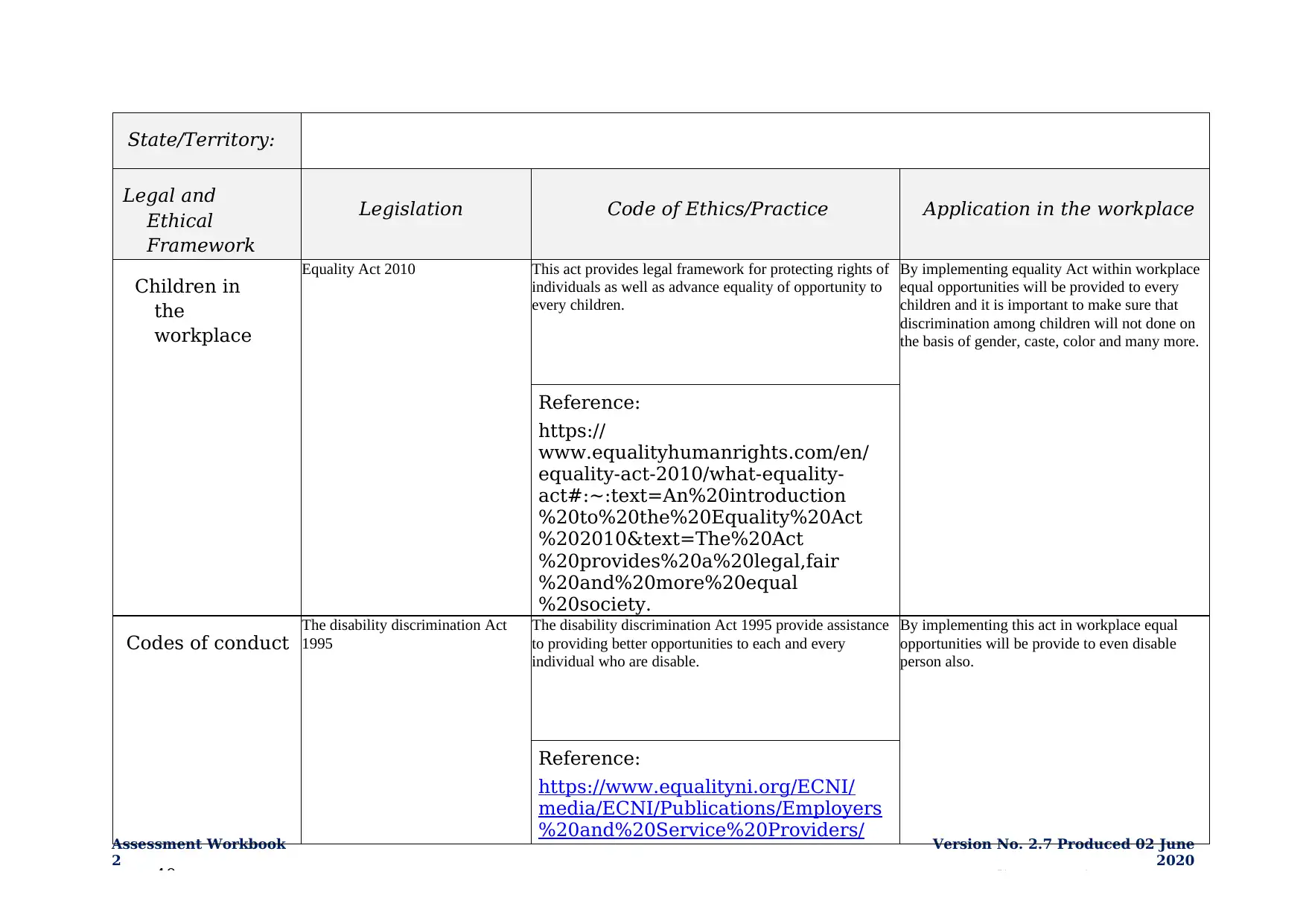
2
Page 40
Version No. 2.7 Produced 02 June
2020
© Compliant Learning Resources
State/Territory:
Legal and
Ethical
Framework
Legislation Code of Ethics/Practice Application in the workplace
Children in
the
workplace
Equality Act 2010 This act provides legal framework for protecting rights of
individuals as well as advance equality of opportunity to
every children.
By implementing equality Act within workplace
equal opportunities will be provided to every
children and it is important to make sure that
discrimination among children will not done on
the basis of gender, caste, color and many more.
Reference:
https://
www.equalityhumanrights.com/en/
equality-act-2010/what-equality-
act#:~:text=An%20introduction
%20to%20the%20Equality%20Act
%202010&text=The%20Act
%20provides%20a%20legal,fair
%20and%20more%20equal
%20society.
Codes of conduct
The disability discrimination Act
1995
The disability discrimination Act 1995 provide assistance
to providing better opportunities to each and every
individual who are disable.
By implementing this act in workplace equal
opportunities will be provide to even disable
person also.
Reference:
https://www.equalityni.org/ECNI/
media/ECNI/Publications/Employers
%20and%20Service%20Providers/
You're viewing a preview
Unlock full access by subscribing today!
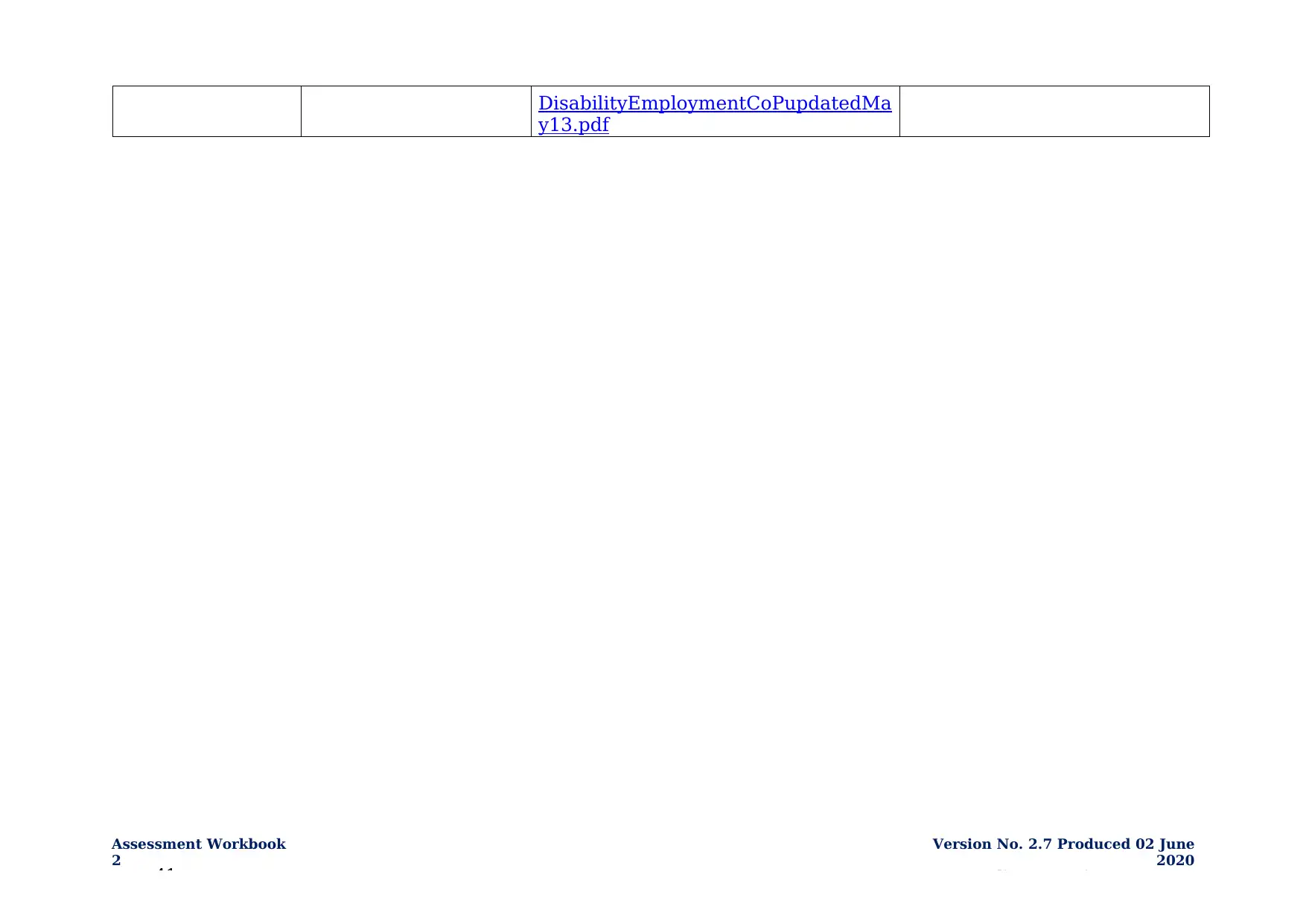
2
Page 41
Version No. 2.7 Produced 02 June
2020
© Compliant Learning Resources
DisabilityEmploymentCoPupdatedMa
y13.pdf
Paraphrase This Document
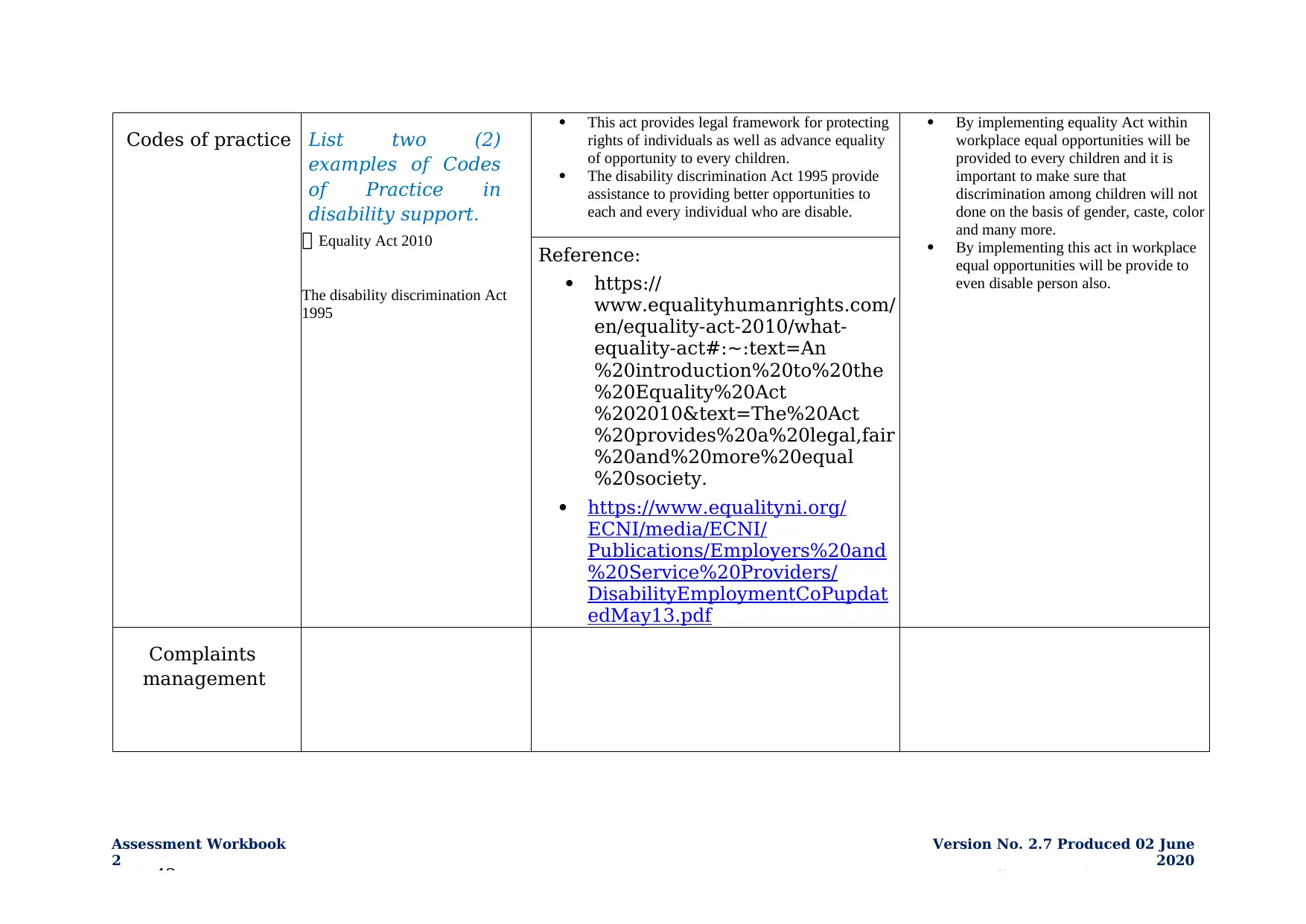
2
Page 42
Version No. 2.7 Produced 02 June
2020
© Compliant Learning Resources
Codes of practice List two (2)
examples of Codes
of Practice in
disability support.
Equality Act 2010
The disability discrimination Act
1995
This act provides legal framework for protecting
rights of individuals as well as advance equality
of opportunity to every children.
The disability discrimination Act 1995 provide
assistance to providing better opportunities to
each and every individual who are disable.
By implementing equality Act within
workplace equal opportunities will be
provided to every children and it is
important to make sure that
discrimination among children will not
done on the basis of gender, caste, color
and many more.
By implementing this act in workplace
equal opportunities will be provide to
even disable person also.
Reference:
https://
www.equalityhumanrights.com/
en/equality-act-2010/what-
equality-act#:~:text=An
%20introduction%20to%20the
%20Equality%20Act
%202010&text=The%20Act
%20provides%20a%20legal,fair
%20and%20more%20equal
%20society.
https://www.equalityni.org/
ECNI/media/ECNI/
Publications/Employers%20and
%20Service%20Providers/
DisabilityEmploymentCoPupdat
edMay13.pdf
Complaints
management
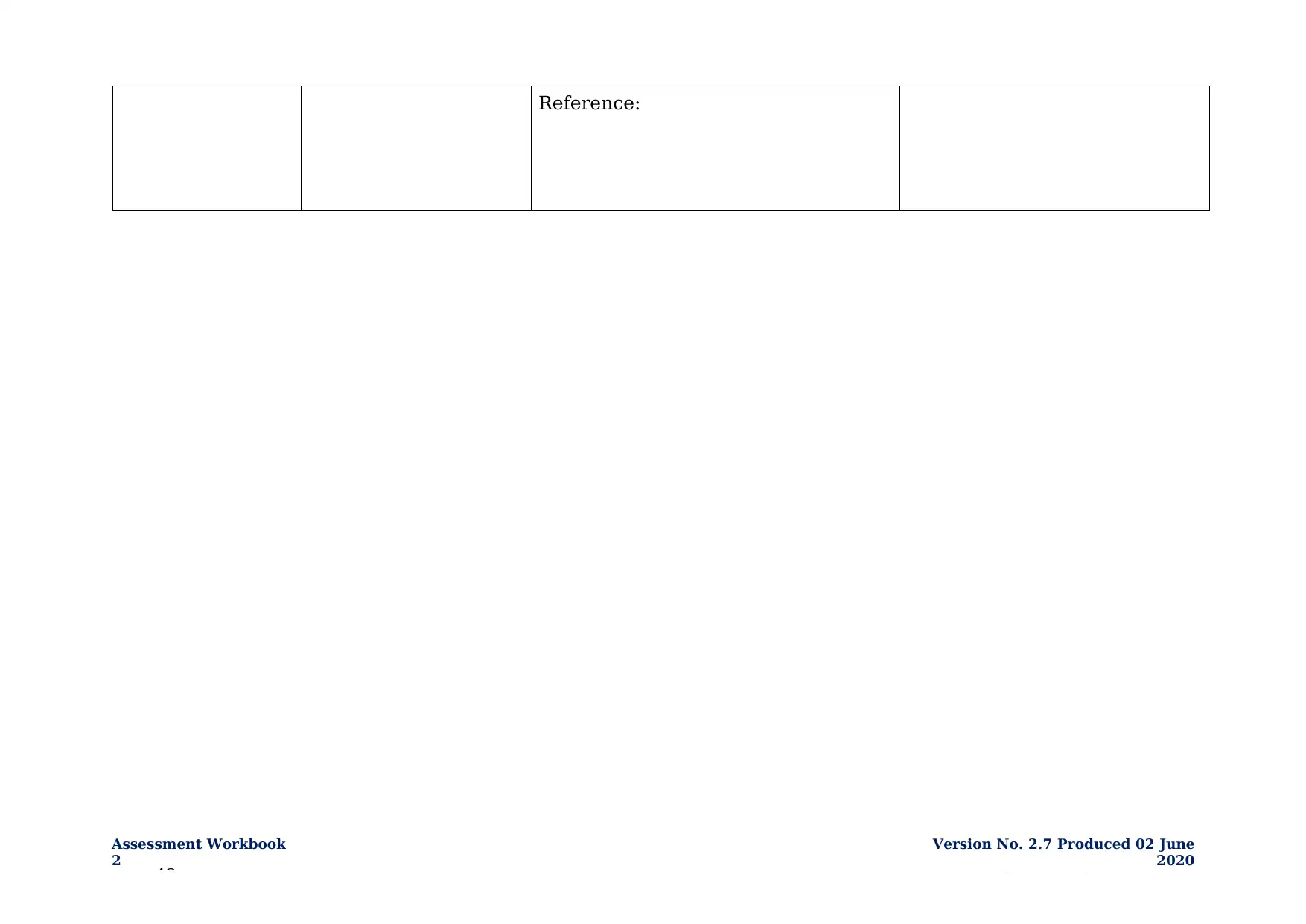
2
Page 43
Version No. 2.7 Produced 02 June
2020
© Compliant Learning Resources
Reference:
You're viewing a preview
Unlock full access by subscribing today!
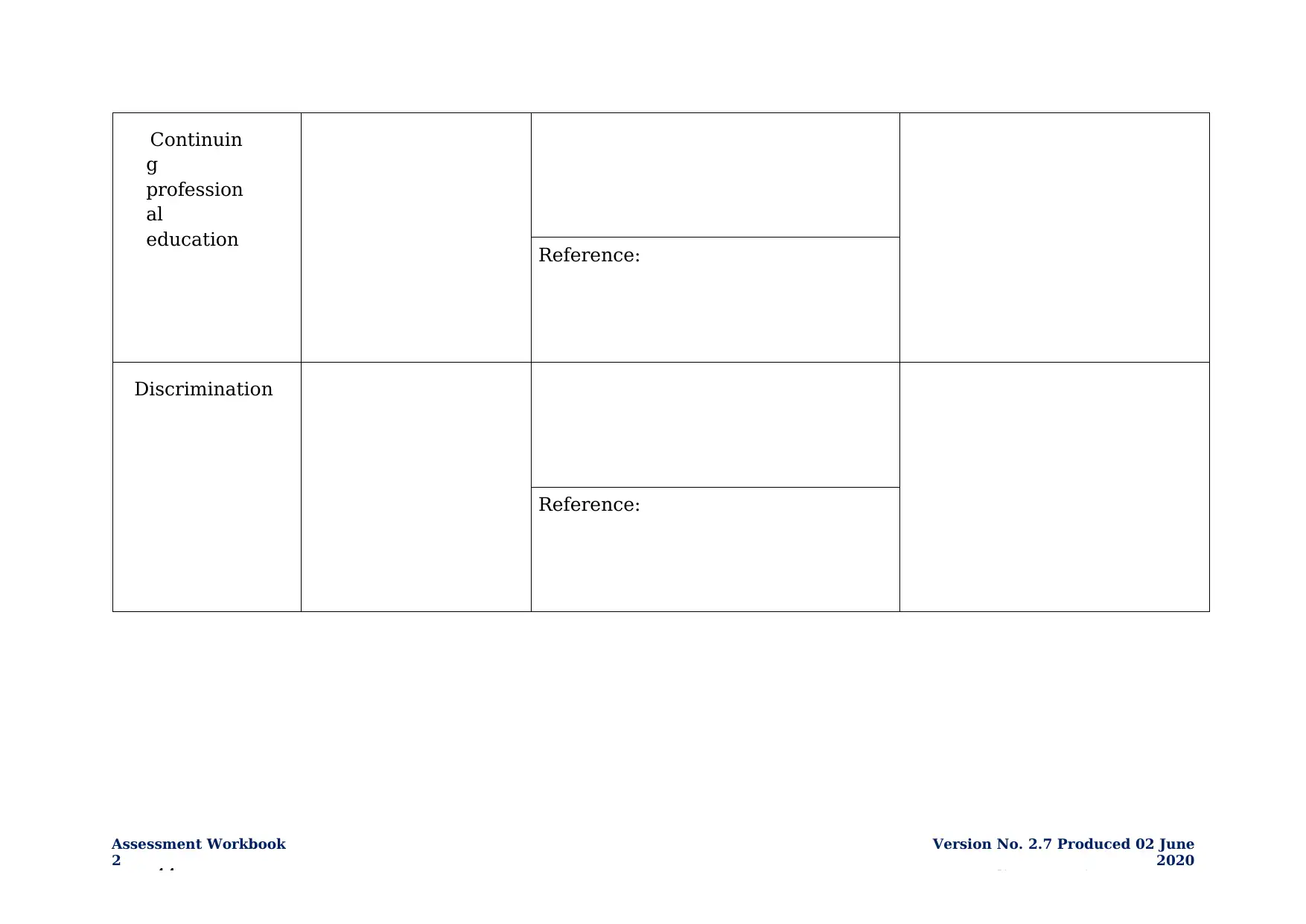
2
Page 44
Version No. 2.7 Produced 02 June
2020
© Compliant Learning Resources
Continuin
g
profession
al
education Reference:
Discrimination
Reference:
Paraphrase This Document
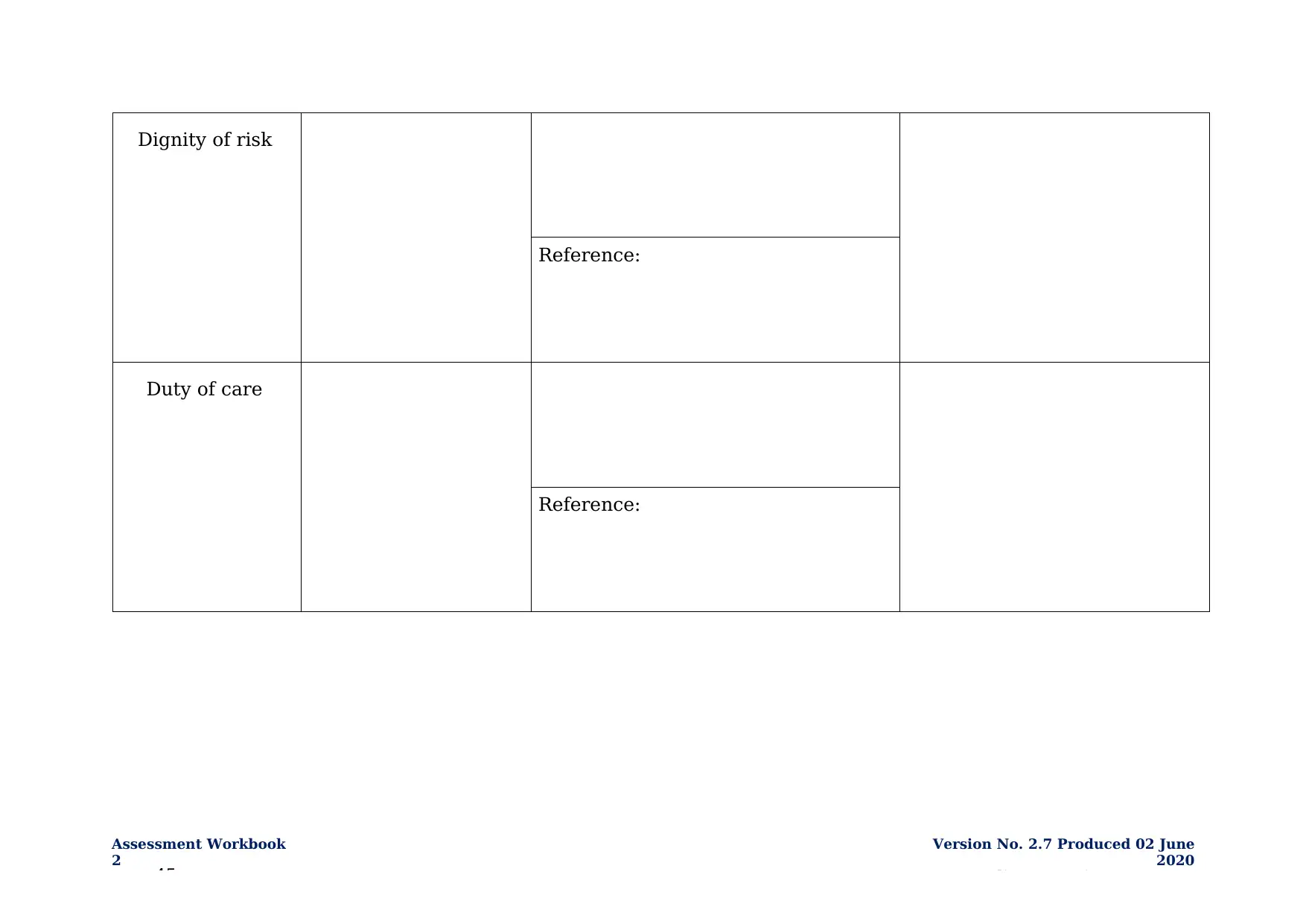
2
Page 45
Version No. 2.7 Produced 02 June
2020
© Compliant Learning Resources
Dignity of risk
Reference:
Duty of care
Reference:
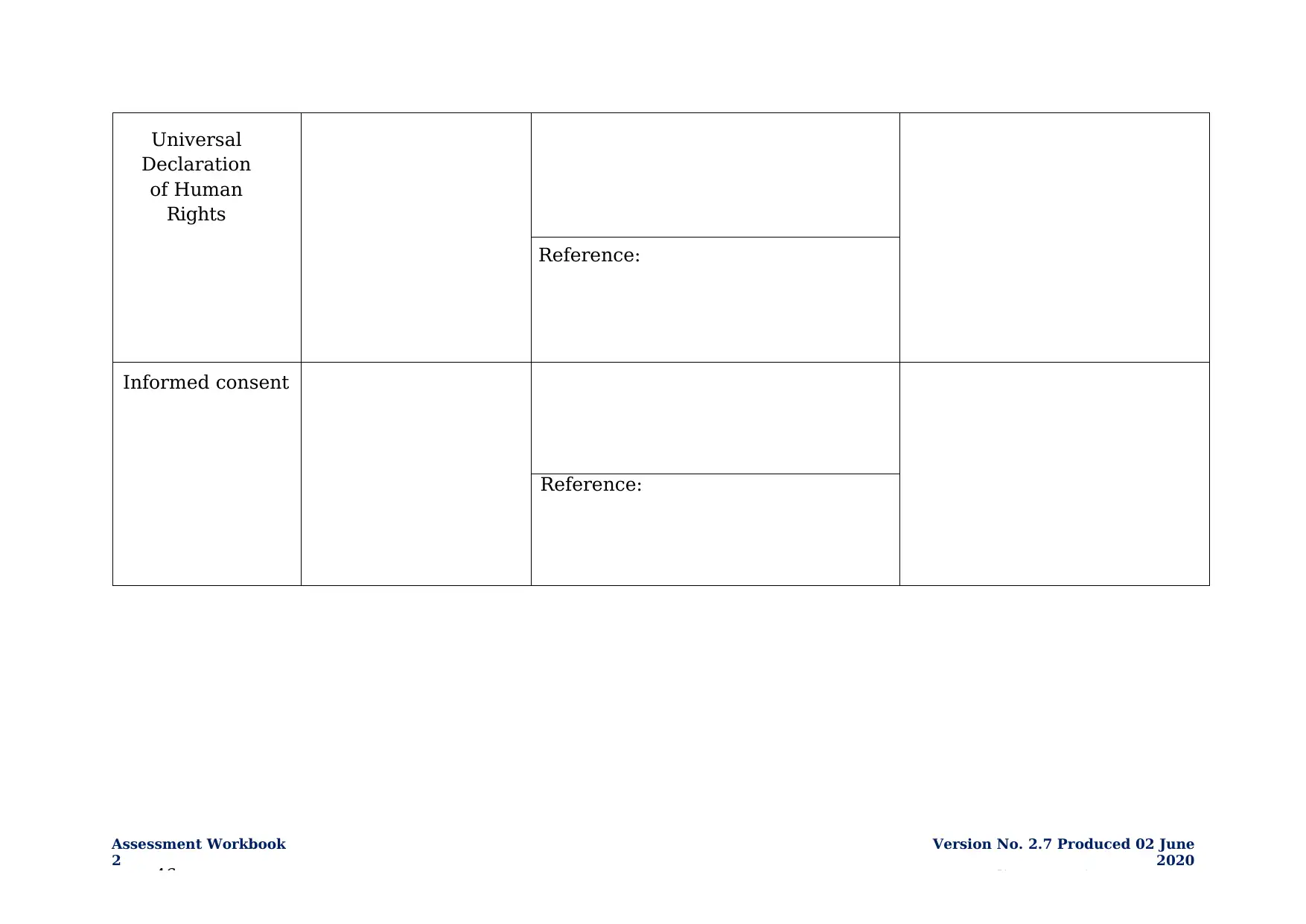
2
Page 46
Version No. 2.7 Produced 02 June
2020
© Compliant Learning Resources
Universal
Declaration
of Human
Rights
Reference:
Informed consent
Reference:
You're viewing a preview
Unlock full access by subscribing today!
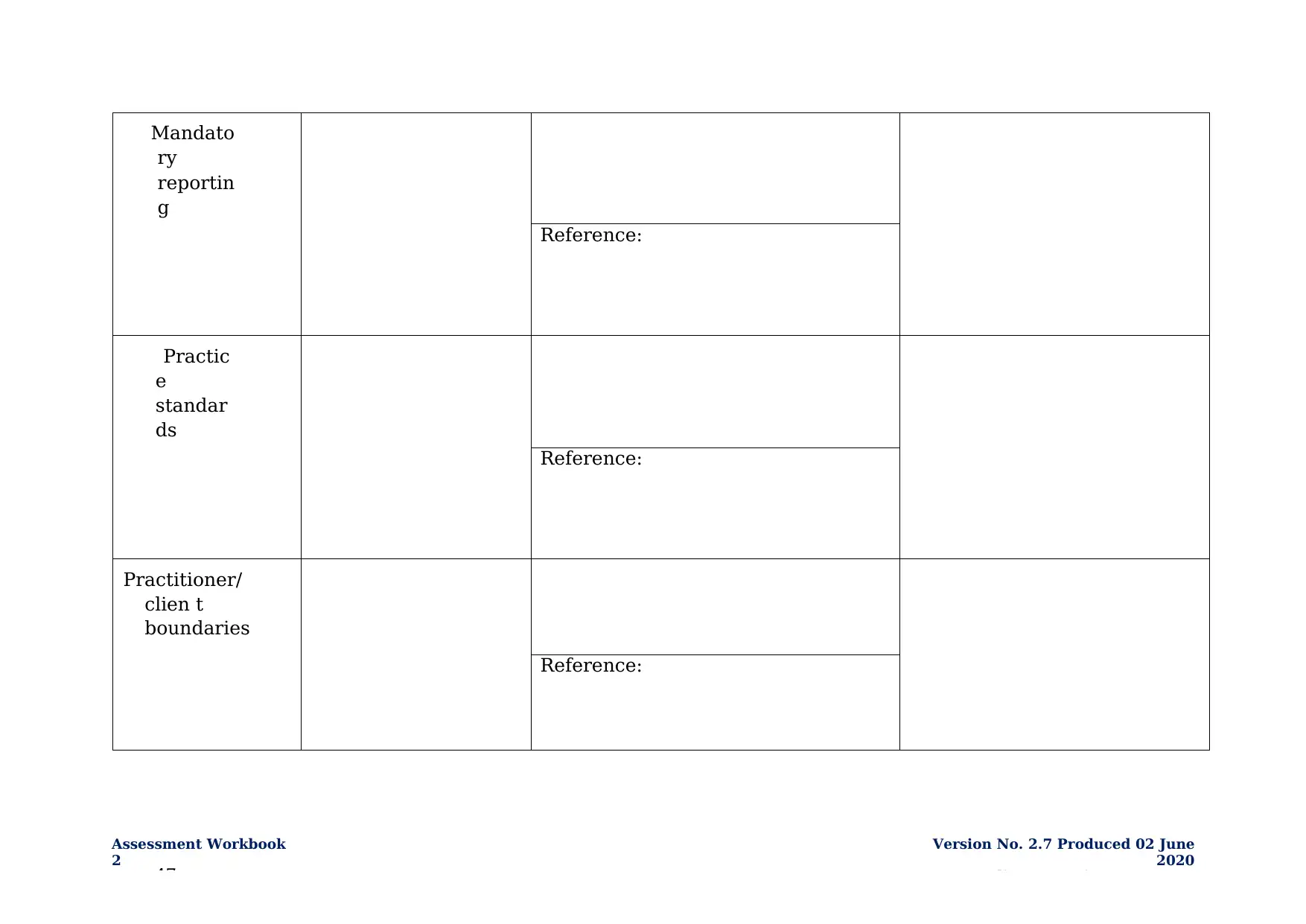
2
Page 47
Version No. 2.7 Produced 02 June
2020
© Compliant Learning Resources
Mandato
ry
reportin
g
Reference:
Practic
e
standar
ds
Reference:
Practitioner/
clien t
boundaries
Reference:
Paraphrase This Document
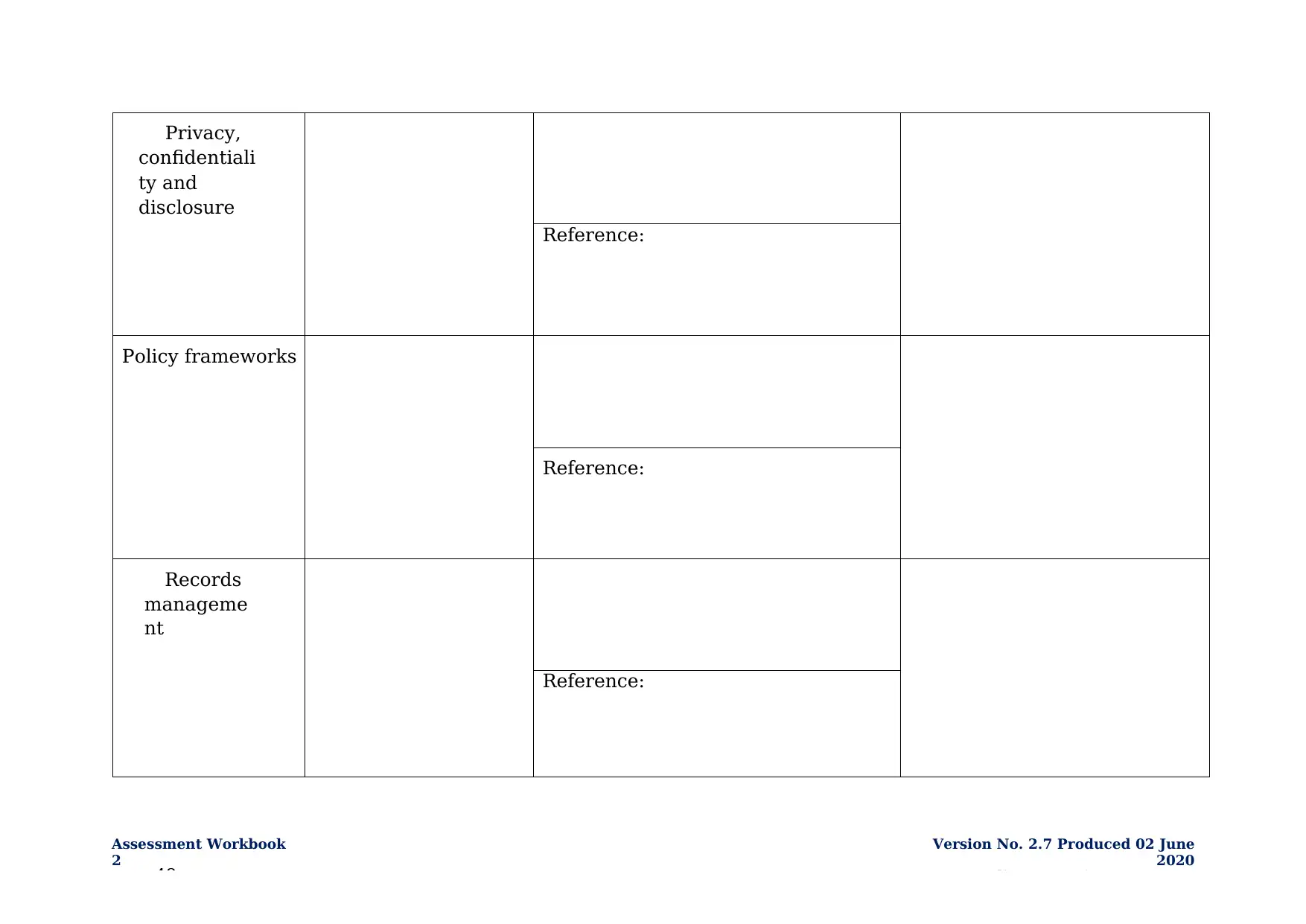
2
Page 48
Version No. 2.7 Produced 02 June
2020
© Compliant Learning Resources
Privacy,
confidentiali
ty and
disclosure
Reference:
Policy frameworks
Reference:
Records
manageme
nt
Reference:
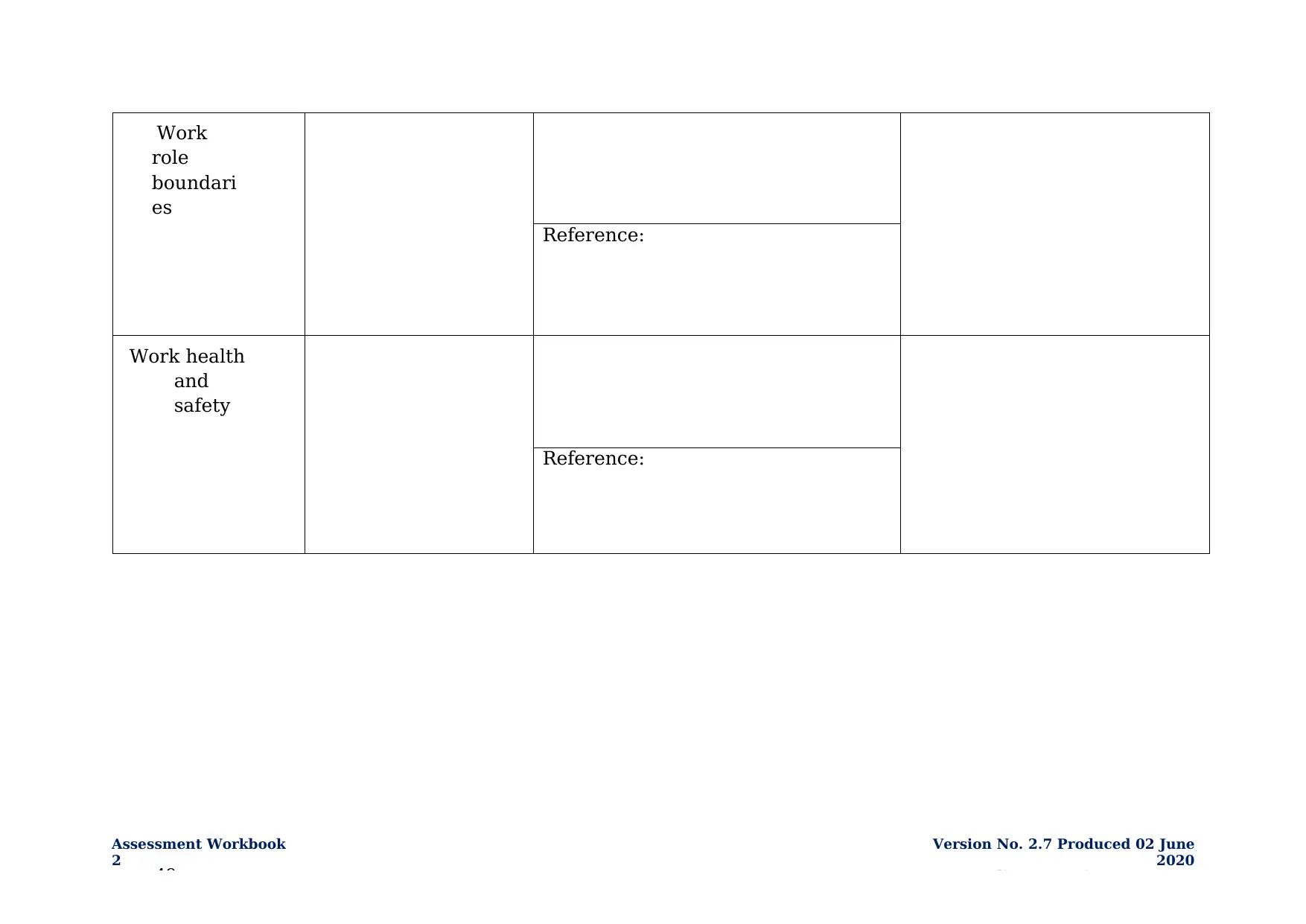
2
Page 49
Version No. 2.7 Produced 02 June
2020
© Compliant Learning Resources
Work
role
boundari
es
Reference:
Work health
and
safety
Reference:
You're viewing a preview
Unlock full access by subscribing today!
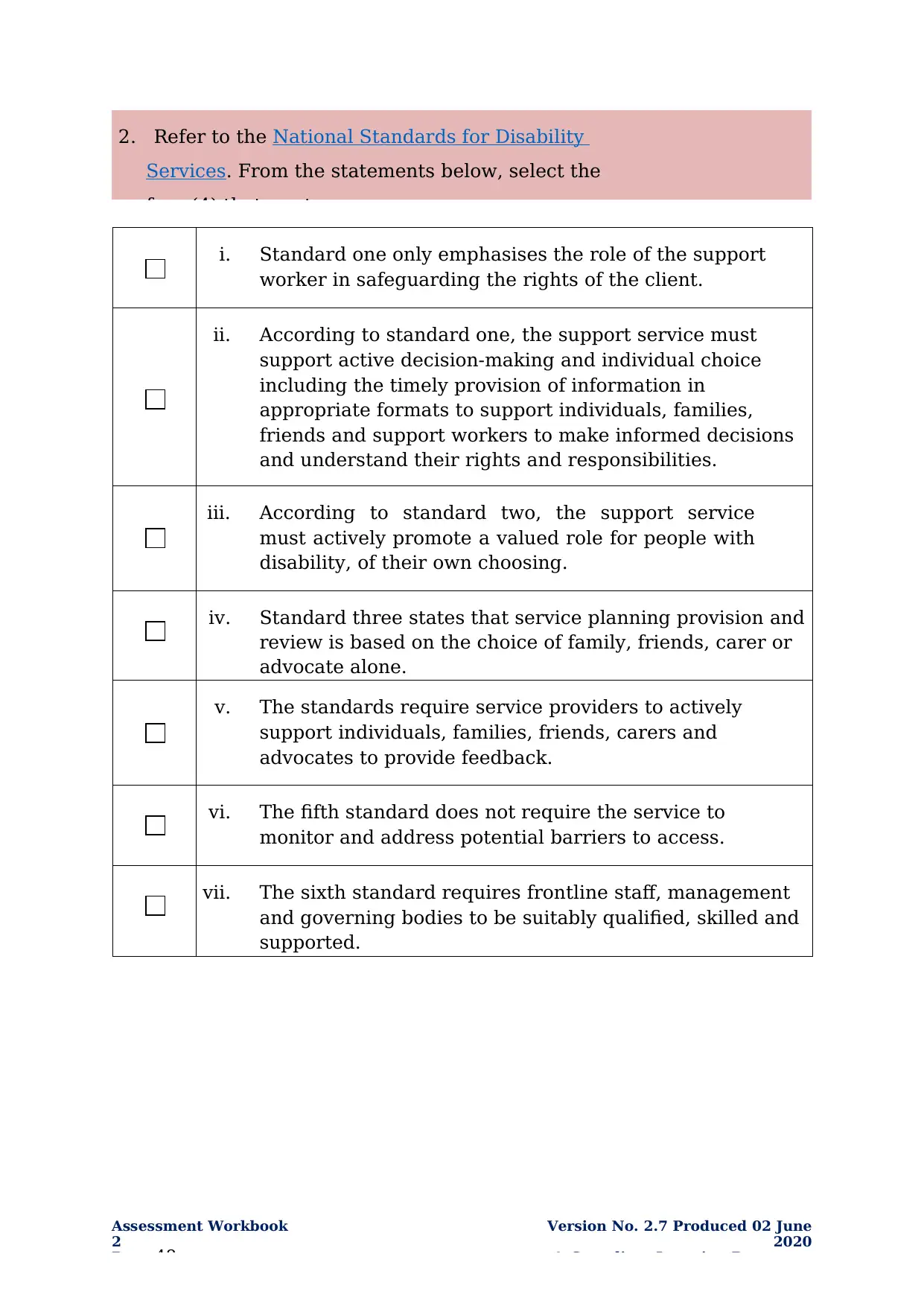
2
Page 48
Version No. 2.7 Produced 02 June
2020
© Compliant Learning Resources
i. Standard one only emphasises the role of the support
worker in safeguarding the rights of the client.
ii. According to standard one, the support service must
support active decision-making and individual choice
including the timely provision of information in
appropriate formats to support individuals, families,
friends and support workers to make informed decisions
and understand their rights and responsibilities.
iii. According to standard two, the support service
must actively promote a valued role for people with
disability, of their own choosing.
iv. Standard three states that service planning provision and
review is based on the choice of family, friends, carer or
advocate alone.
v. The standards require service providers to actively
support individuals, families, friends, carers and
advocates to provide feedback.
vi. The fifth standard does not require the service to
monitor and address potential barriers to access.
vii. The sixth standard requires frontline staff, management
and governing bodies to be suitably qualified, skilled and
supported.
2. Refer to the National Standards for Disability
Services. From the statements below, select the
four (4) that are true.
Paraphrase This Document
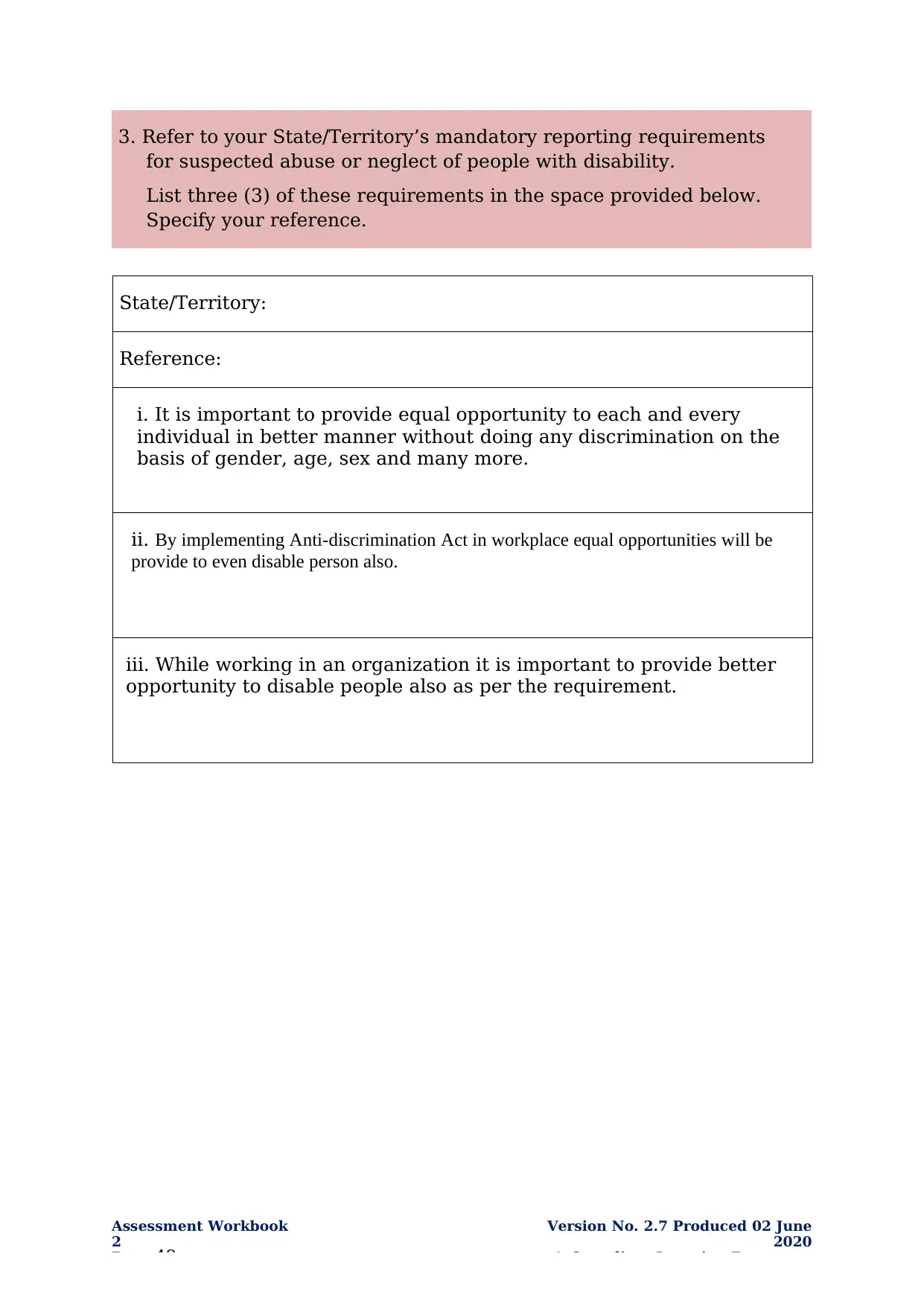
2
Page 49
Version No. 2.7 Produced 02 June
2020
© Compliant Learning Resources
State/Territory:
Reference:
i. It is important to provide equal opportunity to each and every
individual in better manner without doing any discrimination on the
basis of gender, age, sex and many more.
ii. By implementing Anti-discrimination Act in workplace equal opportunities will be
provide to even disable person also.
iii. While working in an organization it is important to provide better
opportunity to disable people also as per the requirement.
3. Refer to your State/Territory’s mandatory reporting requirements
for suspected abuse or neglect of people with disability.
List three (3) of these requirements in the space provided below.
Specify your reference.
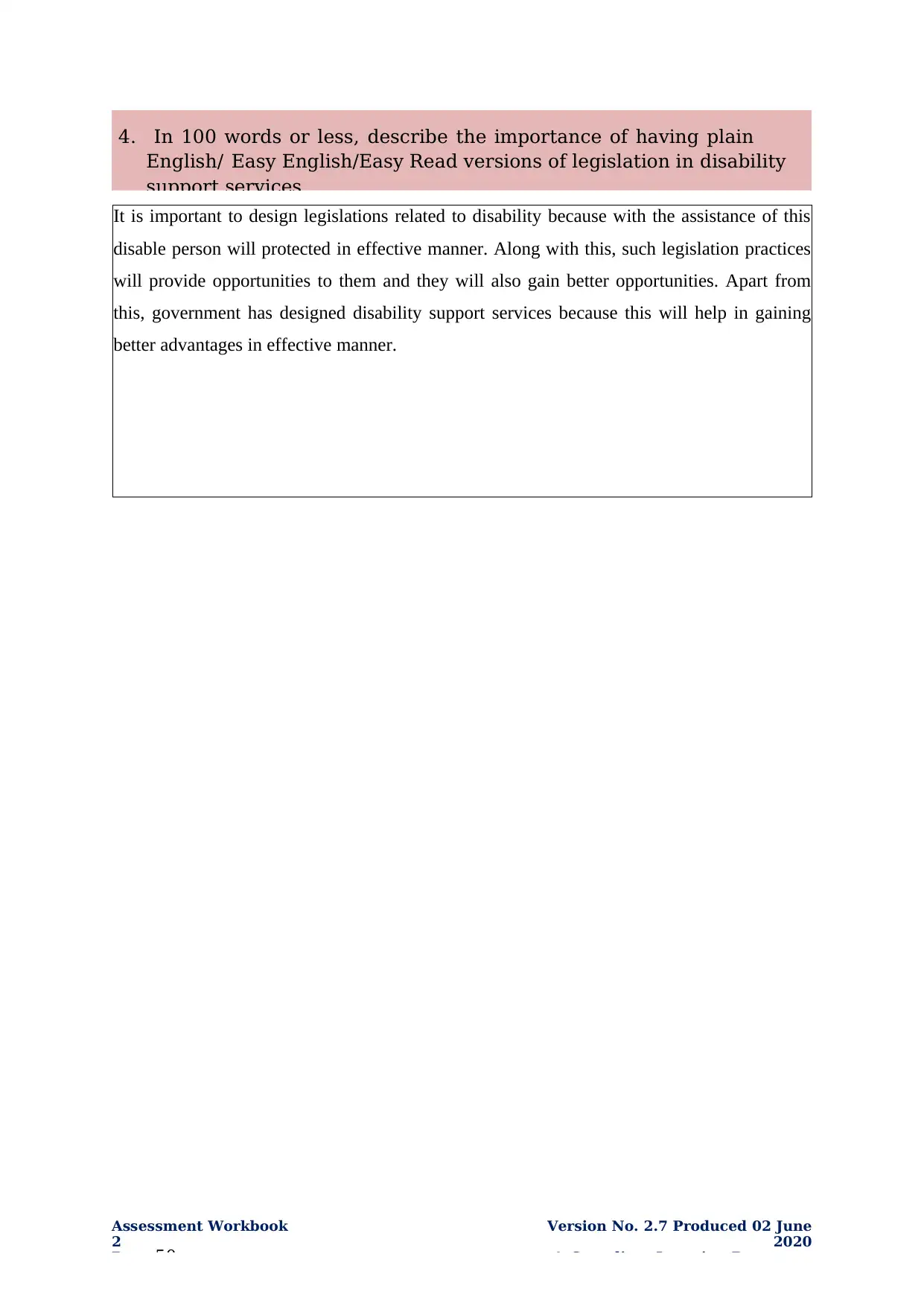
2
Page 50
Version No. 2.7 Produced 02 June
2020
© Compliant Learning Resources
It is important to design legislations related to disability because with the assistance of this
disable person will protected in effective manner. Along with this, such legislation practices
will provide opportunities to them and they will also gain better opportunities. Apart from
this, government has designed disability support services because this will help in gaining
better advantages in effective manner.
4. In 100 words or less, describe the importance of having plain
English/ Easy English/Easy Read versions of legislation in disability
support services.
You're viewing a preview
Unlock full access by subscribing today!
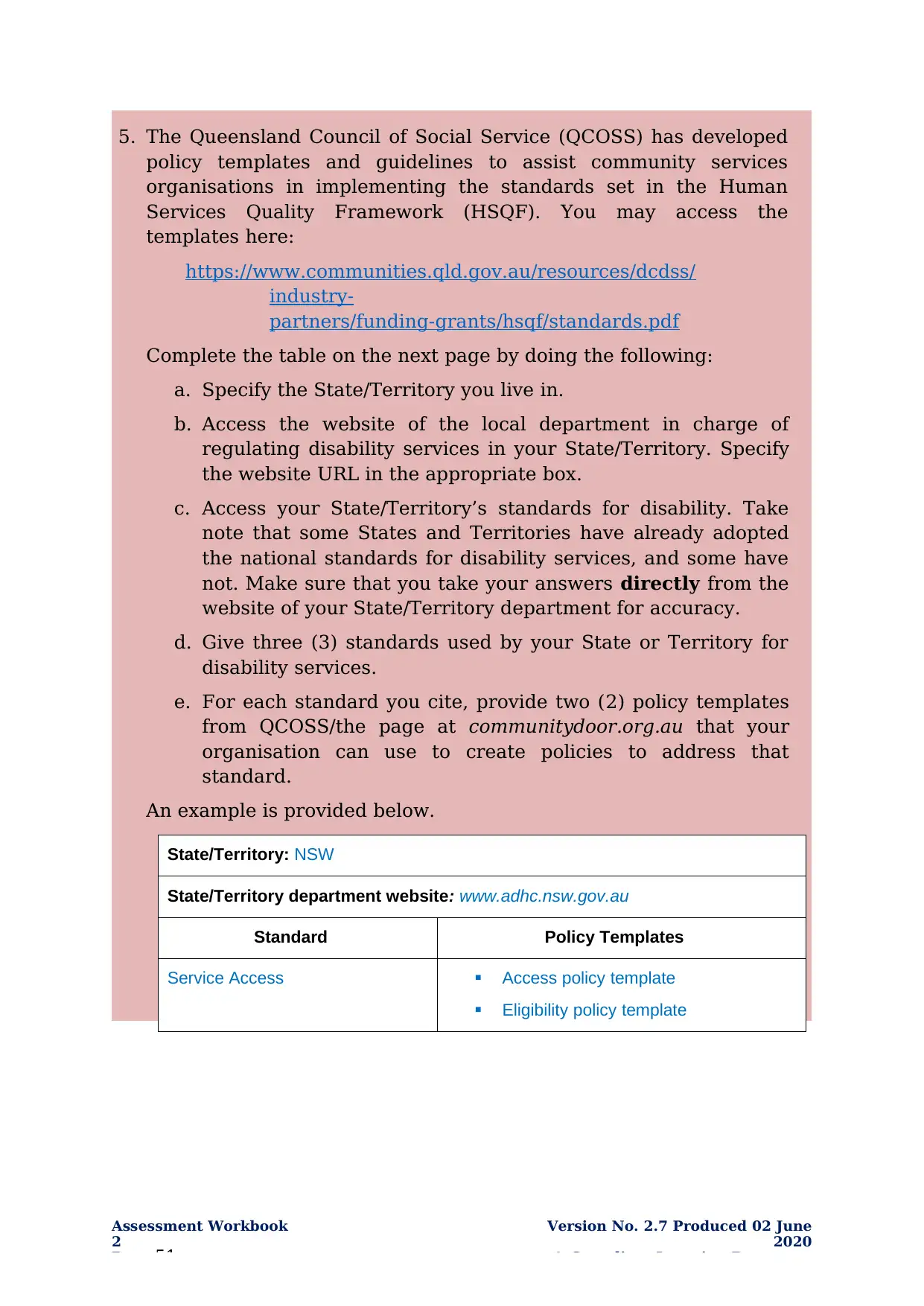
2
Page 51
Version No. 2.7 Produced 02 June
2020
© Compliant Learning Resources
5. The Queensland Council of Social Service (QCOSS) has developed
policy templates and guidelines to assist community services
organisations in implementing the standards set in the Human
Services Quality Framework (HSQF). You may access the
templates here:
https://www.communities.qld.gov.au/resources/dcdss/
industry-
partners/funding-grants/hsqf/standards.pdf
Complete the table on the next page by doing the following:
a. Specify the State/Territory you live in.
b. Access the website of the local department in charge of
regulating disability services in your State/Territory. Specify
the website URL in the appropriate box.
c. Access your State/Territory’s standards for disability. Take
note that some States and Territories have already adopted
the national standards for disability services, and some have
not. Make sure that you take your answers directly from the
website of your State/Territory department for accuracy.
d. Give three (3) standards used by your State or Territory for
disability services.
e. For each standard you cite, provide two (2) policy templates
from QCOSS/the page at communitydoor.org.au that your
organisation can use to create policies to address that
standard.
An example is provided below.
State/Territory: NSW
State/Territory department website: www.adhc.nsw.gov.au
Standard Policy Templates
Service Access Access policy template
Eligibility policy template
Paraphrase This Document
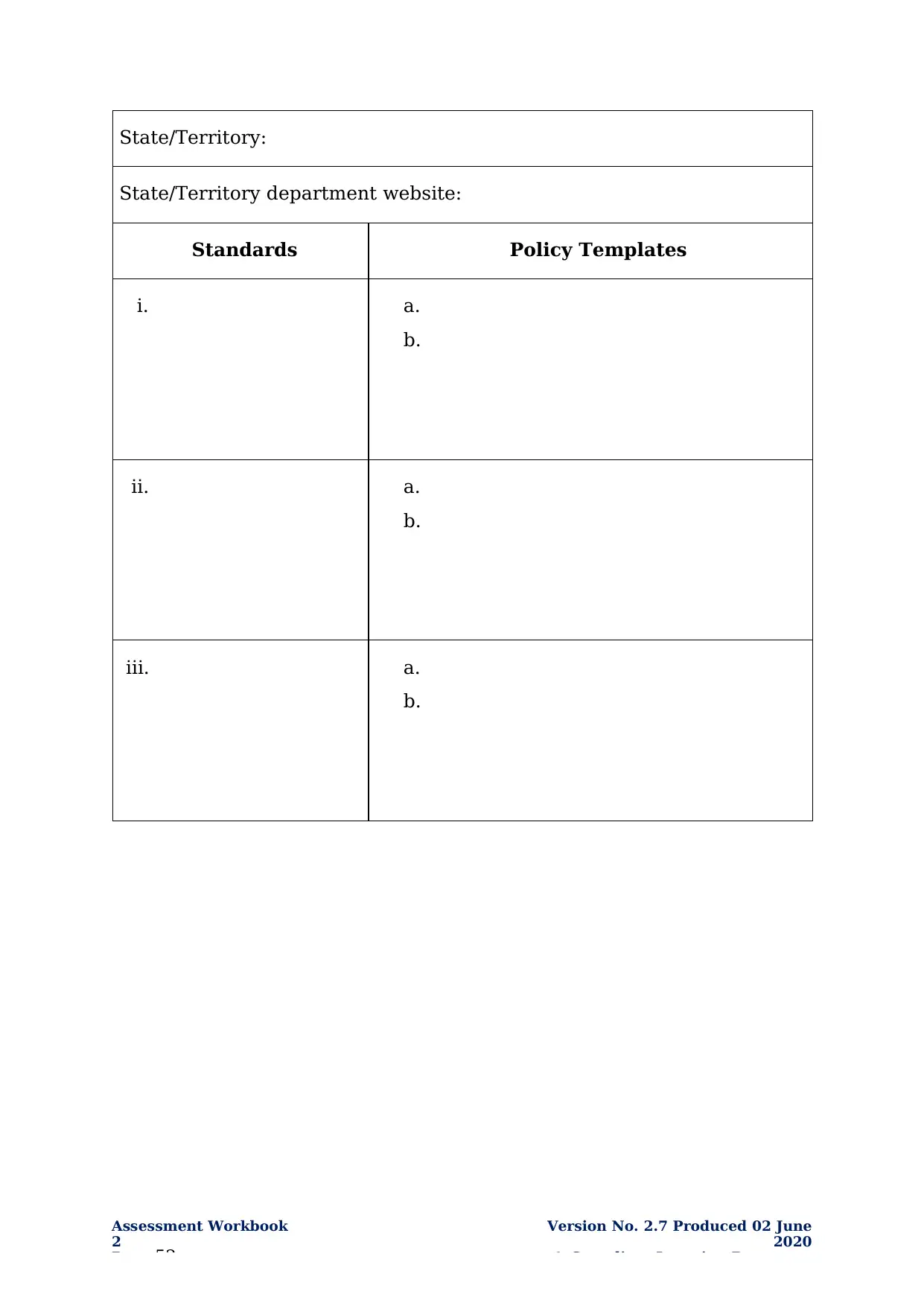
2
Page 52
Version No. 2.7 Produced 02 June
2020
© Compliant Learning Resources
State/Territory:
State/Territory department website:
Standards Policy Templates
i. a.
b.
ii. a.
b.
iii. a.
b.
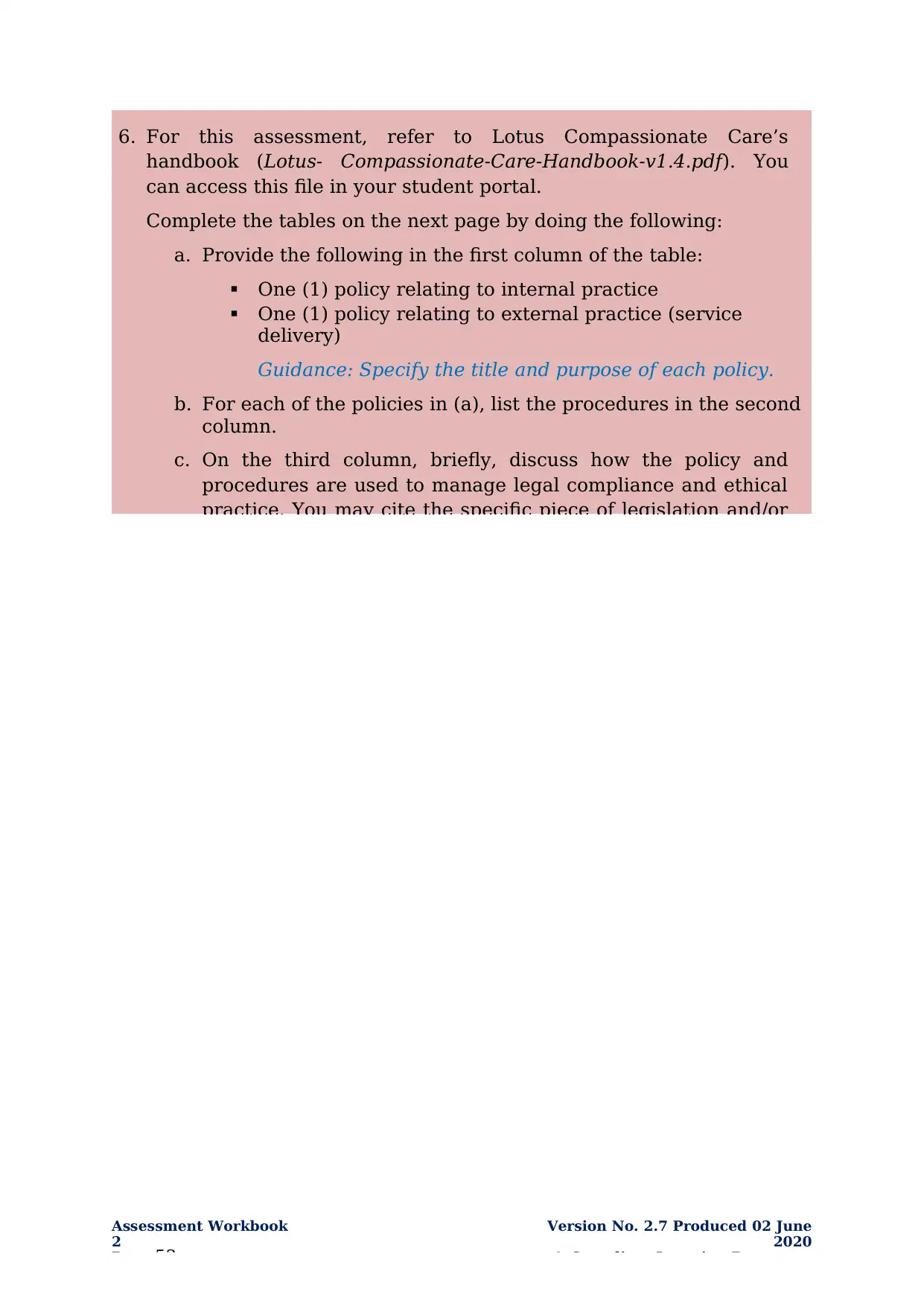
2
Page 53
Version No. 2.7 Produced 02 June
2020
© Compliant Learning Resources
6. For this assessment, refer to Lotus Compassionate Care’s
handbook (Lotus- Compassionate-Care-Handbook-v1.4.pdf). You
can access this file in your student portal.
Complete the tables on the next page by doing the following:
a. Provide the following in the first column of the table:
One (1) policy relating to internal practice
One (1) policy relating to external practice (service
delivery)
Guidance: Specify the title and purpose of each policy.
b. For each of the policies in (a), list the procedures in the second
column.
c. On the third column, briefly, discuss how the policy and
procedures are used to manage legal compliance and ethical
practice. You may cite the specific piece of legislation and/or
You're viewing a preview
Unlock full access by subscribing today!
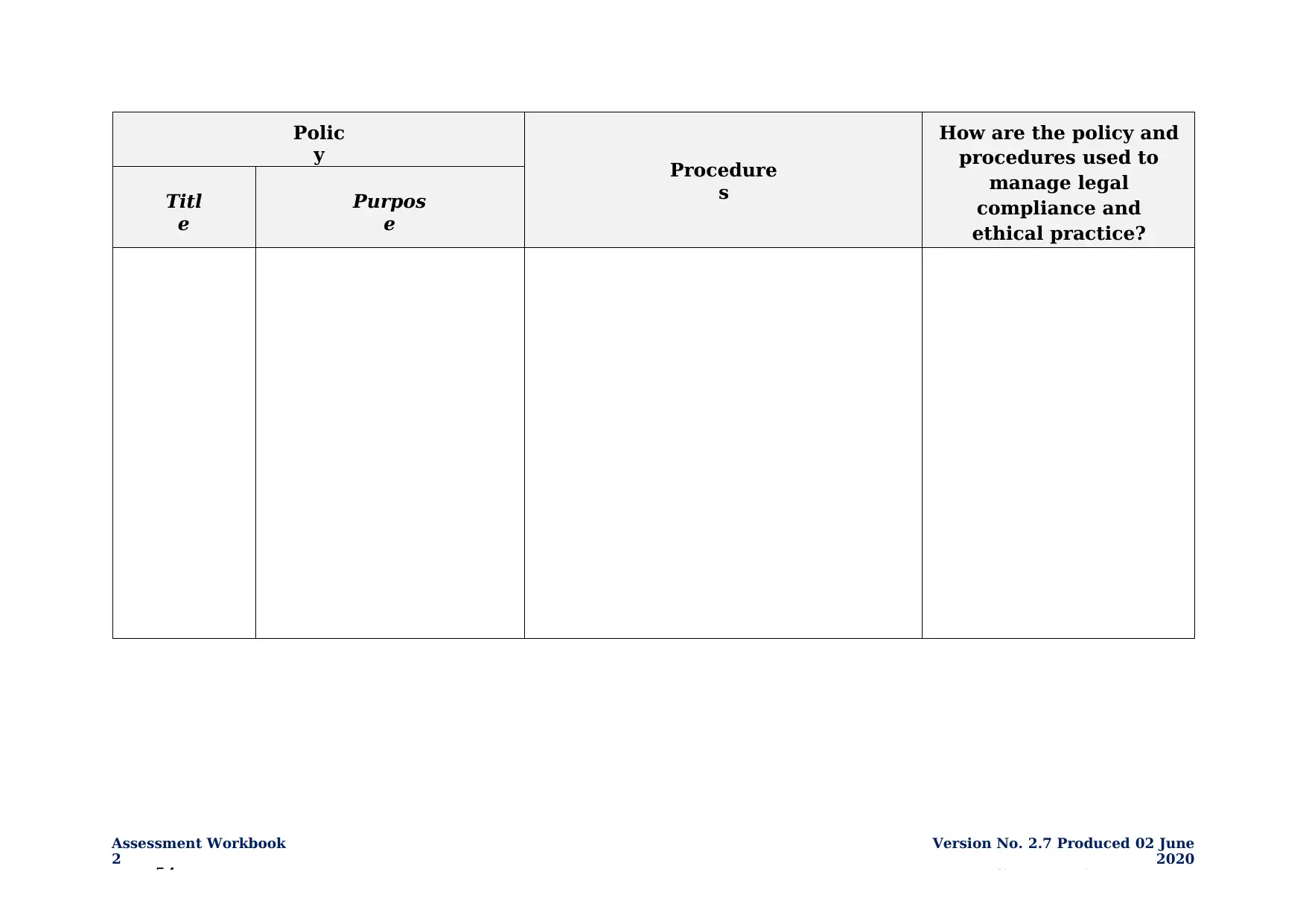
2
Page 54
Version No. 2.7 Produced 02 June
2020
© Compliant Learning Resources
Polic
y Procedure
s
How are the policy and
procedures used to
manage legal
compliance and
ethical practice?
Titl
e
Purpos
e
Paraphrase This Document
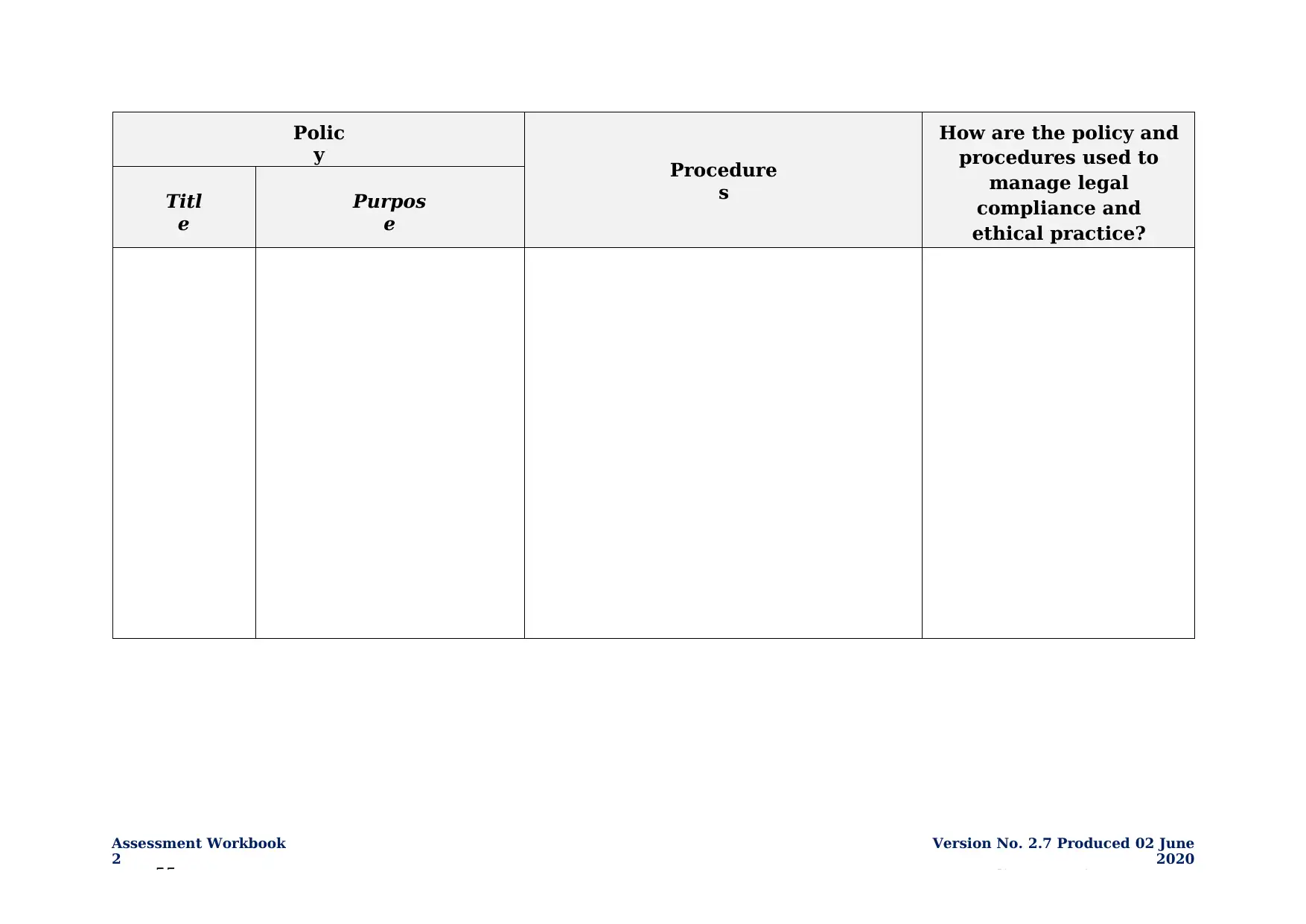
2
Page 55
Version No. 2.7 Produced 02 June
2020
© Compliant Learning Resources
Polic
y Procedure
s
How are the policy and
procedures used to
manage legal
compliance and
ethical practice?
Titl
e
Purpos
e
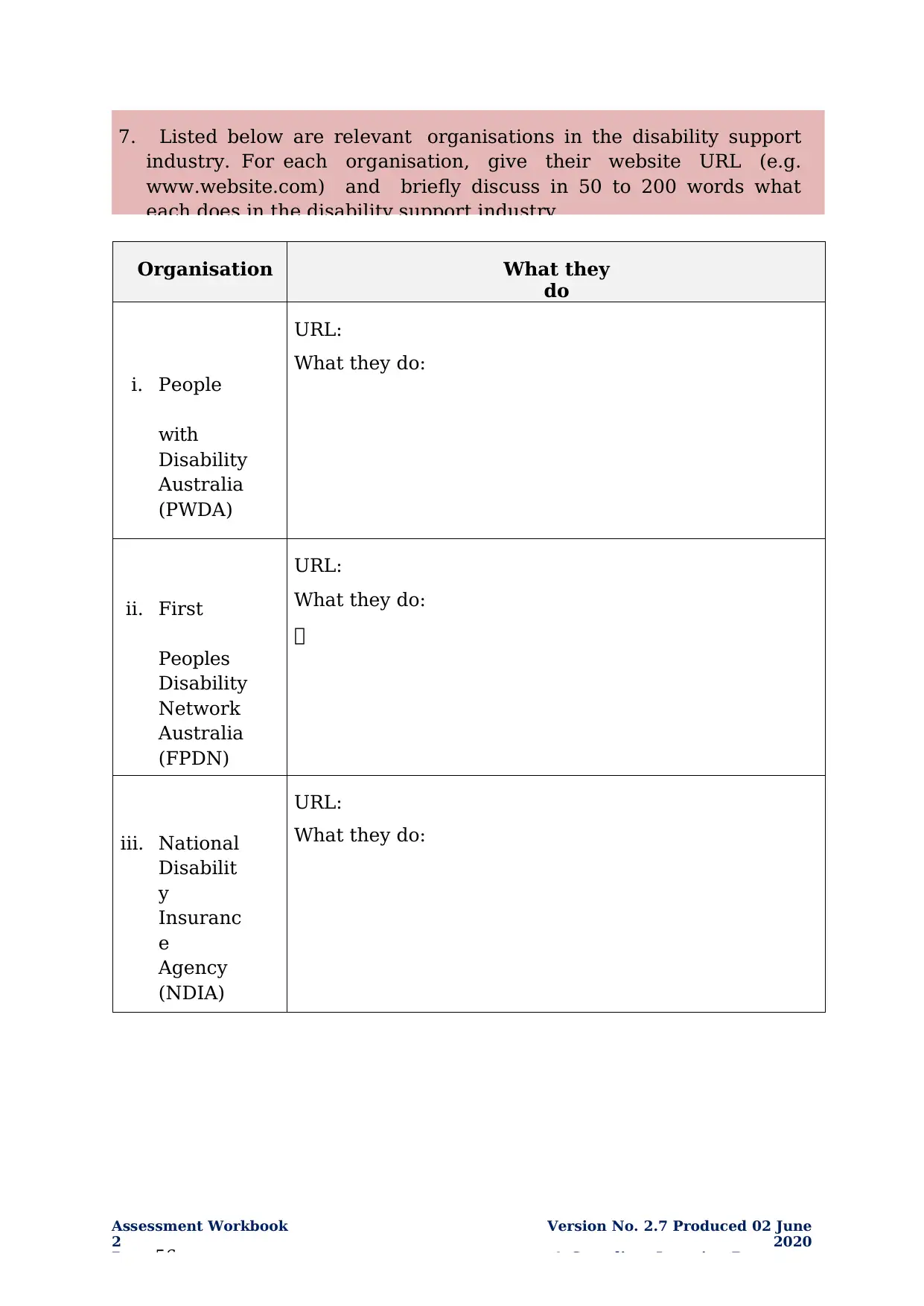
2
Page 56
Version No. 2.7 Produced 02 June
2020
© Compliant Learning Resources
Organisation What they
do
i. People
with
Disability
Australia
(PWDA)
URL:
What they do:
ii. First
Peoples
Disability
Network
Australia
(FPDN)
URL:
What they do:
URL:
iii. National
Disabilit
y
Insuranc
e
Agency
(NDIA)
What they do:
7. Listed below are relevant organisations in the disability support
industry. For each organisation, give their website URL (e.g.
www.website.com) and briefly discuss in 50 to 200 words what
each does in the disability support industry.
You're viewing a preview
Unlock full access by subscribing today!
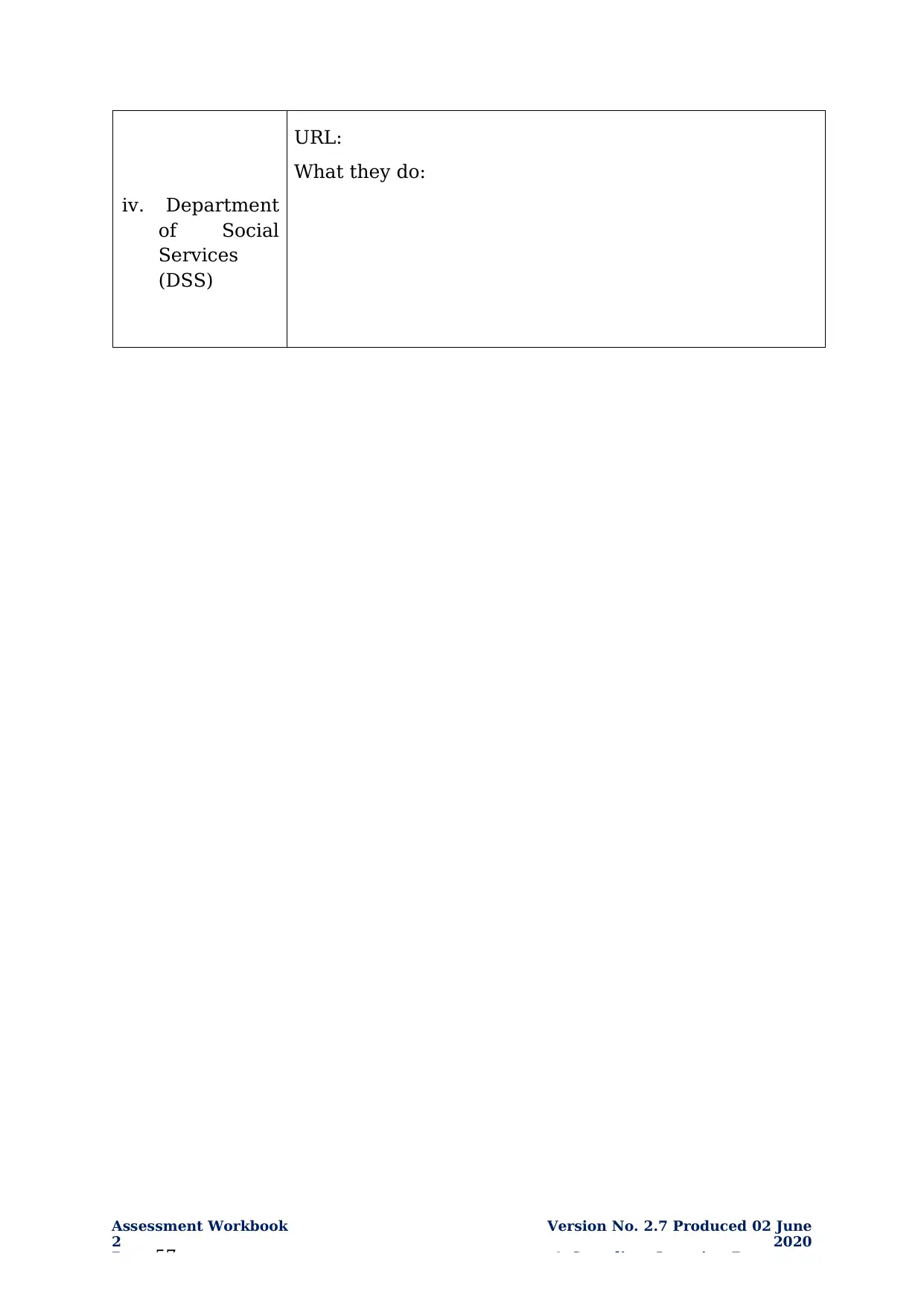
2
Page 57
Version No. 2.7 Produced 02 June
2020
© Compliant Learning Resources
iv. Department
of Social
Services
(DSS)
URL:
What they do:
Paraphrase This Document
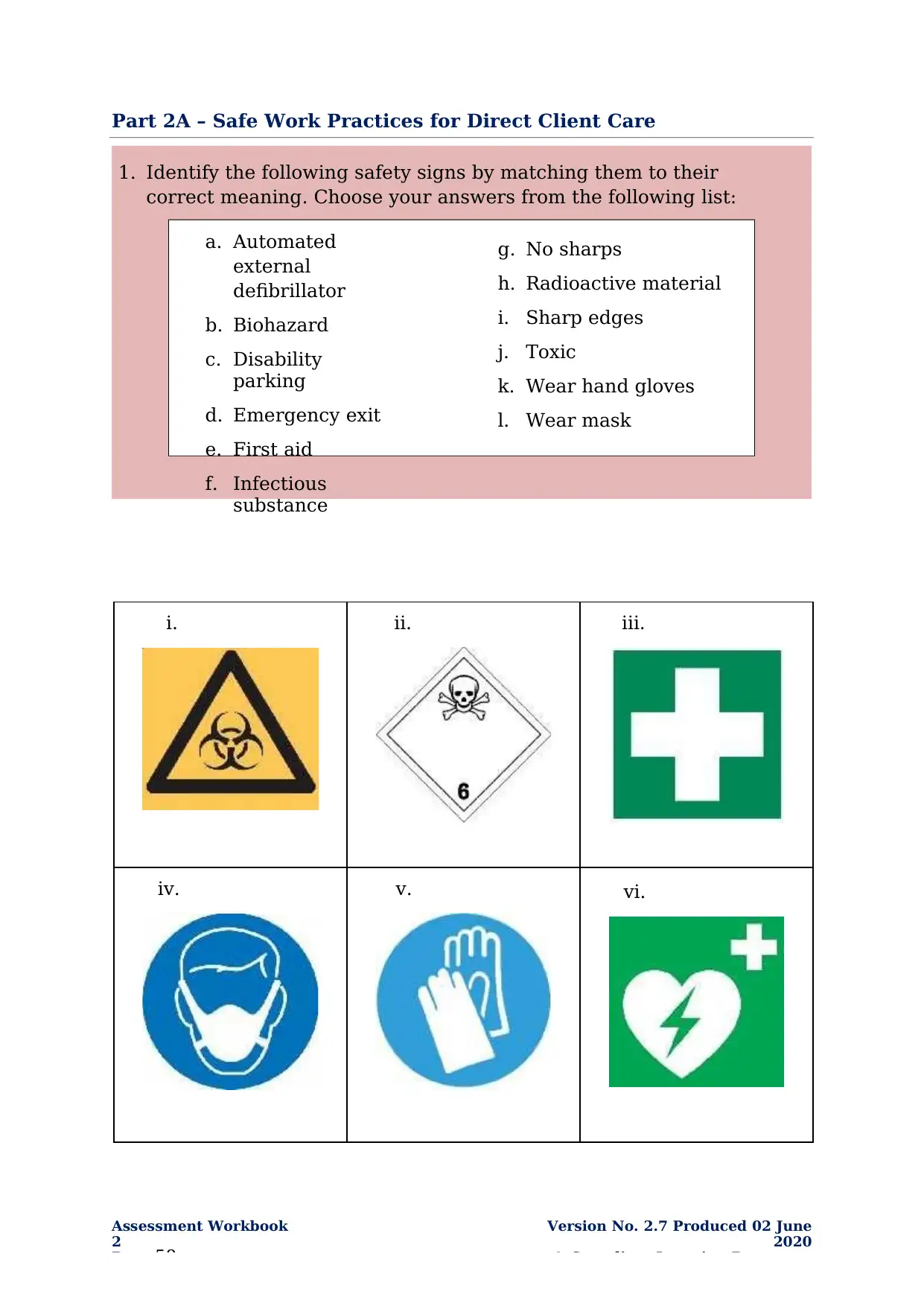
2
Page 58
Version No. 2.7 Produced 02 June
2020
© Compliant Learning Resources
Part 2A – Safe Work Practices for Direct Client Care
1. Identify the following safety signs by matching them to their
correct meaning. Choose your answers from the following list:
a. Automated
external
defibrillator
b. Biohazard
c. Disability
parking
d. Emergency exit
e. First aid
f. Infectious
substance
g. No sharps
h. Radioactive material
i. Sharp edges
j. Toxic
k. Wear hand gloves
l. Wear mask
i. ii. iii.
iv. v. vi.
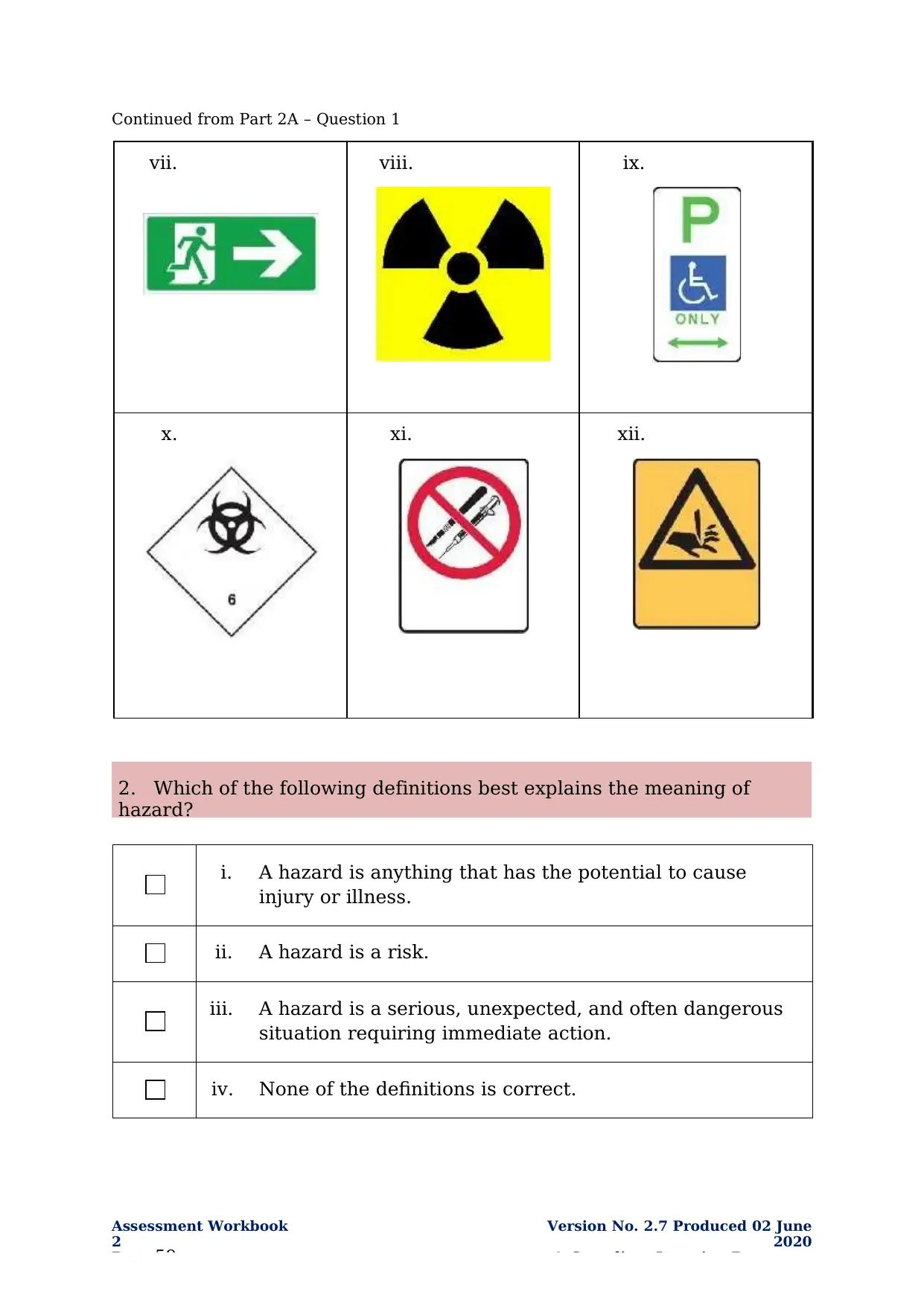
2
Page 59
Version No. 2.7 Produced 02 June
2020
© Compliant Learning Resources
Continued from Part 2A – Question 1
vii. viii. ix.
x. xi. xii.
i. A hazard is anything that has the potential to cause
injury or illness.
ii. A hazard is a risk.
iii. A hazard is a serious, unexpected, and often dangerous
situation requiring immediate action.
iv. None of the definitions is correct.
2. Which of the following definitions best explains the meaning of
hazard?
You're viewing a preview
Unlock full access by subscribing today!
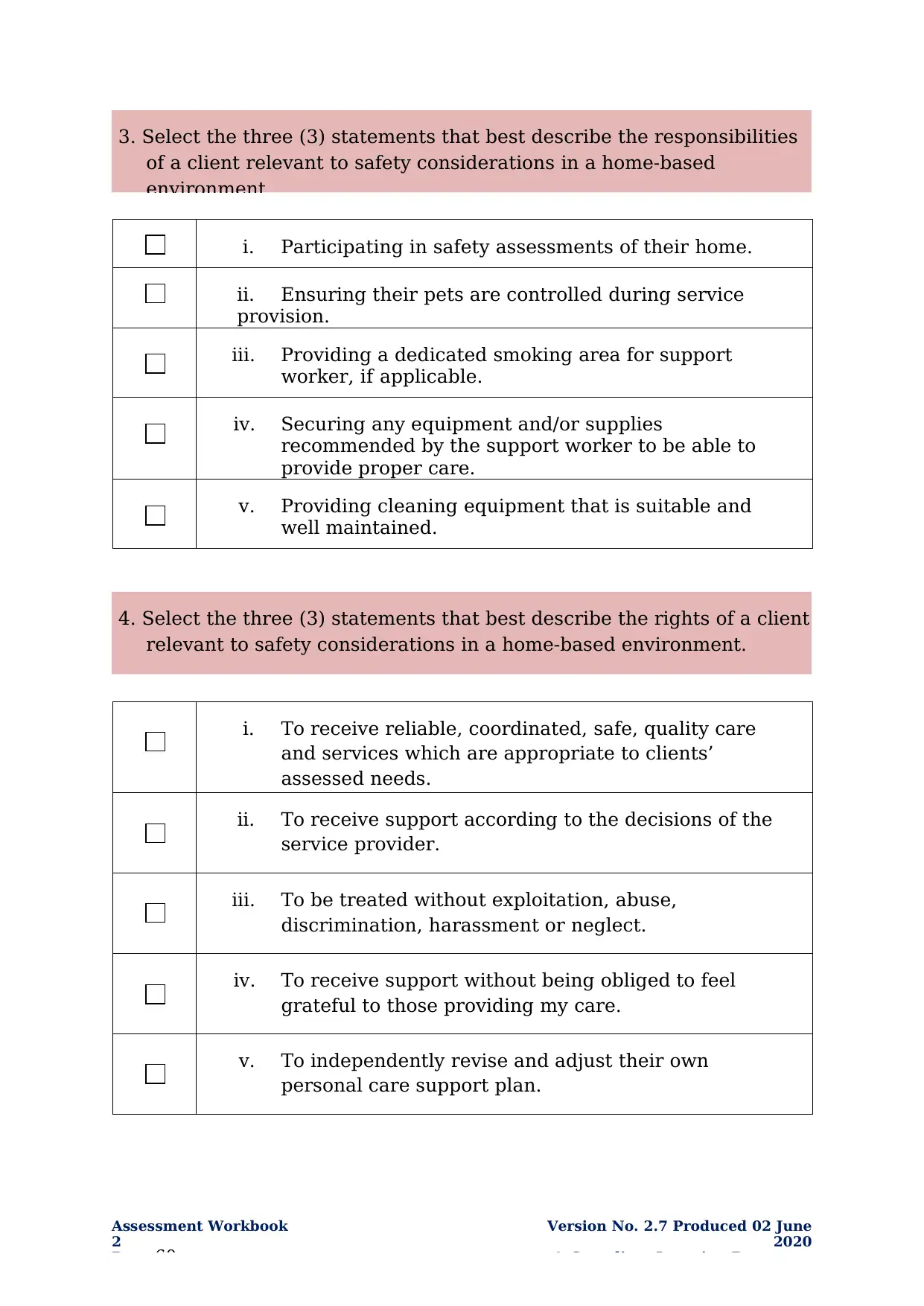
2
Page 60
Version No. 2.7 Produced 02 June
2020
© Compliant Learning Resources
i. Participating in safety assessments of their home.
ii. Ensuring their pets are controlled during service
provision.
iii. Providing a dedicated smoking area for support
worker, if applicable.
iv. Securing any equipment and/or supplies
recommended by the support worker to be able to
provide proper care.
v. Providing cleaning equipment that is suitable and
well maintained.
i. To receive reliable, coordinated, safe, quality care
and services which are appropriate to clients’
assessed needs.
ii. To receive support according to the decisions of the
service provider.
iii. To be treated without exploitation, abuse,
discrimination, harassment or neglect.
iv. To receive support without being obliged to feel
grateful to those providing my care.
v. To independently revise and adjust their own
personal care support plan.
4. Select the three (3) statements that best describe the rights of a client
relevant to safety considerations in a home-based environment.
3. Select the three (3) statements that best describe the responsibilities
of a client relevant to safety considerations in a home-based
environment.
Paraphrase This Document
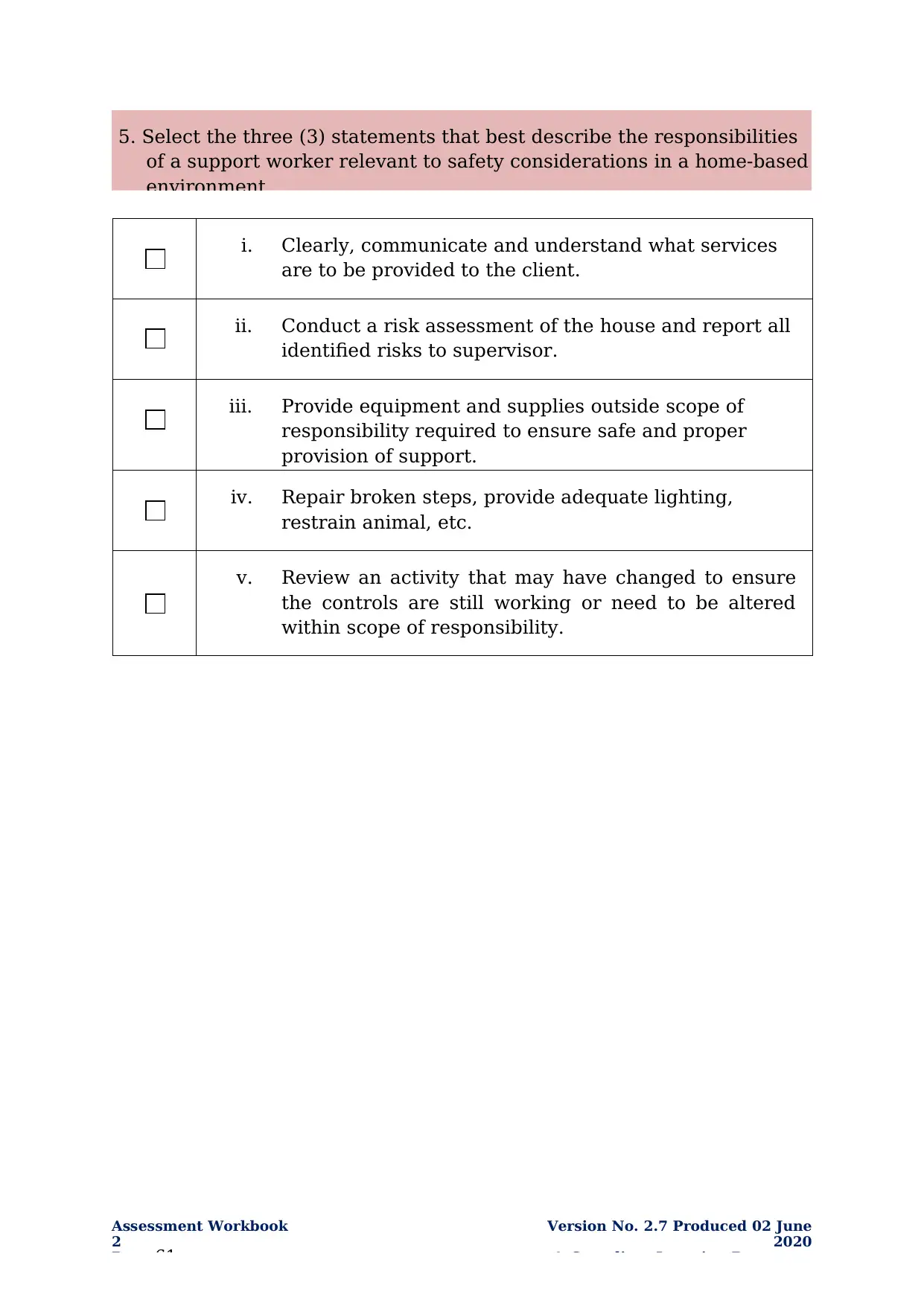
2
Page 61
Version No. 2.7 Produced 02 June
2020
© Compliant Learning Resources
i. Clearly, communicate and understand what services
are to be provided to the client.
ii. Conduct a risk assessment of the house and report all
identified risks to supervisor.
iii. Provide equipment and supplies outside scope of
responsibility required to ensure safe and proper
provision of support.
iv. Repair broken steps, provide adequate lighting,
restrain animal, etc.
v. Review an activity that may have changed to ensure
the controls are still working or need to be altered
within scope of responsibility.
5. Select the three (3) statements that best describe the responsibilities
of a support worker relevant to safety considerations in a home-based
environment.
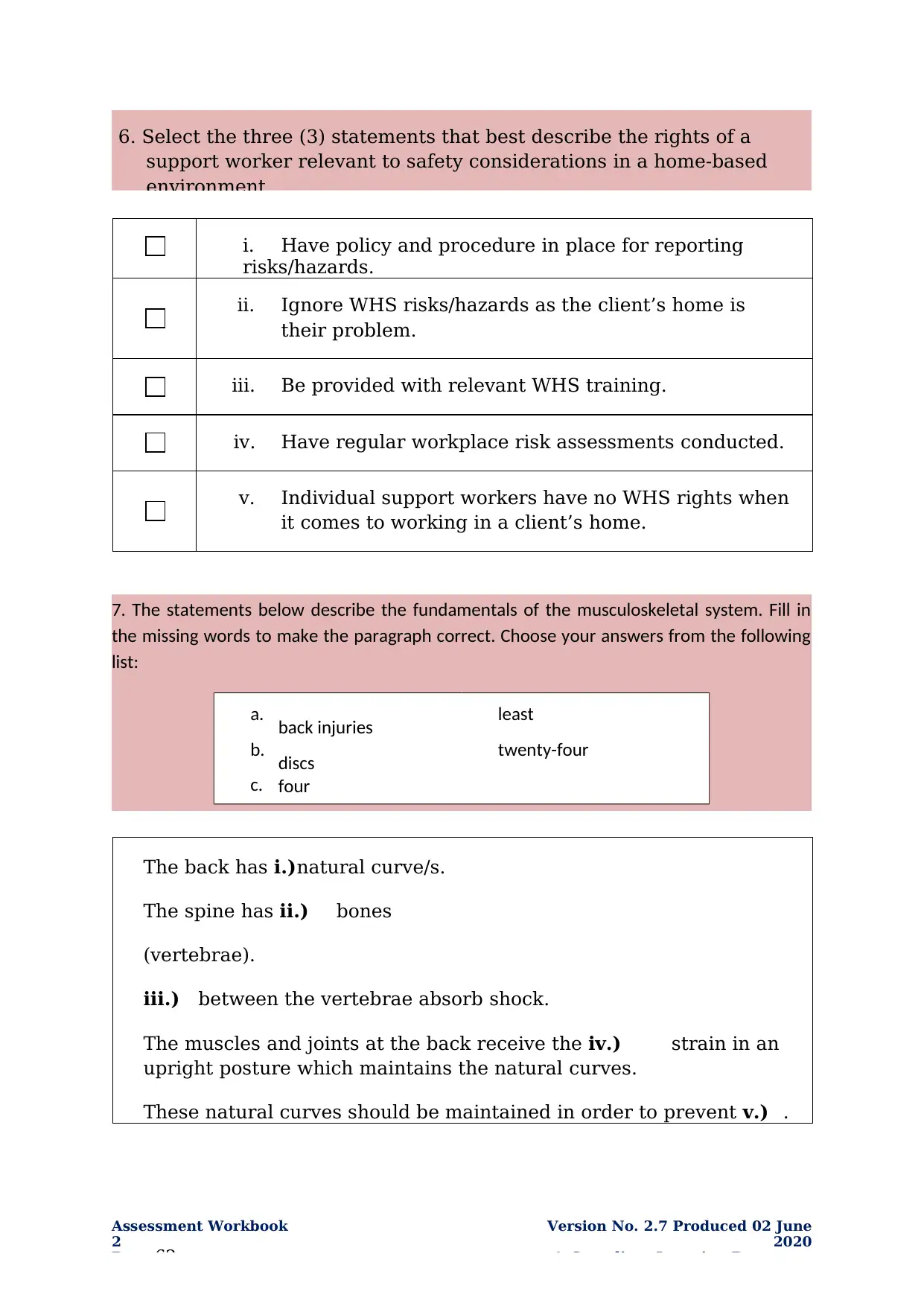
2
Page 62
Version No. 2.7 Produced 02 June
2020
© Compliant Learning Resources
i. Have policy and procedure in place for reporting
risks/hazards.
ii. Ignore WHS risks/hazards as the client’s home is
their problem.
iii. Be provided with relevant WHS training.
iv. Have regular workplace risk assessments conducted.
v. Individual support workers have no WHS rights when
it comes to working in a client’s home.
The back has i.)natural curve/s.
The spine has ii.) bones
(vertebrae).
iii.) between the vertebrae absorb shock.
The muscles and joints at the back receive the iv.) strain in an
upright posture which maintains the natural curves.
These natural curves should be maintained in order to prevent v.) .
a.
b.
c.
back injuries
discs
four
least
twenty-four
7. The statements below describe the fundamentals of the musculoskeletal system. Fill in
the missing words to make the paragraph correct. Choose your answers from the following
list:
6. Select the three (3) statements that best describe the rights of a
support worker relevant to safety considerations in a home-based
environment.
You're viewing a preview
Unlock full access by subscribing today!
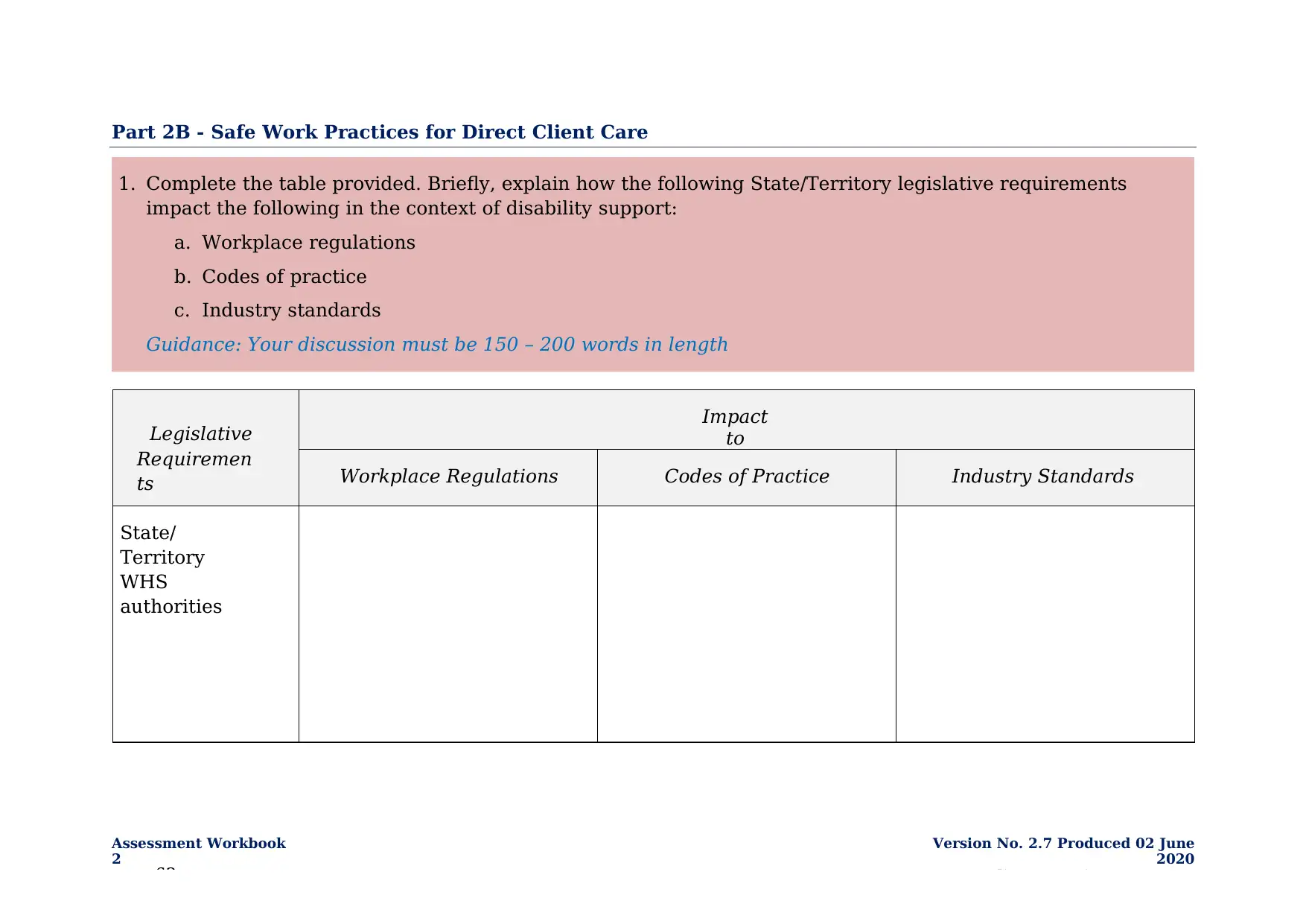
2
Page 63
Version No. 2.7 Produced 02 June
2020
© Compliant Learning Resources
Part 2B - Safe Work Practices for Direct Client Care
Legislative
Requiremen
ts
Impact
to
Workplace Regulations Codes of Practice Industry Standards
State/
Territory
WHS
authorities
1. Complete the table provided. Briefly, explain how the following State/Territory legislative requirements
impact the following in the context of disability support:
a. Workplace regulations
b. Codes of practice
c. Industry standards
Guidance: Your discussion must be 150 – 200 words in length
Paraphrase This Document
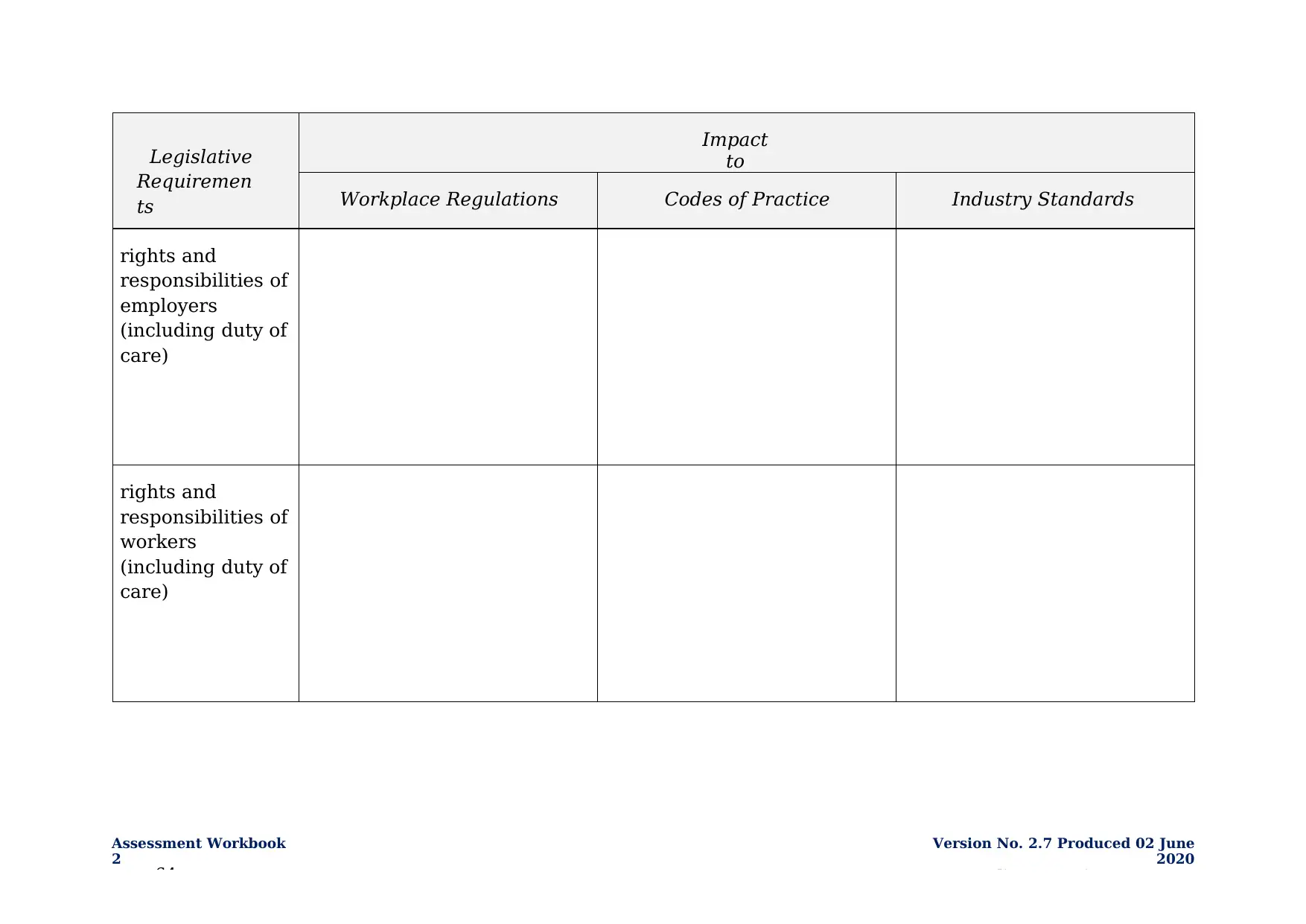
2
Page 64
Version No. 2.7 Produced 02 June
2020
© Compliant Learning Resources
Legislative
Requiremen
ts
Impact
to
Workplace Regulations Codes of Practice Industry Standards
rights and
responsibilities of
employers
(including duty of
care)
rights and
responsibilities of
workers
(including duty of
care)
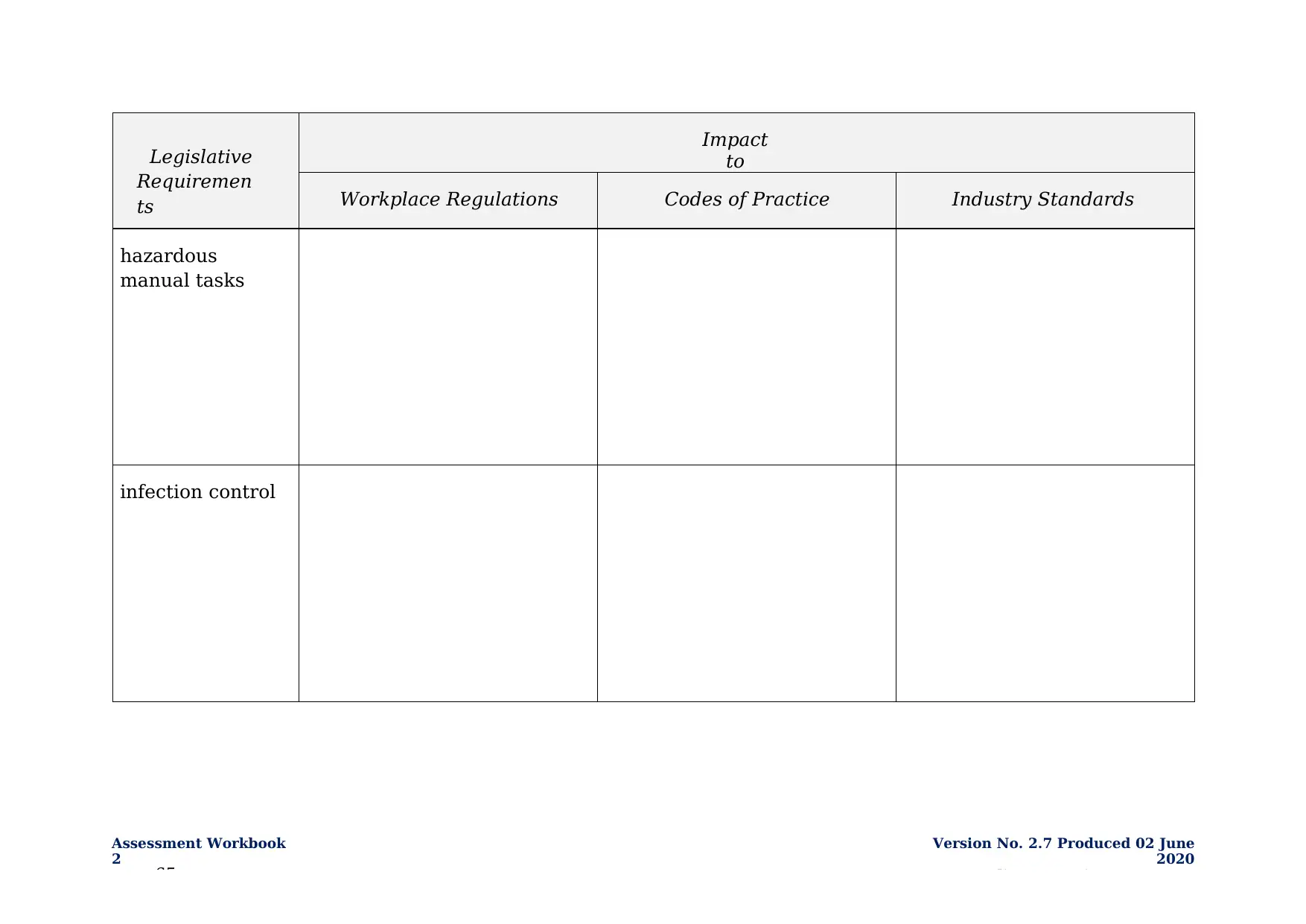
2
Page 65
Version No. 2.7 Produced 02 June
2020
© Compliant Learning Resources
Legislative
Requiremen
ts
Impact
to
Workplace Regulations Codes of Practice Industry Standards
hazardous
manual tasks
infection control
You're viewing a preview
Unlock full access by subscribing today!
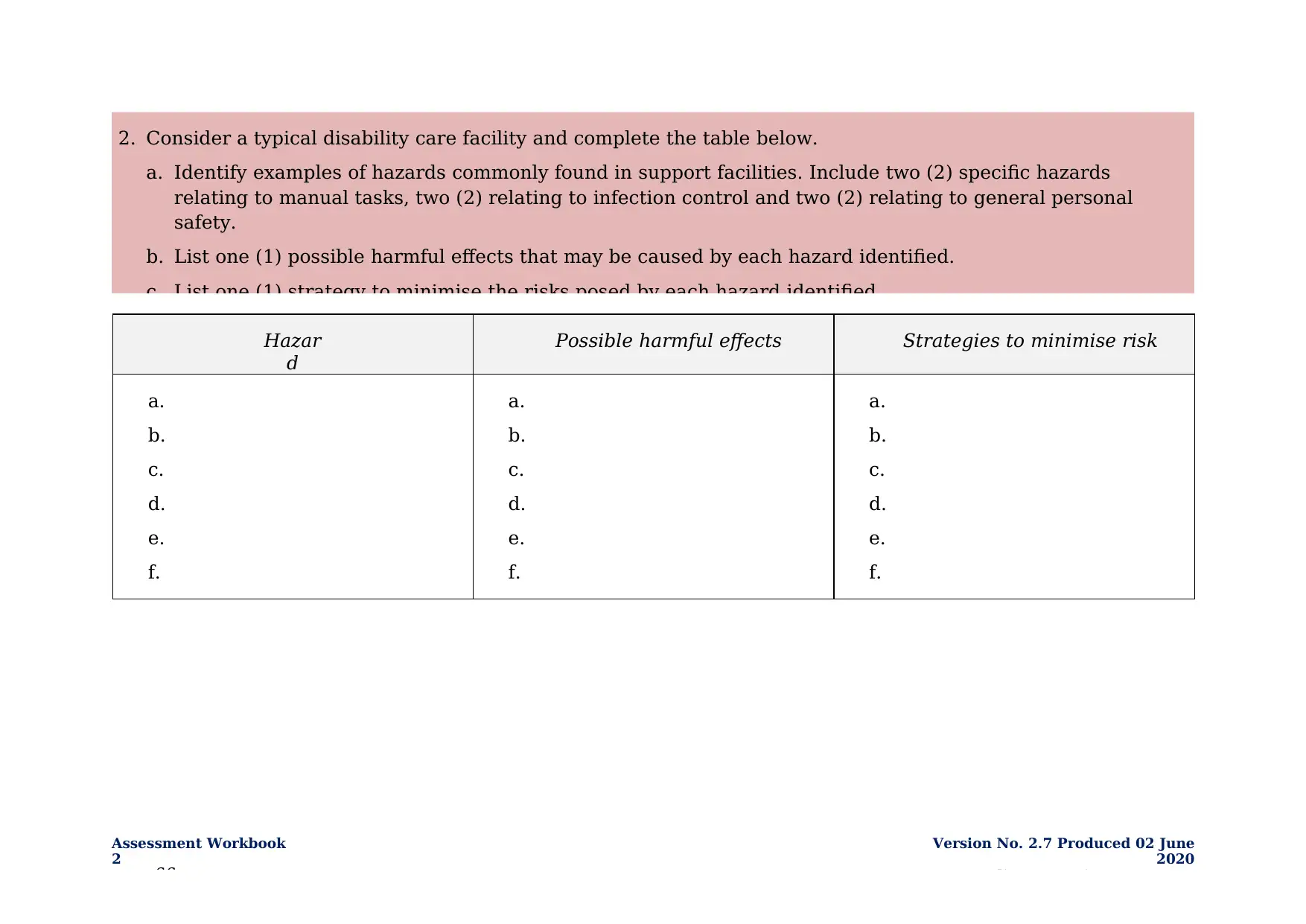
2
Page 66
Version No. 2.7 Produced 02 June
2020
© Compliant Learning Resources
Hazar
d
Possible harmful effects Strategies to minimise risk
a.
b.
c.
d.
e.
f.
a.
b.
c.
d.
e.
f.
a.
b.
c.
d.
e.
f.
2. Consider a typical disability care facility and complete the table below.
a. Identify examples of hazards commonly found in support facilities. Include two (2) specific hazards
relating to manual tasks, two (2) relating to infection control and two (2) relating to general personal
safety.
b. List one (1) possible harmful effects that may be caused by each hazard identified.
c. List one (1) strategy to minimise the risks posed by each hazard identified.
Paraphrase This Document
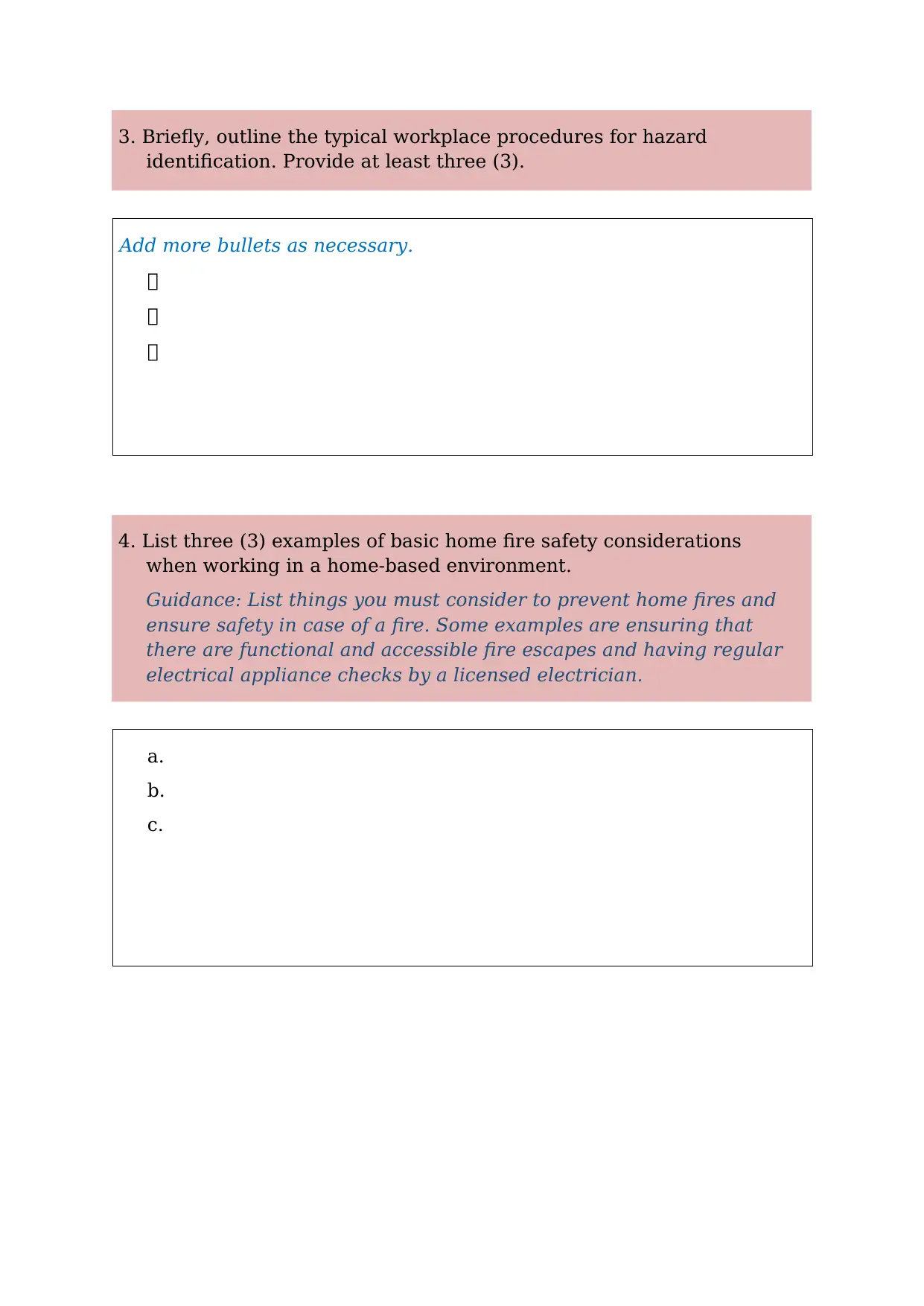
a.
b.
c.
4. List three (3) examples of basic home fire safety considerations
when working in a home-based environment.
Guidance: List things you must consider to prevent home fires and
ensure safety in case of a fire. Some examples are ensuring that
there are functional and accessible fire escapes and having regular
electrical appliance checks by a licensed electrician.
3. Briefly, outline the typical workplace procedures for hazard
identification. Provide at least three (3).
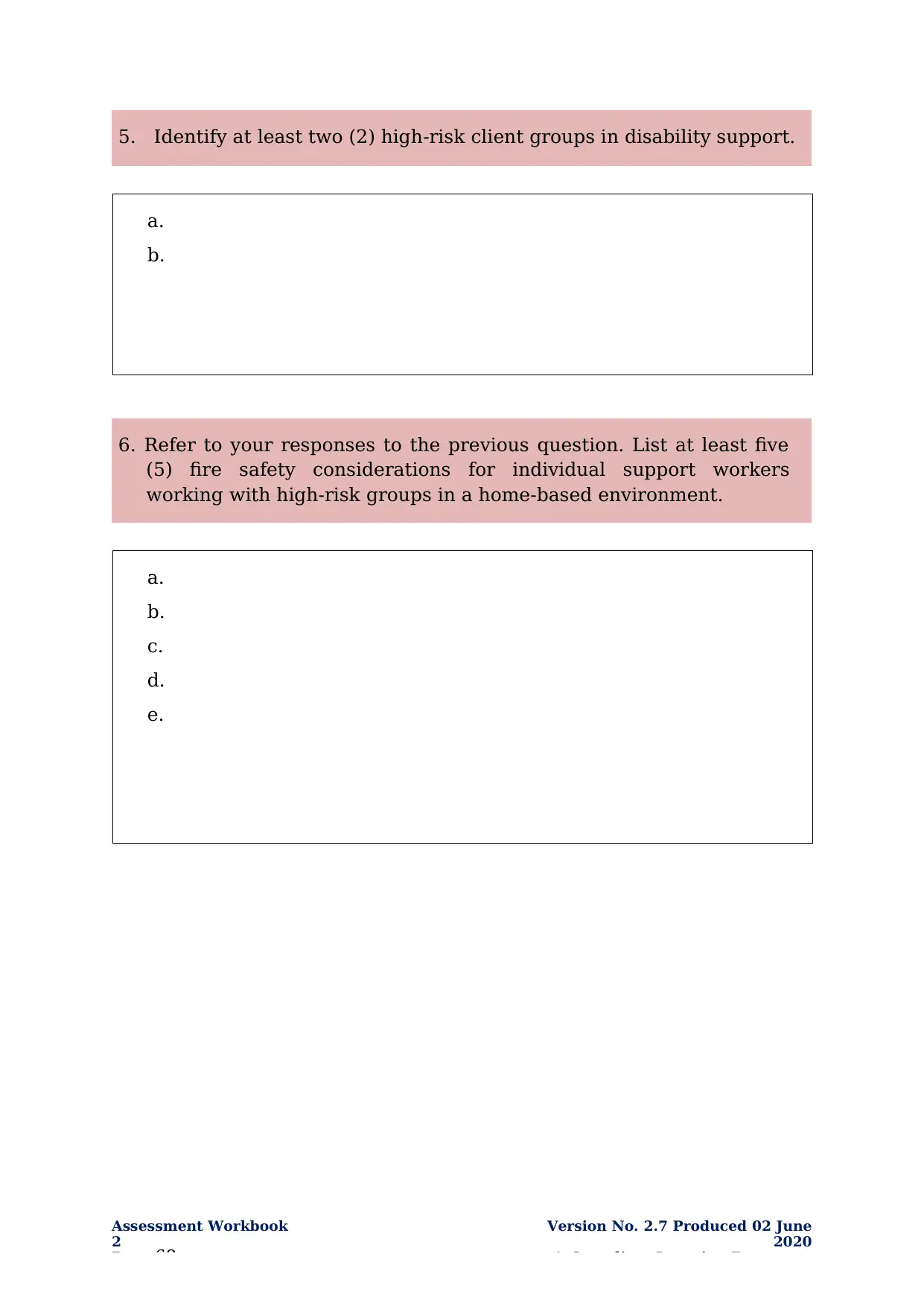
2
Page 68
Version No. 2.7 Produced 02 June
2020
© Compliant Learning Resources
a.
b.
a.
b.
c.
d.
e.
6. Refer to your responses to the previous question. List at least five
(5) fire safety considerations for individual support workers
working with high-risk groups in a home-based environment.
5. Identify at least two (2) high-risk client groups in disability support.
You're viewing a preview
Unlock full access by subscribing today!
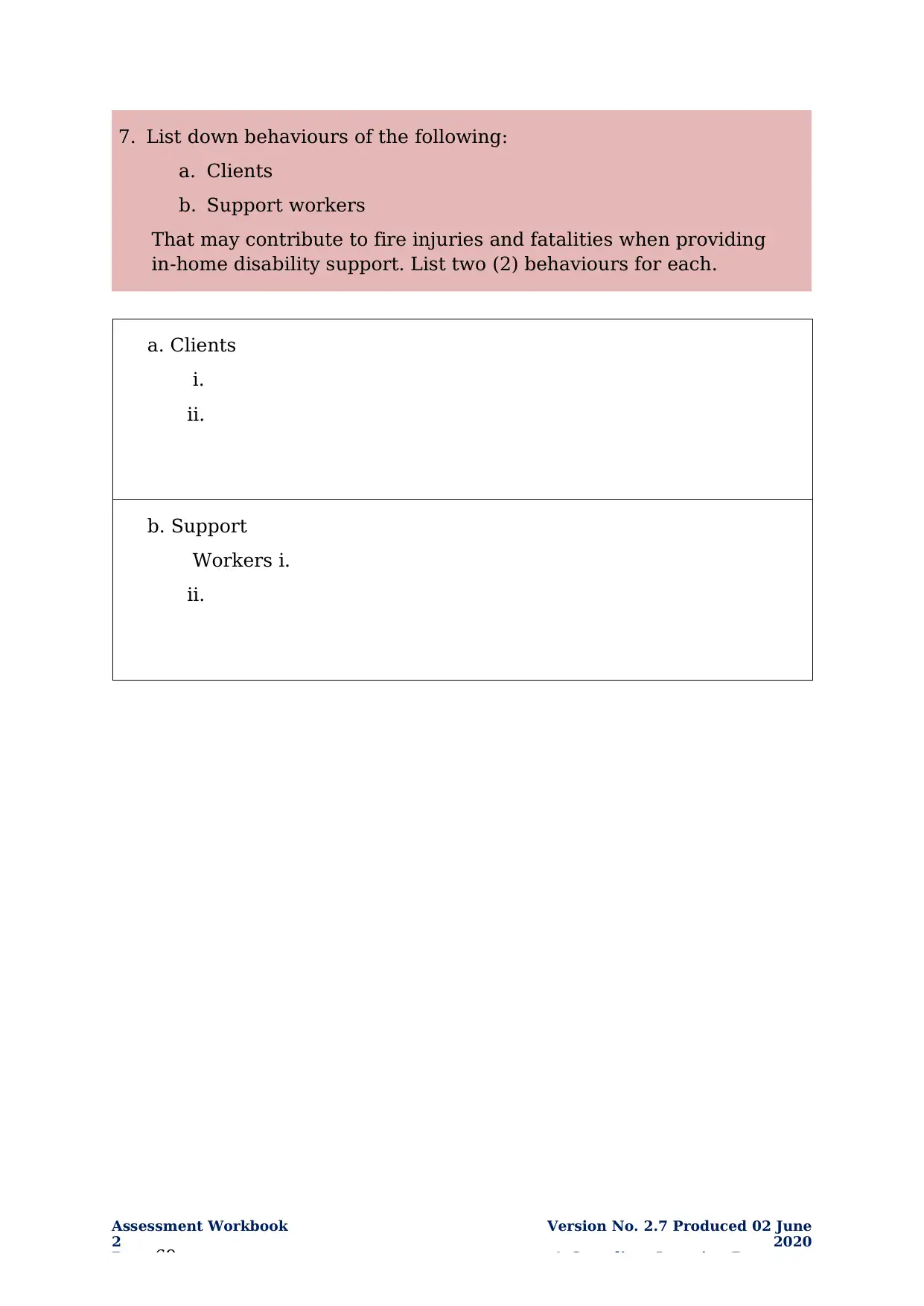
2
Page 69
Version No. 2.7 Produced 02 June
2020
© Compliant Learning Resources
a. Clients
i.
ii.
b. Support
Workers i.
ii.
7. List down behaviours of the following:
a. Clients
b. Support workers
That may contribute to fire injuries and fatalities when providing
in-home disability support. List two (2) behaviours for each.
Paraphrase This Document
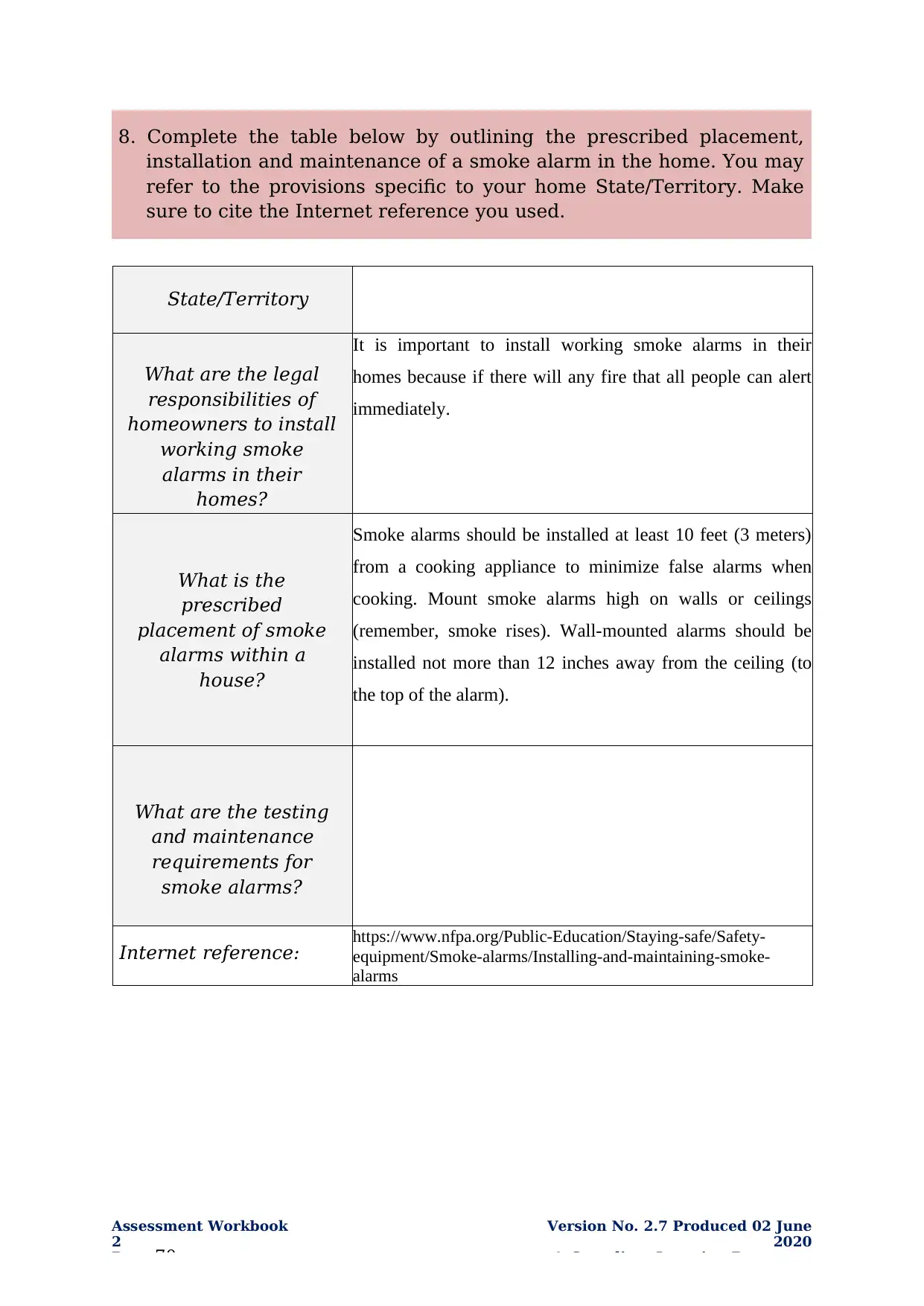
2
Page 70
Version No. 2.7 Produced 02 June
2020
© Compliant Learning Resources
State/Territory
What are the legal
responsibilities of
homeowners to install
working smoke
alarms in their
homes?
It is important to install working smoke alarms in their
homes because if there will any fire that all people can alert
immediately.
What is the
prescribed
placement of smoke
alarms within a
house?
Smoke alarms should be installed at least 10 feet (3 meters)
from a cooking appliance to minimize false alarms when
cooking. Mount smoke alarms high on walls or ceilings
(remember, smoke rises). Wall-mounted alarms should be
installed not more than 12 inches away from the ceiling (to
the top of the alarm).
What are the testing
and maintenance
requirements for
smoke alarms?
Internet reference: https://www.nfpa.org/Public-Education/Staying-safe/Safety-
equipment/Smoke-alarms/Installing-and-maintaining-smoke-
alarms
8. Complete the table below by outlining the prescribed placement,
installation and maintenance of a smoke alarm in the home. You may
refer to the provisions specific to your home State/Territory. Make
sure to cite the Internet reference you used.
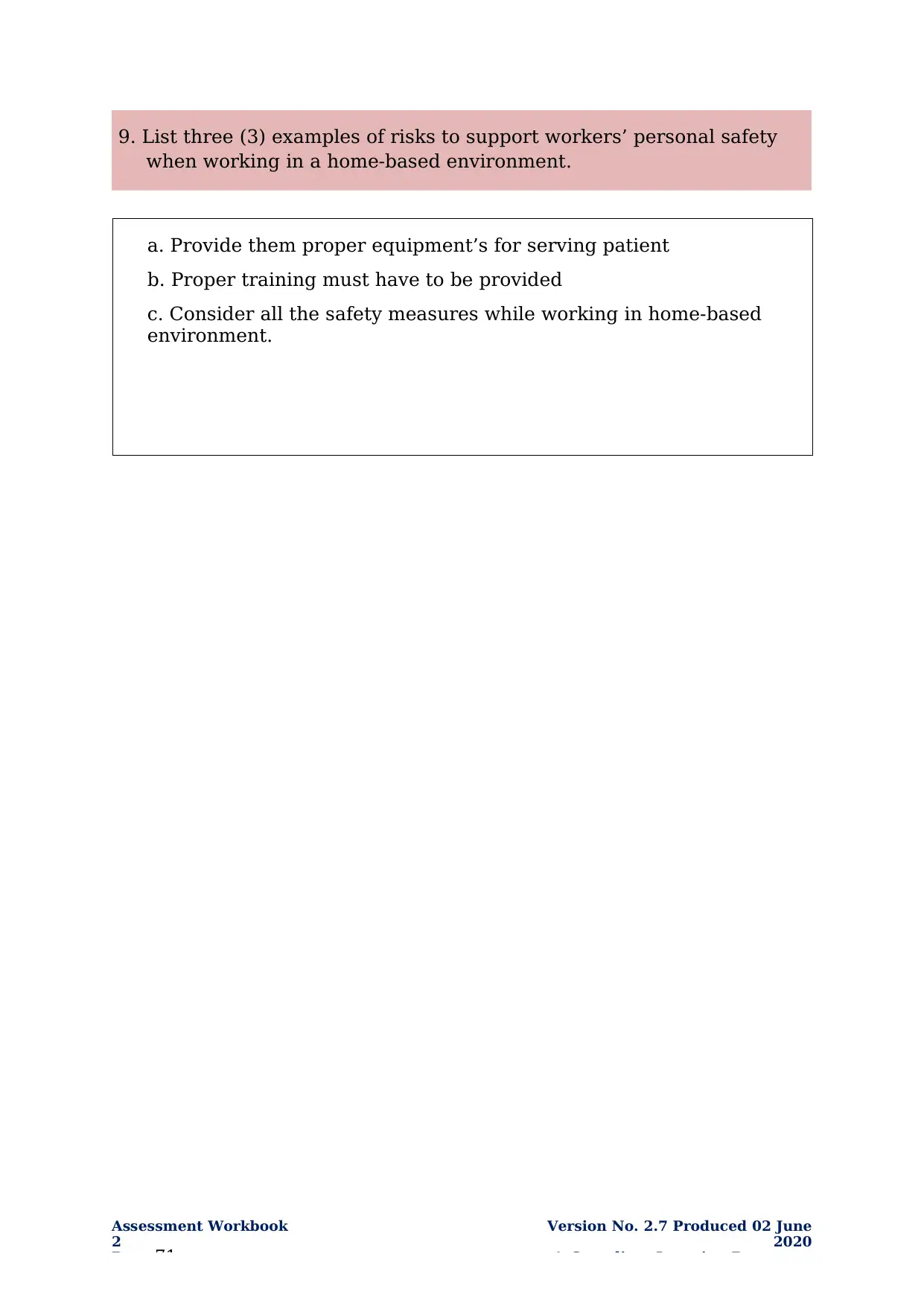
2
Page 71
Version No. 2.7 Produced 02 June
2020
© Compliant Learning Resources
a. Provide them proper equipment’s for serving patient
b. Proper training must have to be provided
c. Consider all the safety measures while working in home-based
environment.
9. List three (3) examples of risks to support workers’ personal safety
when working in a home-based environment.
You're viewing a preview
Unlock full access by subscribing today!
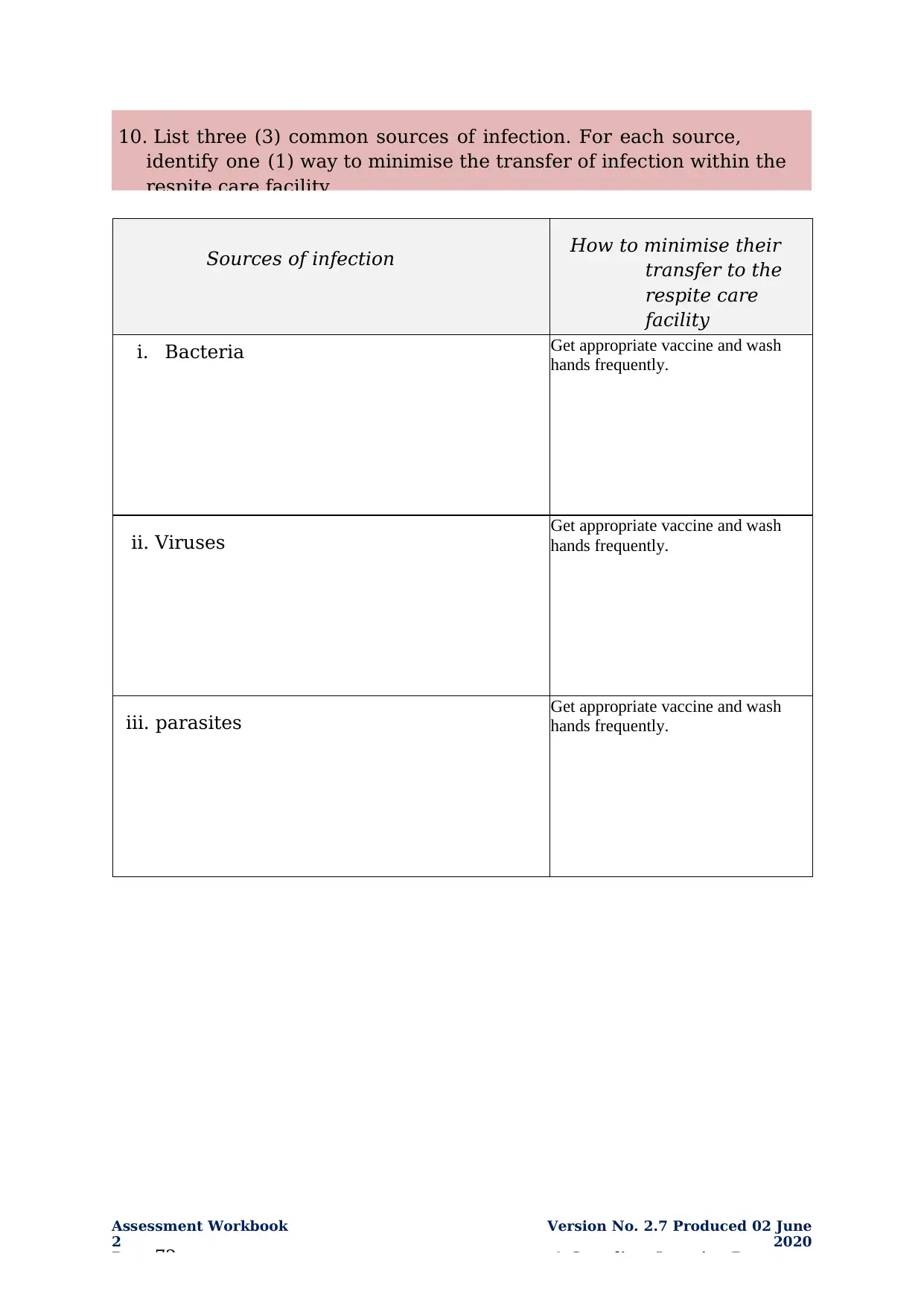
2
Page 72
Version No. 2.7 Produced 02 June
2020
© Compliant Learning Resources
Sources of infection How to minimise their
transfer to the
respite care
facility
i. Bacteria Get appropriate vaccine and wash
hands frequently.
ii. Viruses Get appropriate vaccine and wash
hands frequently.
iii. parasites Get appropriate vaccine and wash
hands frequently.
10. List three (3) common sources of infection. For each source,
identify one (1) way to minimise the transfer of infection within the
respite care facility.
Paraphrase This Document
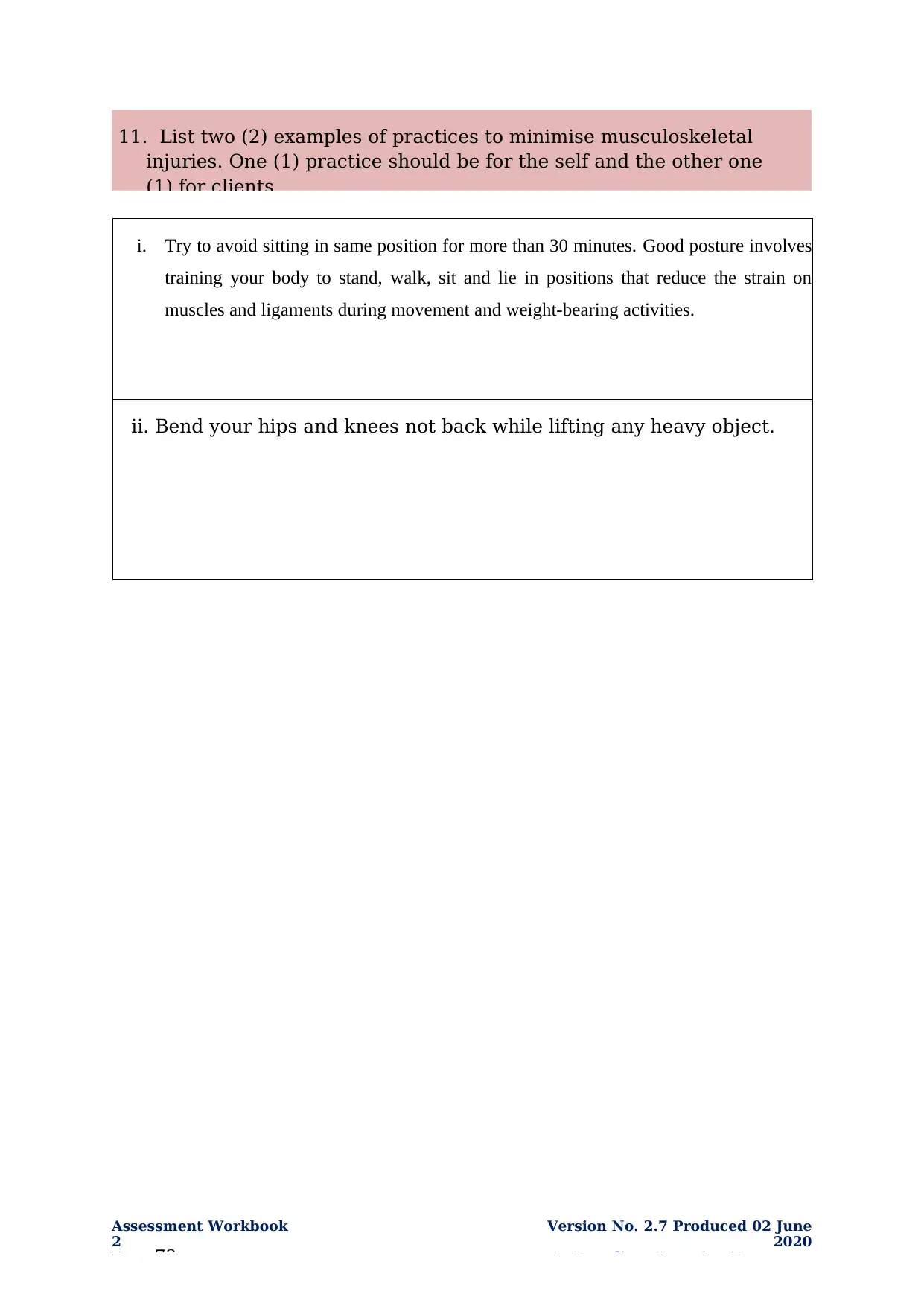
2
Page 73
Version No. 2.7 Produced 02 June
2020
© Compliant Learning Resources
i. Try to avoid sitting in same position for more than 30 minutes. Good posture involves
training your body to stand, walk, sit and lie in positions that reduce the strain on
muscles and ligaments during movement and weight-bearing activities.
ii. Bend your hips and knees not back while lifting any heavy object.
11. List two (2) examples of practices to minimise musculoskeletal
injuries. One (1) practice should be for the self and the other one
(1) for clients.
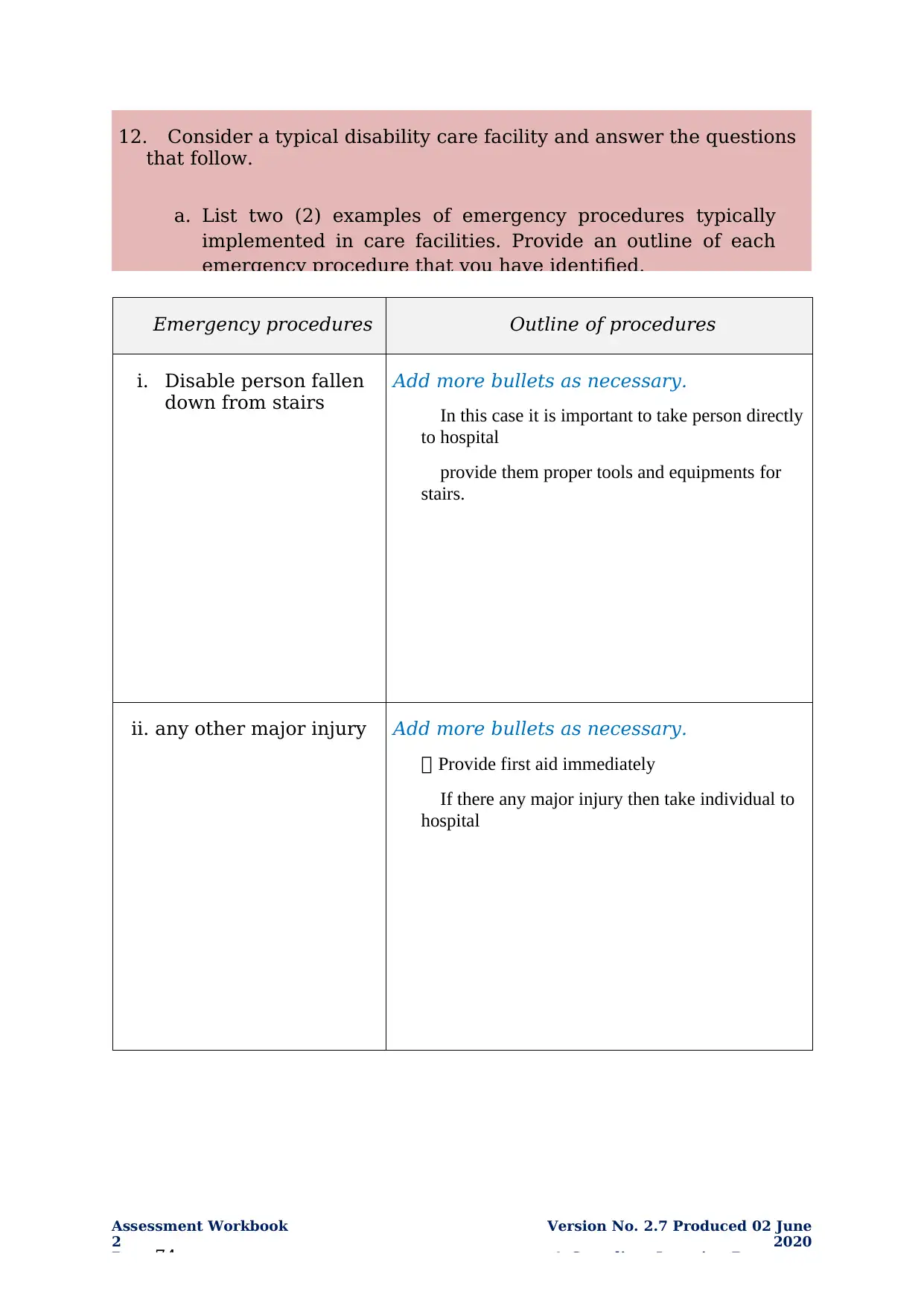
2
Page 74
Version No. 2.7 Produced 02 June
2020
© Compliant Learning Resources
Emergency procedures Outline of procedures
i. Disable person fallen
down from stairs
Add more bullets as necessary.
In this case it is important to take person directly
to hospital
provide them proper tools and equipments for
stairs.
ii. any other major injury Add more bullets as necessary.
Provide first aid immediately
If there any major injury then take individual to
hospital
12. Consider a typical disability care facility and answer the questions
that follow.
a. List two (2) examples of emergency procedures typically
implemented in care facilities. Provide an outline of each
emergency procedure that you have identified.
You're viewing a preview
Unlock full access by subscribing today!
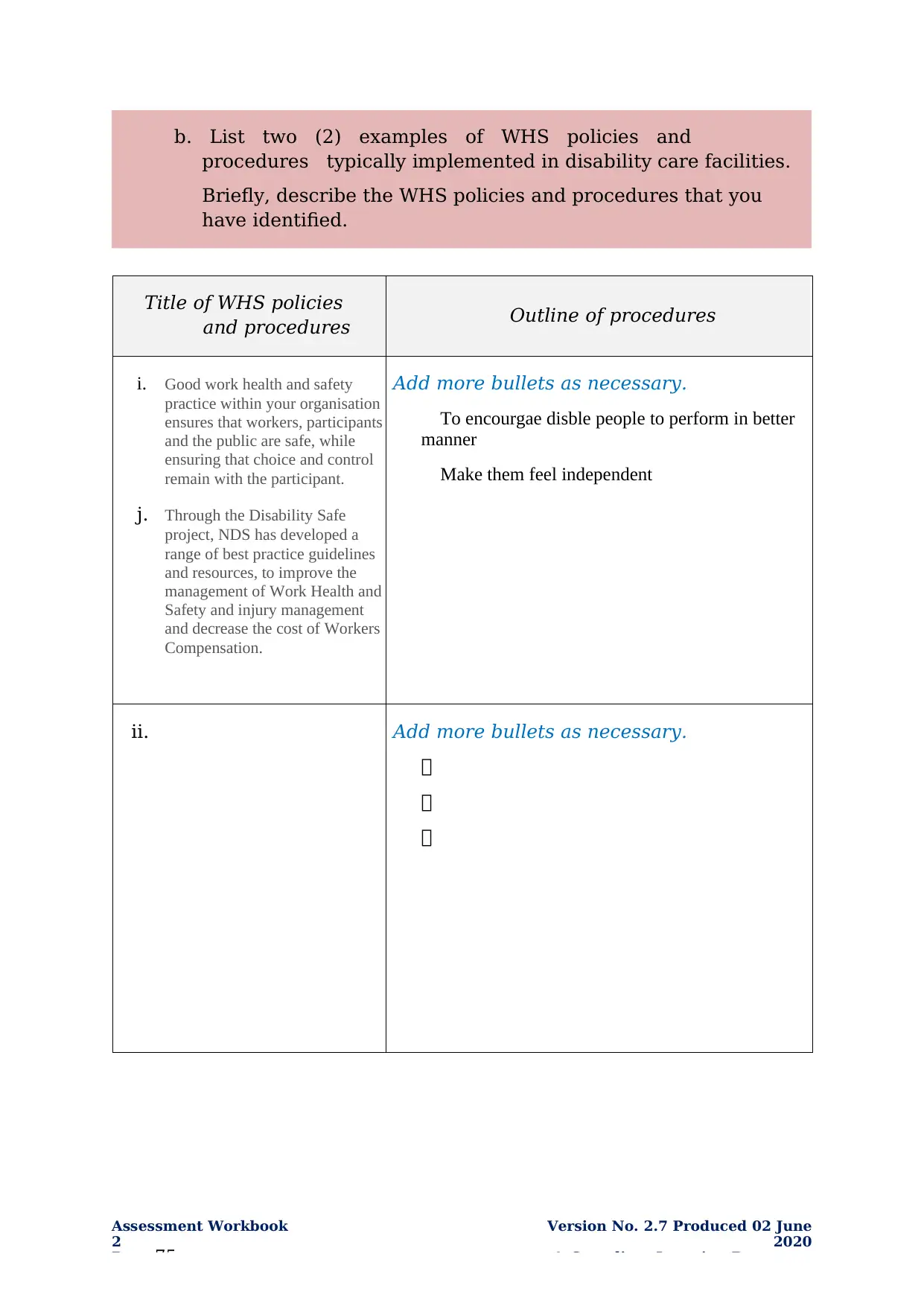
2
Page 75
Version No. 2.7 Produced 02 June
2020
© Compliant Learning Resources
Title of WHS policies
and procedures Outline of procedures
i. Good work health and safety
practice within your organisation
ensures that workers, participants
and the public are safe, while
ensuring that choice and control
remain with the participant.
j. Through the Disability Safe
project, NDS has developed a
range of best practice guidelines
and resources, to improve the
management of Work Health and
Safety and injury management
and decrease the cost of Workers
Compensation.
Add more bullets as necessary.
To encourgae disble people to perform in better
manner
Make them feel independent
ii. Add more bullets as necessary.
b. List two (2) examples of WHS policies and
procedures typically implemented in disability care facilities.
Briefly, describe the WHS policies and procedures that you
have identified.
Paraphrase This Document
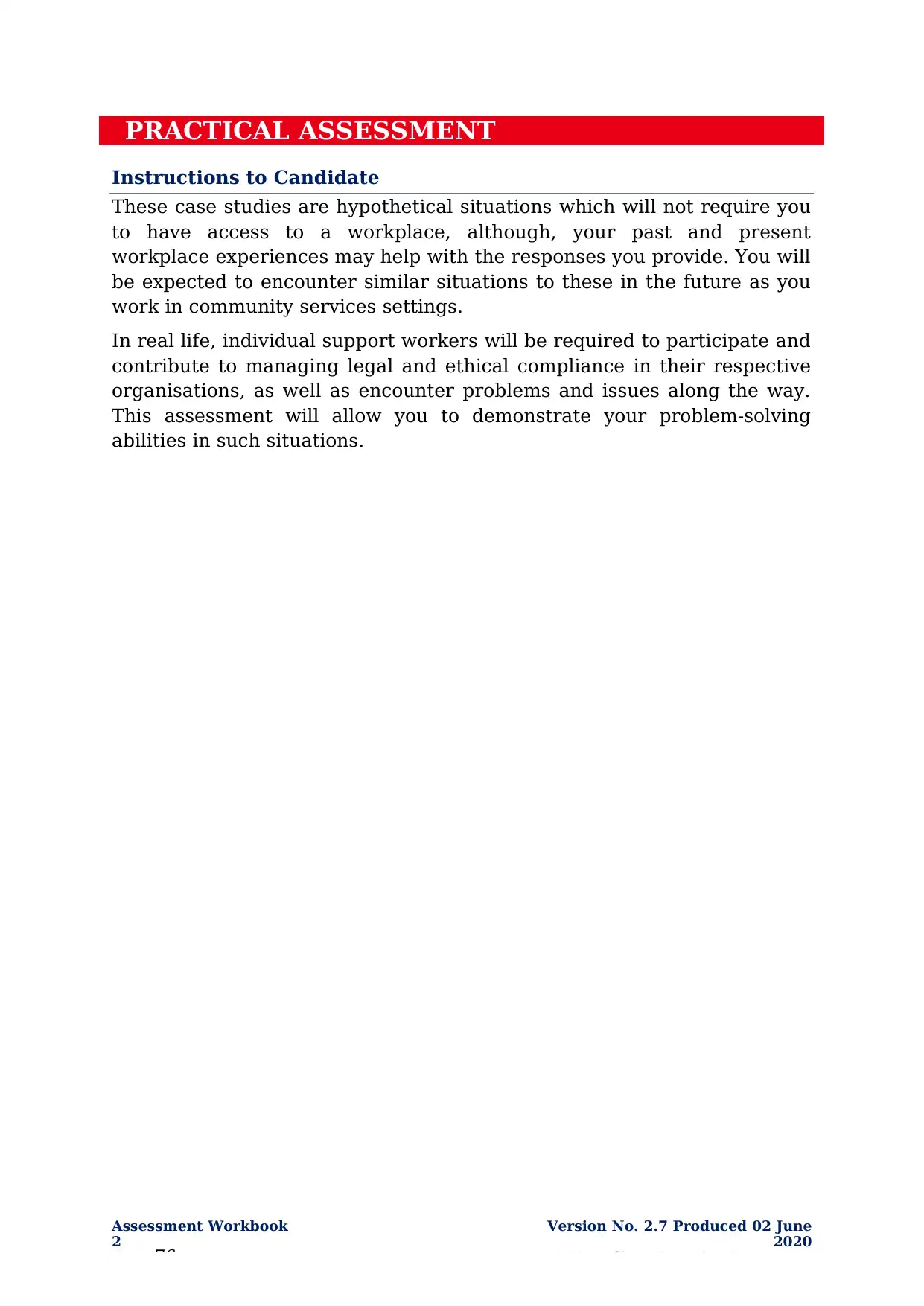
2
Page 76
Version No. 2.7 Produced 02 June
2020
© Compliant Learning Resources
PRACTICAL ASSESSMENT
Instructions to Candidate
These case studies are hypothetical situations which will not require you
to have access to a workplace, although, your past and present
workplace experiences may help with the responses you provide. You will
be expected to encounter similar situations to these in the future as you
work in community services settings.
In real life, individual support workers will be required to participate and
contribute to managing legal and ethical compliance in their respective
organisations, as well as encounter problems and issues along the way.
This assessment will allow you to demonstrate your problem-solving
abilities in such situations.
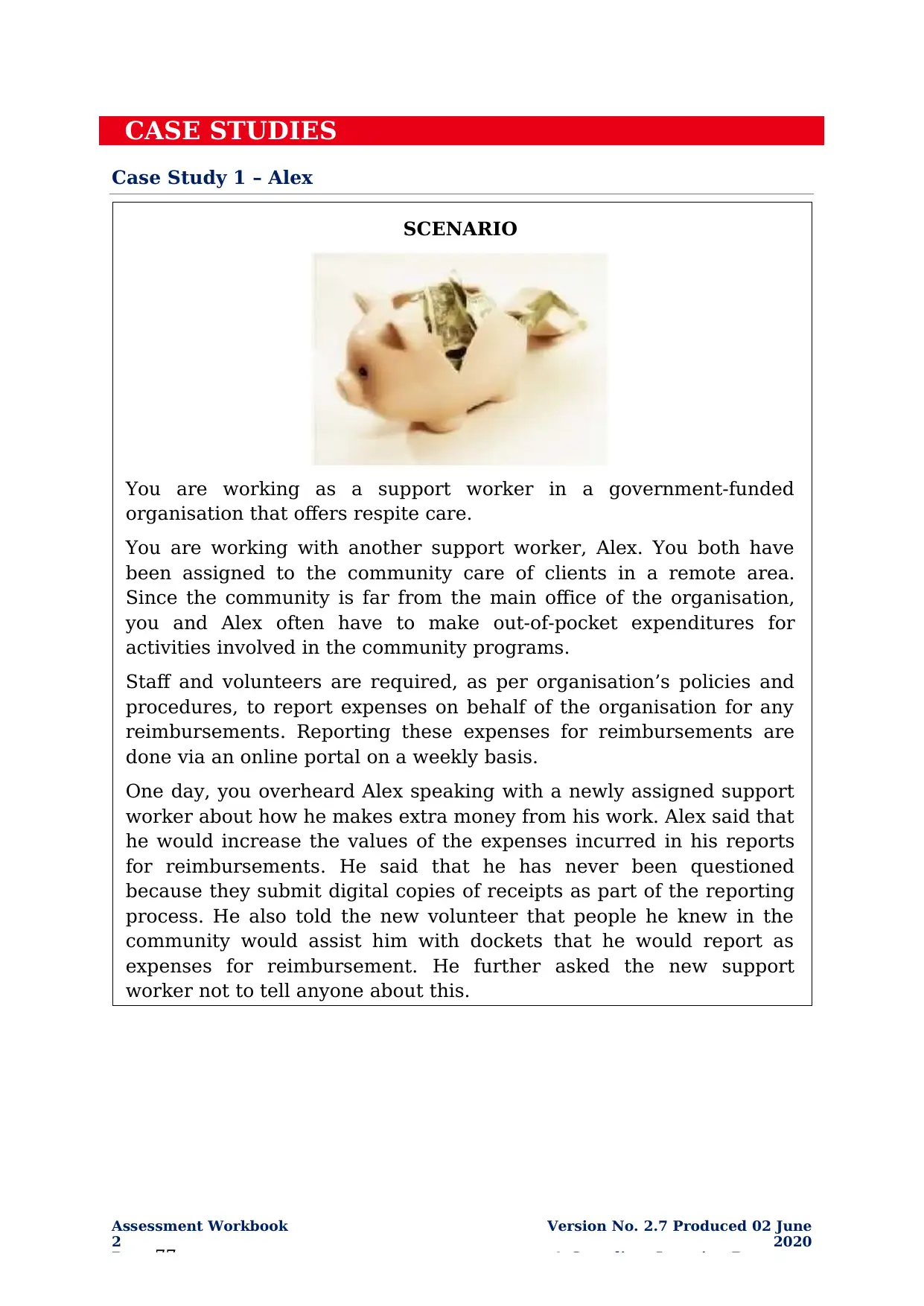
2
Page 77
Version No. 2.7 Produced 02 June
2020
© Compliant Learning Resources
CASE STUDIES
Case Study 1 – Alex
SCENARIO
You are working as a support worker in a government-funded
organisation that offers respite care.
You are working with another support worker, Alex. You both have
been assigned to the community care of clients in a remote area.
Since the community is far from the main office of the organisation,
you and Alex often have to make out-of-pocket expenditures for
activities involved in the community programs.
Staff and volunteers are required, as per organisation’s policies and
procedures, to report expenses on behalf of the organisation for any
reimbursements. Reporting these expenses for reimbursements are
done via an online portal on a weekly basis.
One day, you overheard Alex speaking with a newly assigned support
worker about how he makes extra money from his work. Alex said that
he would increase the values of the expenses incurred in his reports
for reimbursements. He said that he has never been questioned
because they submit digital copies of receipts as part of the reporting
process. He also told the new volunteer that people he knew in the
community would assist him with dockets that he would report as
expenses for reimbursement. He further asked the new support
worker not to tell anyone about this.
You're viewing a preview
Unlock full access by subscribing today!
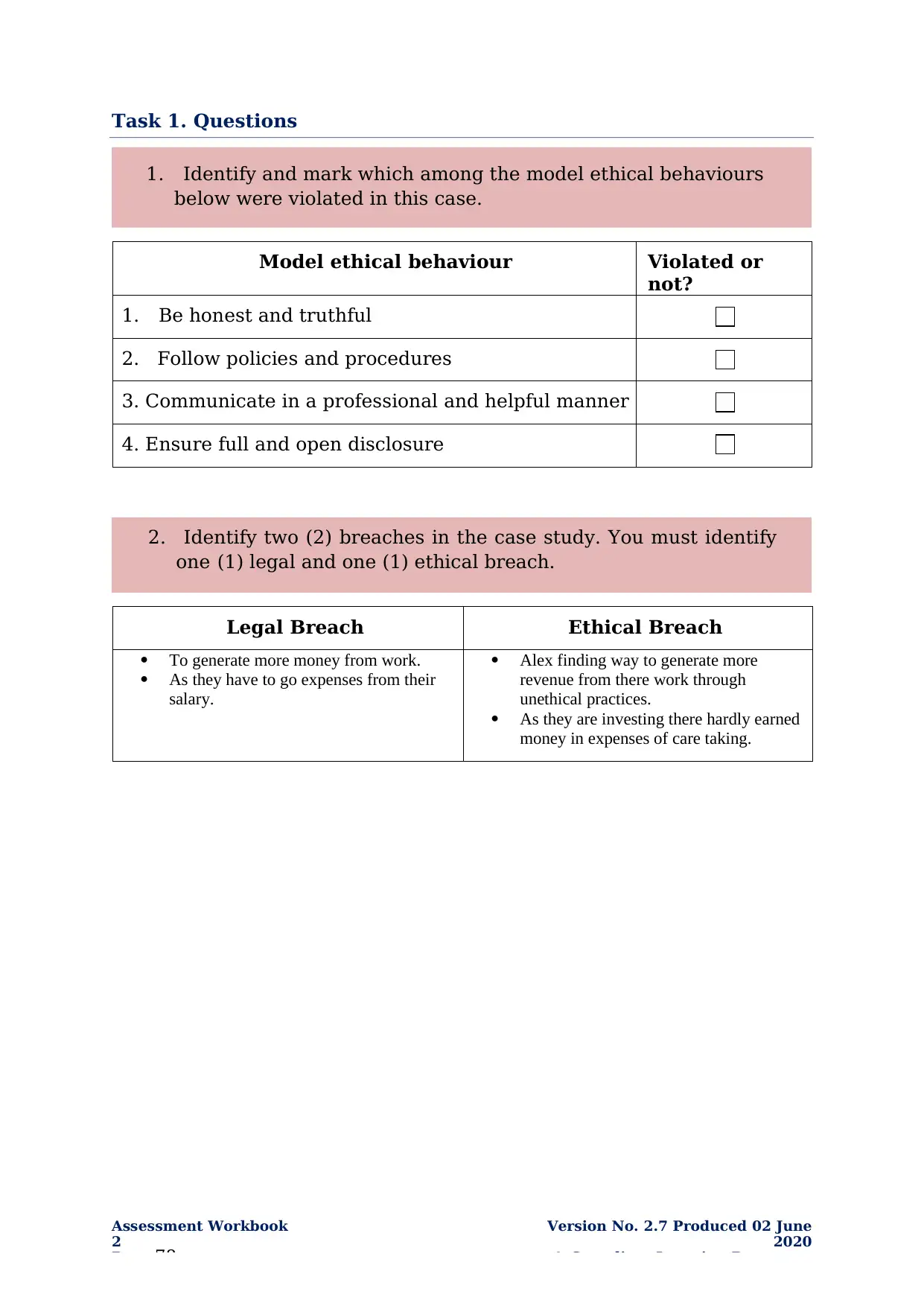
2
Page 78
Version No. 2.7 Produced 02 June
2020
© Compliant Learning Resources
Task 1. Questions
Model ethical behaviour Violated or
not?
1. Be honest and truthful
2. Follow policies and procedures
3. Communicate in a professional and helpful manner
4. Ensure full and open disclosure
Legal Breach Ethical Breach
To generate more money from work.
As they have to go expenses from their
salary.
Alex finding way to generate more
revenue from there work through
unethical practices.
As they are investing there hardly earned
money in expenses of care taking.
1. Identify and mark which among the model ethical behaviours
below were violated in this case.
2. Identify two (2) breaches in the case study. You must identify
one (1) legal and one (1) ethical breach.
Paraphrase This Document

2
Page 79
Version No. 2.7 Produced 02 June
2020
© Compliant Learning Resources
Task 2. Taking Action
From
To Adam Lauren
<adam.l@disabilitysupport.org.au>
Subject Overall scenario of Alex
Hello sir,
I am writing this mail to inform you that Alex is facing issue as they are sending there hardly earned
money in taking care which is not right. To overcome with this issues Alex and new support workers
are thinking that they will find some way to generate extra money from there work which is not right
in legal term. But while focusing on ethical matter it is right as they are not liable for investing hardly
earned money on taking care of things and people.
It is important to resolve issue in effective manner because it have negative impact on both care takers
as well as care taking house.
Thank you
As the worker who overheard the conversation between Alex and the
new support worker, write an email to your supervisor, Adam Lauren
(adam.l@disabilitysupport.org.au) and report about the scenario. In
your email, provide the following information:
Details of the situation.
Your assessment of the situation, specifically the ethical
responsibilities to the new support worker, the client and
broader community that Alex has breached.
Explain why there is a need for specialist legal advice.
The risks, consequences, and possible penalties for Alex’s
actions.
Guidance: There is no need to send an actual email. Write your email
in the spaces provided below. Ensure to maintain privacy and
confidentiality when writing your email.
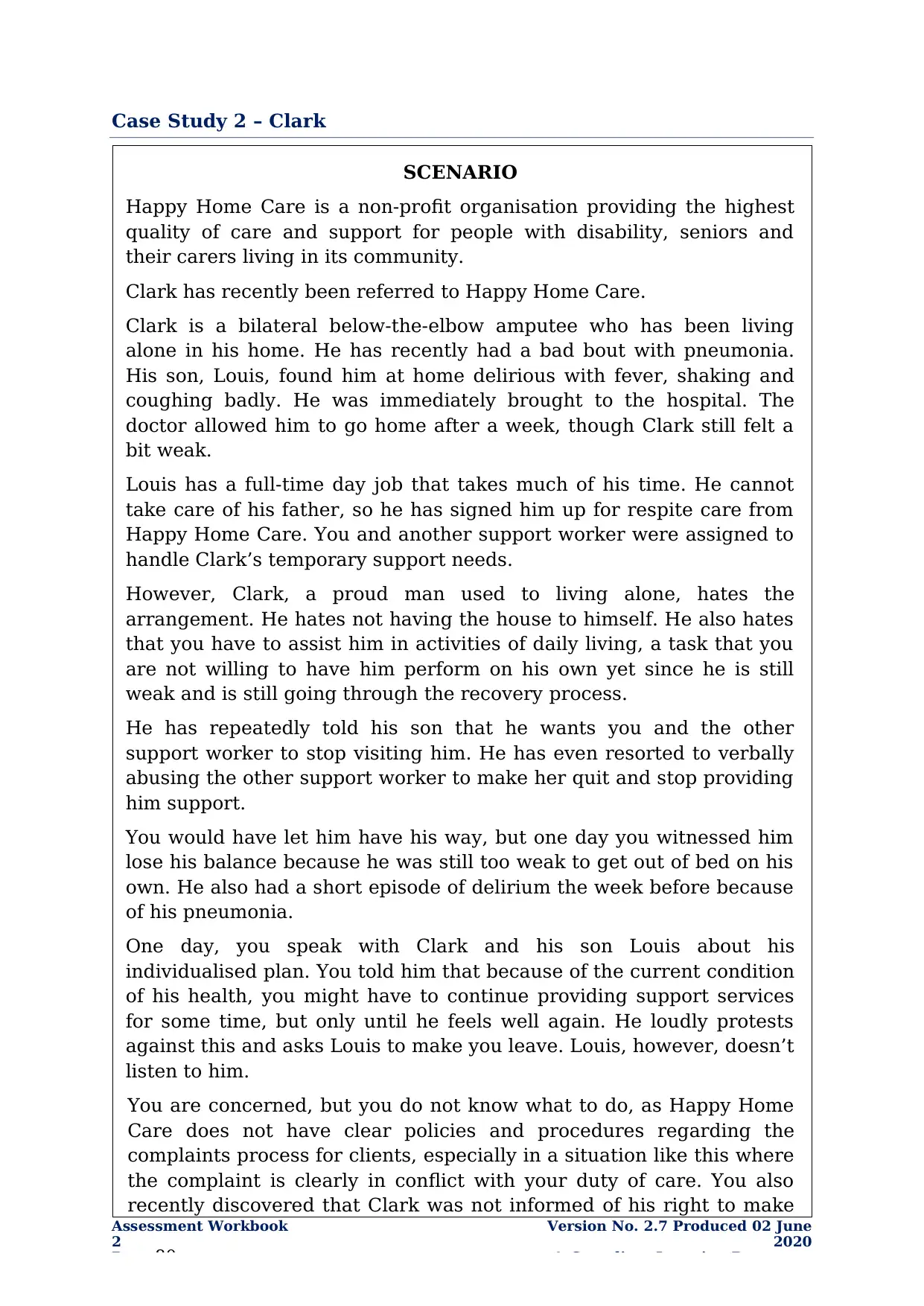
2
Page 80
Version No. 2.7 Produced 02 June
2020
© Compliant Learning Resources
Case Study 2 – Clark
SCENARIO
Happy Home Care is a non-profit organisation providing the highest
quality of care and support for people with disability, seniors and
their carers living in its community.
Clark has recently been referred to Happy Home Care.
Clark is a bilateral below-the-elbow amputee who has been living
alone in his home. He has recently had a bad bout with pneumonia.
His son, Louis, found him at home delirious with fever, shaking and
coughing badly. He was immediately brought to the hospital. The
doctor allowed him to go home after a week, though Clark still felt a
bit weak.
Louis has a full-time day job that takes much of his time. He cannot
take care of his father, so he has signed him up for respite care from
Happy Home Care. You and another support worker were assigned to
handle Clark’s temporary support needs.
However, Clark, a proud man used to living alone, hates the
arrangement. He hates not having the house to himself. He also hates
that you have to assist him in activities of daily living, a task that you
are not willing to have him perform on his own yet since he is still
weak and is still going through the recovery process.
He has repeatedly told his son that he wants you and the other
support worker to stop visiting him. He has even resorted to verbally
abusing the other support worker to make her quit and stop providing
him support.
You would have let him have his way, but one day you witnessed him
lose his balance because he was still too weak to get out of bed on his
own. He also had a short episode of delirium the week before because
of his pneumonia.
One day, you speak with Clark and his son Louis about his
individualised plan. You told him that because of the current condition
of his health, you might have to continue providing support services
for some time, but only until he feels well again. He loudly protests
against this and asks Louis to make you leave. Louis, however, doesn’t
listen to him.
You are concerned, but you do not know what to do, as Happy Home
Care does not have clear policies and procedures regarding the
complaints process for clients, especially in a situation like this where
the complaint is clearly in conflict with your duty of care. You also
recently discovered that Clark was not informed of his right to make
You're viewing a preview
Unlock full access by subscribing today!
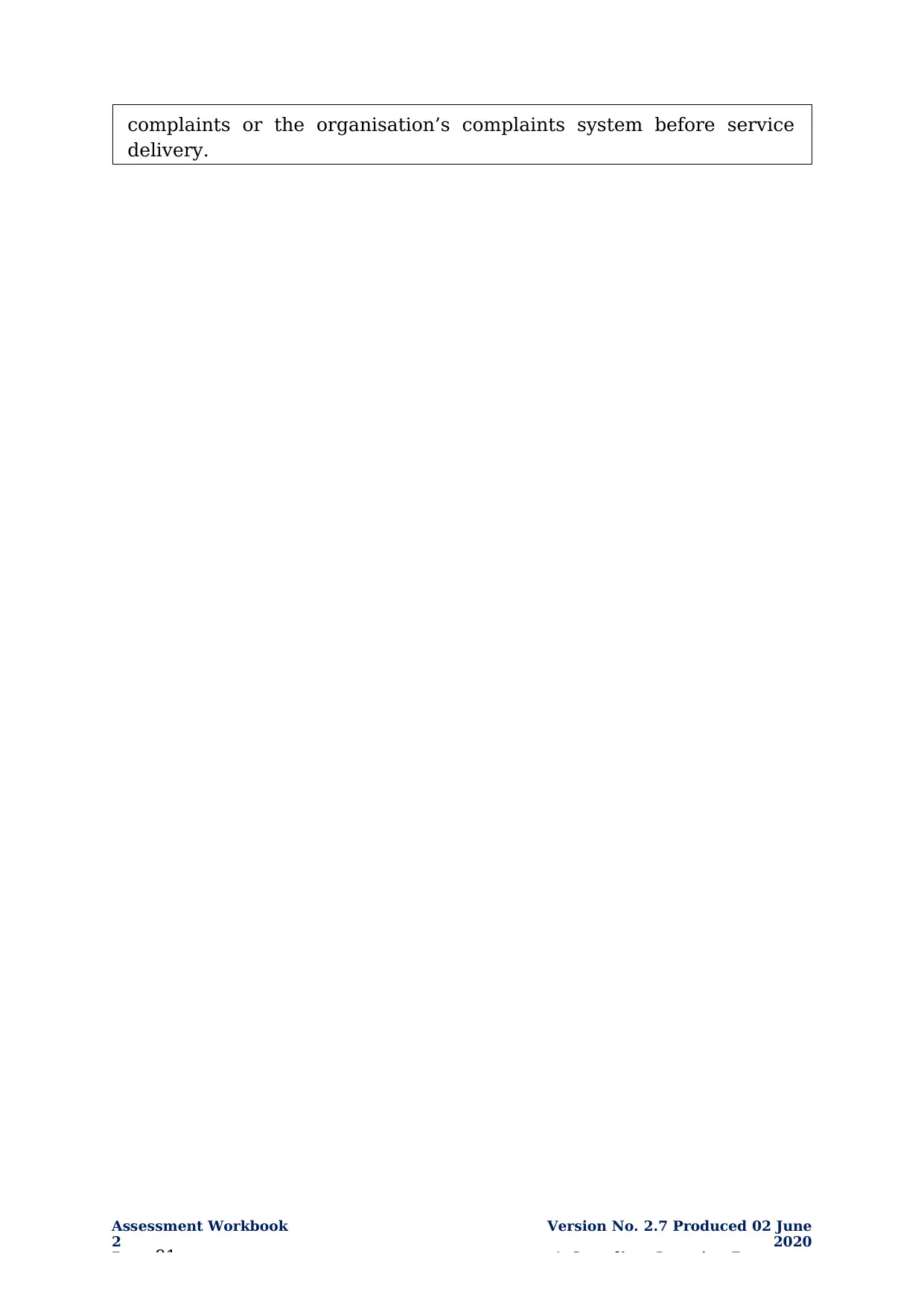
2
Page 81
Version No. 2.7 Produced 02 June
2020
© Compliant Learning Resources
complaints or the organisation’s complaints system before service
delivery.
Paraphrase This Document
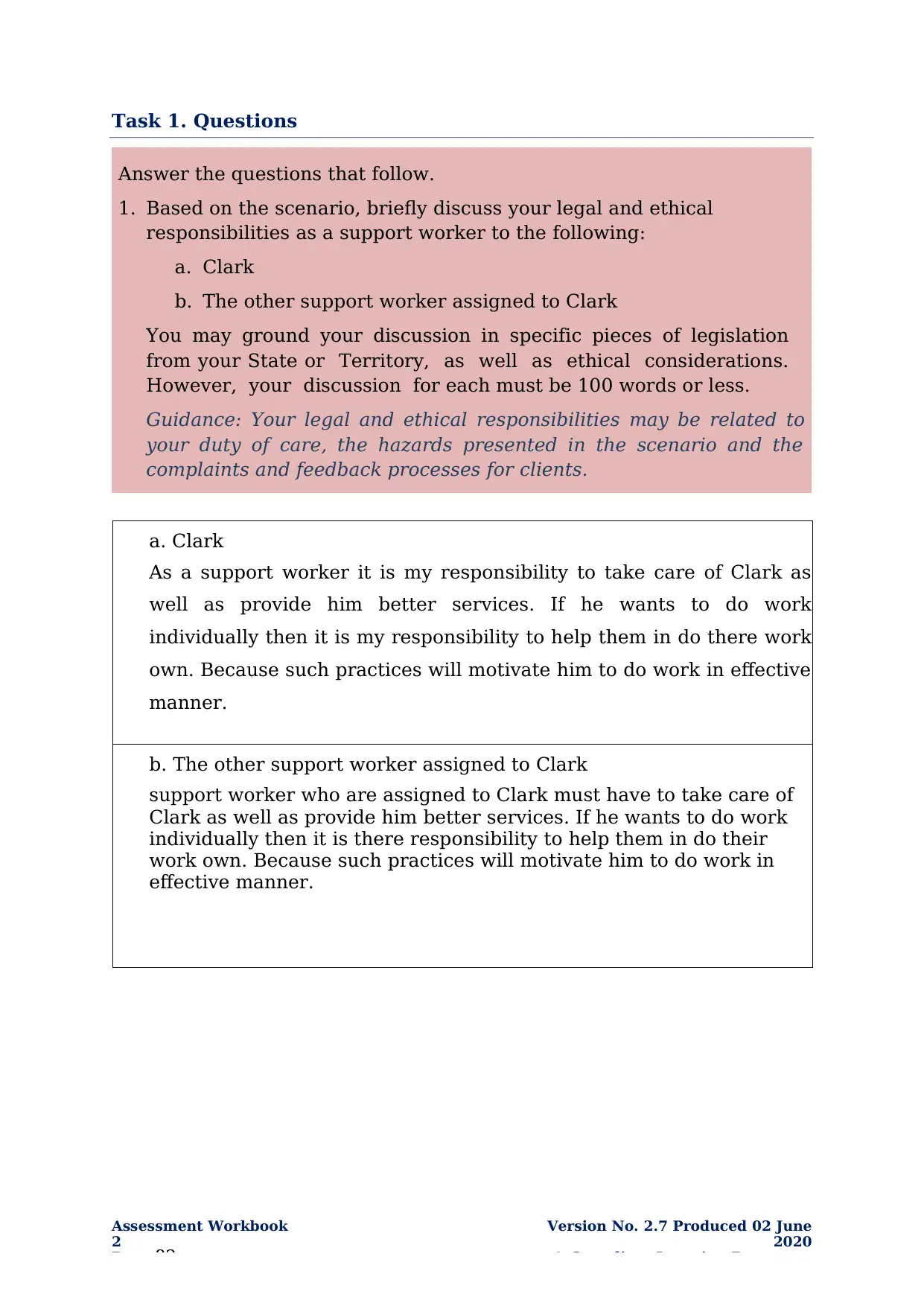
2
Page 82
Version No. 2.7 Produced 02 June
2020
© Compliant Learning Resources
Task 1. Questions
a. Clark
As a support worker it is my responsibility to take care of Clark as
well as provide him better services. If he wants to do work
individually then it is my responsibility to help them in do there work
own. Because such practices will motivate him to do work in effective
manner.
b. The other support worker assigned to Clark
support worker who are assigned to Clark must have to take care of
Clark as well as provide him better services. If he wants to do work
individually then it is there responsibility to help them in do their
work own. Because such practices will motivate him to do work in
effective manner.
Answer the questions that follow.
1. Based on the scenario, briefly discuss your legal and ethical
responsibilities as a support worker to the following:
a. Clark
b. The other support worker assigned to Clark
You may ground your discussion in specific pieces of legislation
from your State or Territory, as well as ethical considerations.
However, your discussion for each must be 100 words or less.
Guidance: Your legal and ethical responsibilities may be related to
your duty of care, the hazards presented in the scenario and the
complaints and feedback processes for clients.
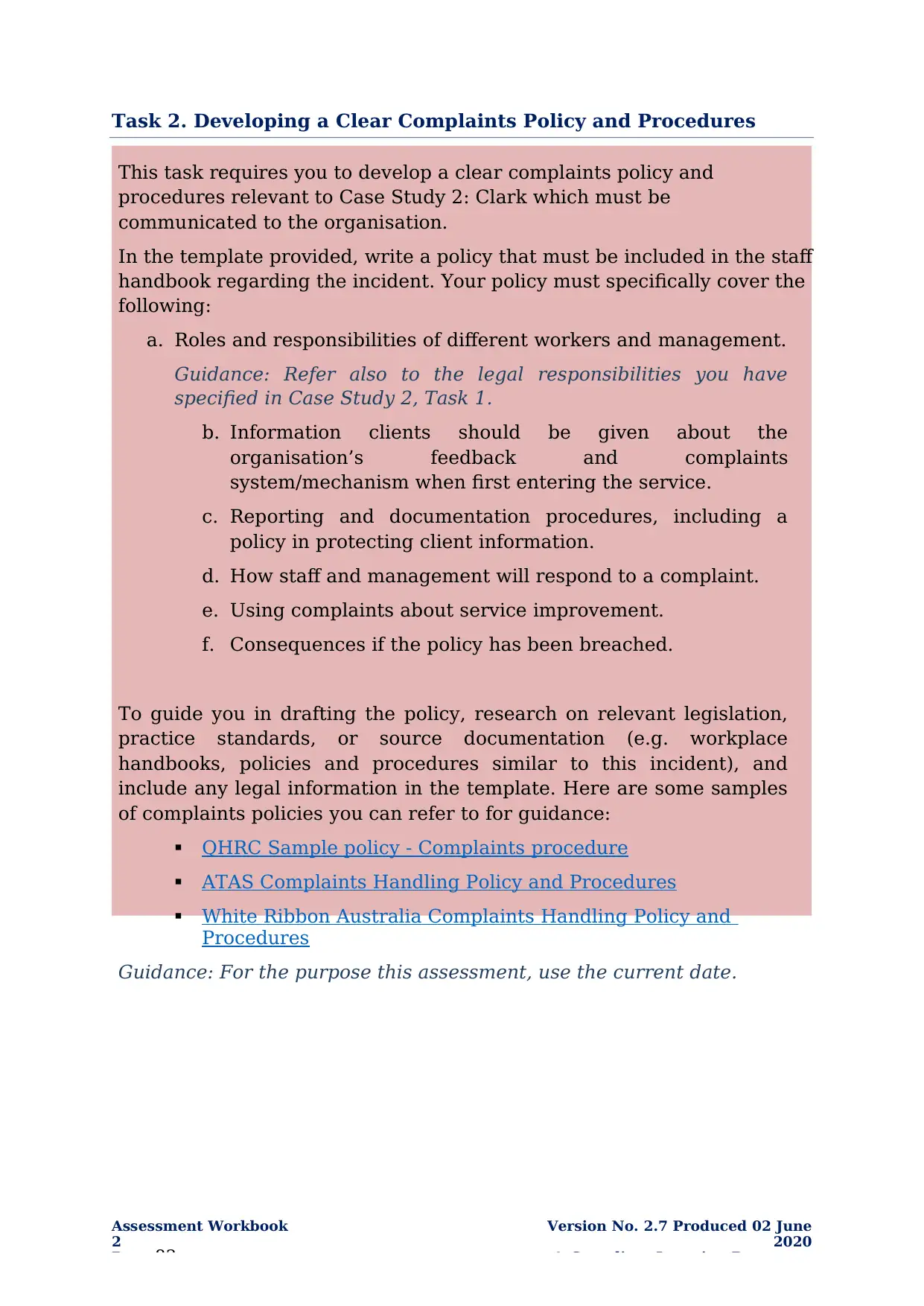
2
Page 83
Version No. 2.7 Produced 02 June
2020
© Compliant Learning Resources
Task 2. Developing a Clear Complaints Policy and Procedures
This task requires you to develop a clear complaints policy and
procedures relevant to Case Study 2: Clark which must be
communicated to the organisation.
In the template provided, write a policy that must be included in the staff
handbook regarding the incident. Your policy must specifically cover the
following:
a. Roles and responsibilities of different workers and management.
Guidance: Refer also to the legal responsibilities you have
specified in Case Study 2, Task 1.
b. Information clients should be given about the
organisation’s feedback and complaints
system/mechanism when first entering the service.
c. Reporting and documentation procedures, including a
policy in protecting client information.
d. How staff and management will respond to a complaint.
e. Using complaints about service improvement.
f. Consequences if the policy has been breached.
To guide you in drafting the policy, research on relevant legislation,
practice standards, or source documentation (e.g. workplace
handbooks, policies and procedures similar to this incident), and
include any legal information in the template. Here are some samples
of complaints policies you can refer to for guidance:
QHRC Sample policy - Complaints procedure
ATAS Complaints Handling Policy and Procedures
White Ribbon Australia Complaints Handling Policy and
Procedures
Guidance: For the purpose this assessment, use the current date.
You're viewing a preview
Unlock full access by subscribing today!
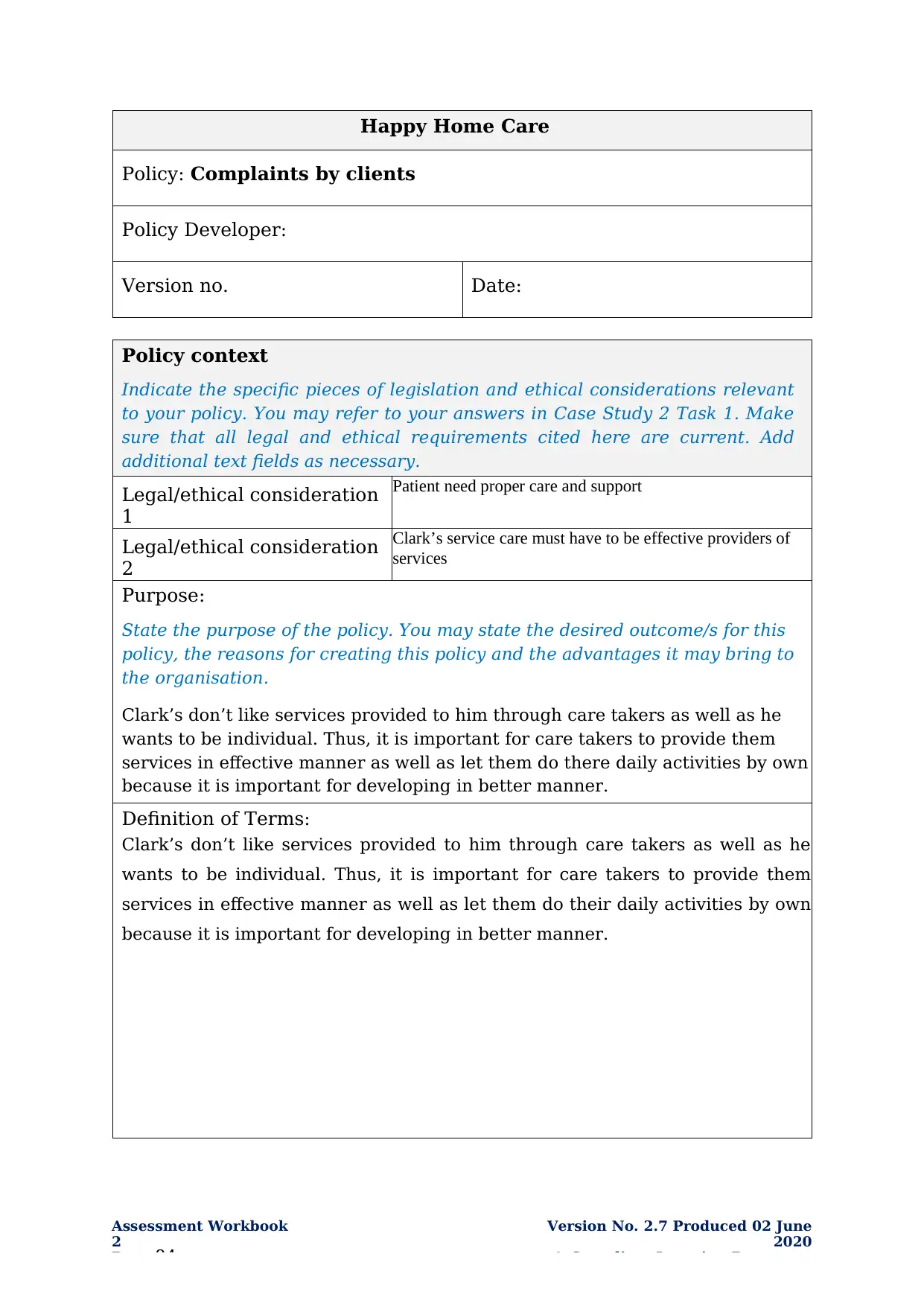
2
Page 84
Version No. 2.7 Produced 02 June
2020
© Compliant Learning Resources
Happy Home Care
Policy: Complaints by clients
Policy Developer:
Version no. Date:
Policy context
Indicate the specific pieces of legislation and ethical considerations relevant
to your policy. You may refer to your answers in Case Study 2 Task 1. Make
sure that all legal and ethical requirements cited here are current. Add
additional text fields as necessary.
Legal/ethical consideration
1
Patient need proper care and support
Legal/ethical consideration
2
Clark’s service care must have to be effective providers of
services
Purpose:
State the purpose of the policy. You may state the desired outcome/s for this
policy, the reasons for creating this policy and the advantages it may bring to
the organisation.
Clark’s don’t like services provided to him through care takers as well as he
wants to be individual. Thus, it is important for care takers to provide them
services in effective manner as well as let them do there daily activities by own
because it is important for developing in better manner.
Definition of Terms:
Clark’s don’t like services provided to him through care takers as well as he
wants to be individual. Thus, it is important for care takers to provide them
services in effective manner as well as let them do their daily activities by own
because it is important for developing in better manner.
Paraphrase This Document
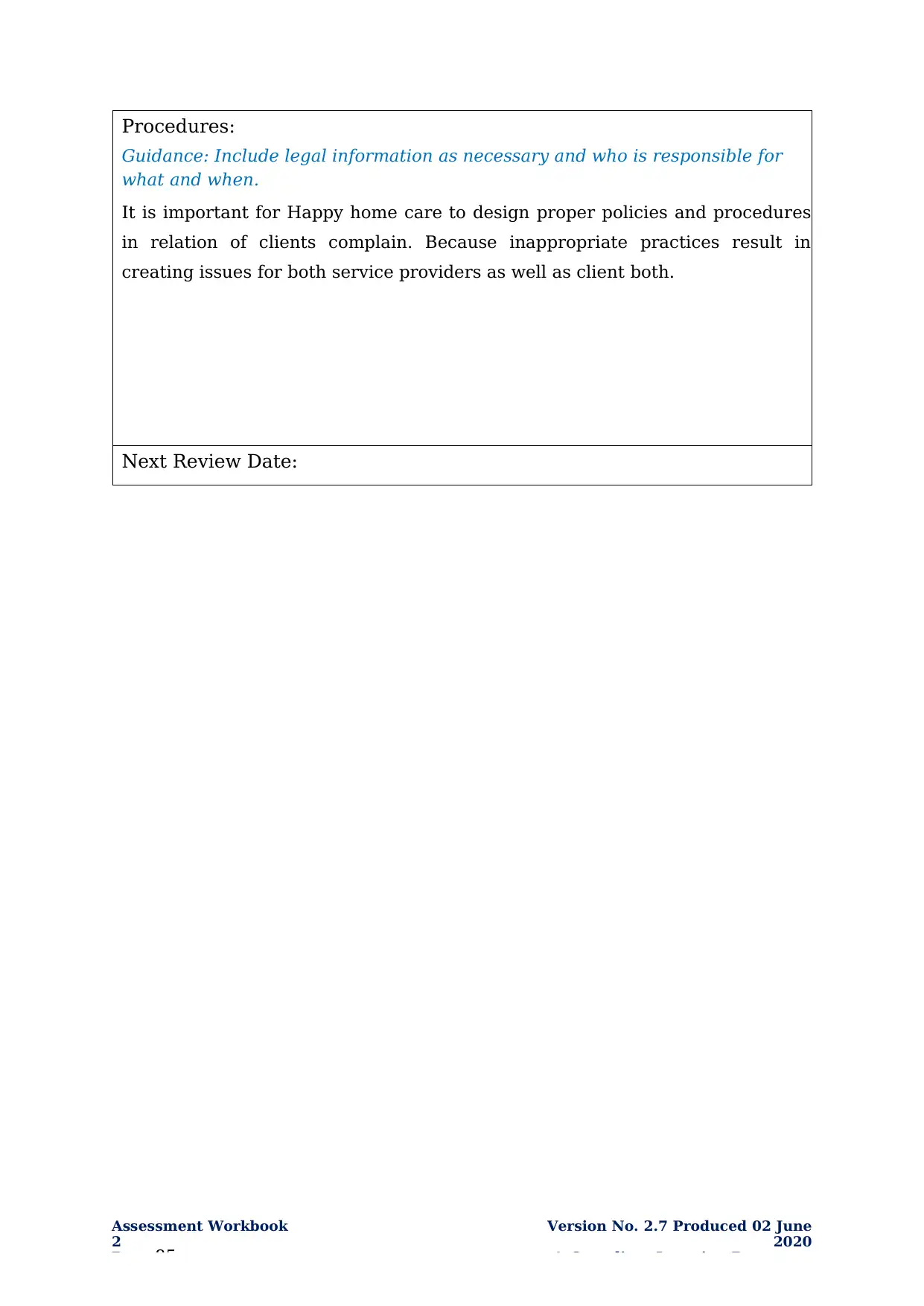
2
Page 85
Version No. 2.7 Produced 02 June
2020
© Compliant Learning Resources
Procedures:
Guidance: Include legal information as necessary and who is responsible for
what and when.
It is important for Happy home care to design proper policies and procedures
in relation of clients complain. Because inappropriate practices result in
creating issues for both service providers as well as client both.
Next Review Date:
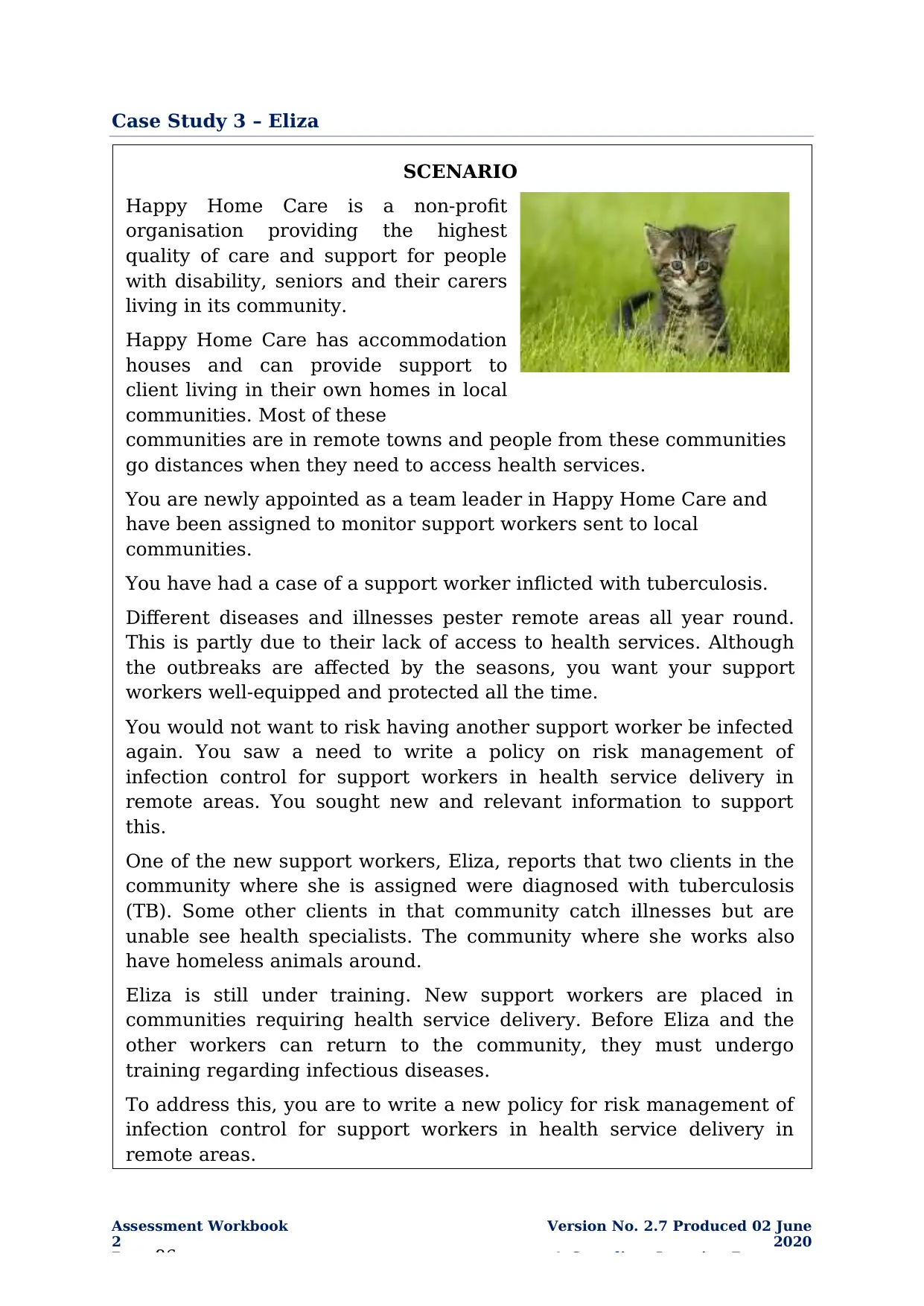
2
Page 86
Version No. 2.7 Produced 02 June
2020
© Compliant Learning Resources
Case Study 3 – Eliza
SCENARIO
Happy Home Care is a non-profit
organisation providing the highest
quality of care and support for people
with disability, seniors and their carers
living in its community.
Happy Home Care has accommodation
houses and can provide support to
client living in their own homes in local
communities. Most of these
communities are in remote towns and people from these communities
go distances when they need to access health services.
You are newly appointed as a team leader in Happy Home Care and
have been assigned to monitor support workers sent to local
communities.
You have had a case of a support worker inflicted with tuberculosis.
Different diseases and illnesses pester remote areas all year round.
This is partly due to their lack of access to health services. Although
the outbreaks are affected by the seasons, you want your support
workers well-equipped and protected all the time.
You would not want to risk having another support worker be infected
again. You saw a need to write a policy on risk management of
infection control for support workers in health service delivery in
remote areas. You sought new and relevant information to support
this.
One of the new support workers, Eliza, reports that two clients in the
community where she is assigned were diagnosed with tuberculosis
(TB). Some other clients in that community catch illnesses but are
unable see health specialists. The community where she works also
have homeless animals around.
Eliza is still under training. New support workers are placed in
communities requiring health service delivery. Before Eliza and the
other workers can return to the community, they must undergo
training regarding infectious diseases.
To address this, you are to write a new policy for risk management of
infection control for support workers in health service delivery in
remote areas.
You're viewing a preview
Unlock full access by subscribing today!
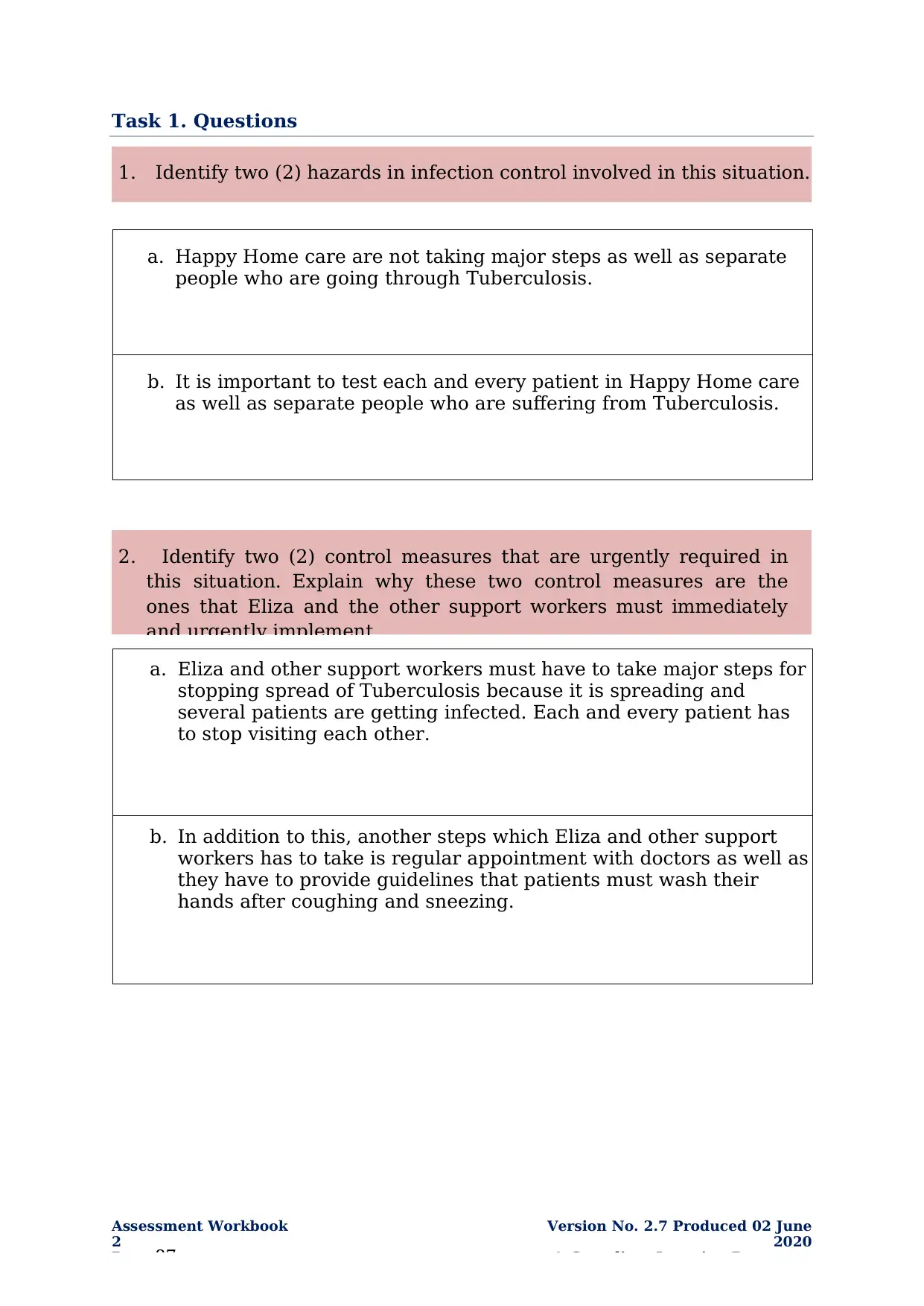
2
Page 87
Version No. 2.7 Produced 02 June
2020
© Compliant Learning Resources
Task 1. Questions
a. Happy Home care are not taking major steps as well as separate
people who are going through Tuberculosis.
b. It is important to test each and every patient in Happy Home care
as well as separate people who are suffering from Tuberculosis.
a. Eliza and other support workers must have to take major steps for
stopping spread of Tuberculosis because it is spreading and
several patients are getting infected. Each and every patient has
to stop visiting each other.
b. In addition to this, another steps which Eliza and other support
workers has to take is regular appointment with doctors as well as
they have to provide guidelines that patients must wash their
hands after coughing and sneezing.
1. Identify two (2) hazards in infection control involved in this situation.
2. Identify two (2) control measures that are urgently required in
this situation. Explain why these two control measures are the
ones that Eliza and the other support workers must immediately
and urgently implement.
Paraphrase This Document
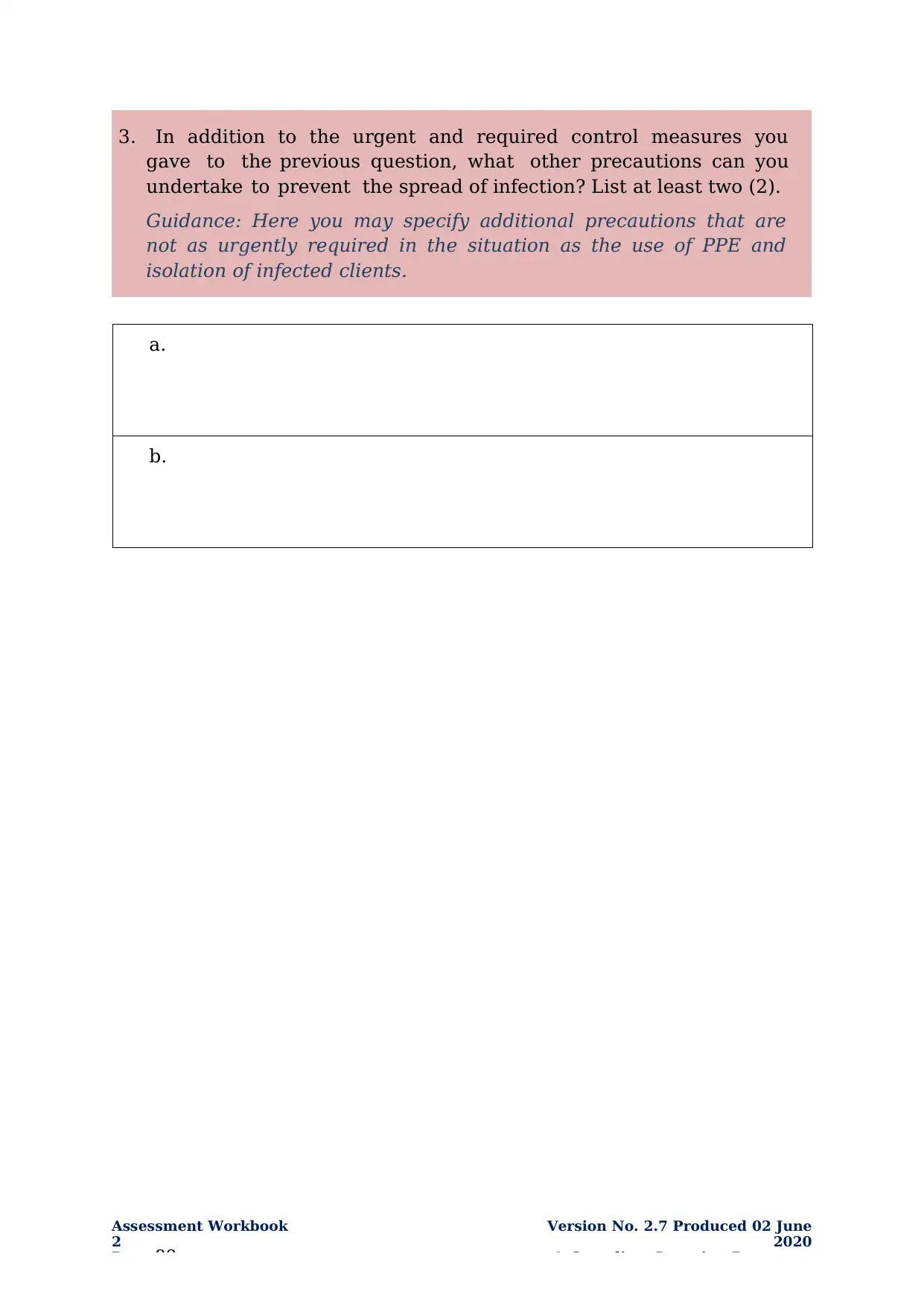
2
Page 88
Version No. 2.7 Produced 02 June
2020
© Compliant Learning Resources
a.
b.
3. In addition to the urgent and required control measures you
gave to the previous question, what other precautions can you
undertake to prevent the spread of infection? List at least two (2).
Guidance: Here you may specify additional precautions that are
not as urgently required in the situation as the use of PPE and
isolation of infected clients.
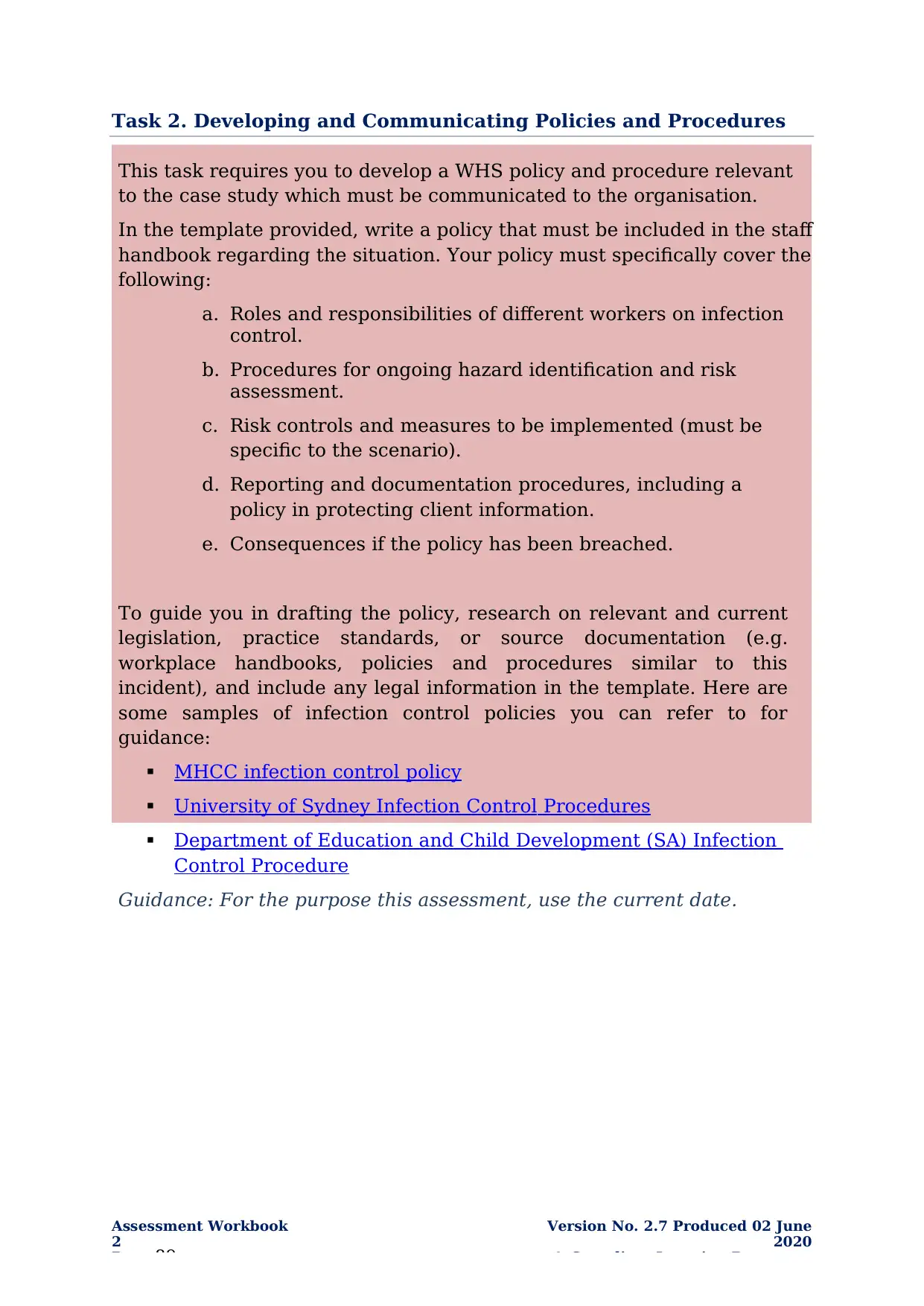
2
Page 89
Version No. 2.7 Produced 02 June
2020
© Compliant Learning Resources
Task 2. Developing and Communicating Policies and Procedures
This task requires you to develop a WHS policy and procedure relevant
to the case study which must be communicated to the organisation.
In the template provided, write a policy that must be included in the staff
handbook regarding the situation. Your policy must specifically cover the
following:
a. Roles and responsibilities of different workers on infection
control.
b. Procedures for ongoing hazard identification and risk
assessment.
c. Risk controls and measures to be implemented (must be
specific to the scenario).
d. Reporting and documentation procedures, including a
policy in protecting client information.
e. Consequences if the policy has been breached.
To guide you in drafting the policy, research on relevant and current
legislation, practice standards, or source documentation (e.g.
workplace handbooks, policies and procedures similar to this
incident), and include any legal information in the template. Here are
some samples of infection control policies you can refer to for
guidance:
MHCC infection control policy
University of Sydney Infection Control Procedures
Department of Education and Child Development (SA) Infection
Control Procedure
Guidance: For the purpose this assessment, use the current date.
You're viewing a preview
Unlock full access by subscribing today!
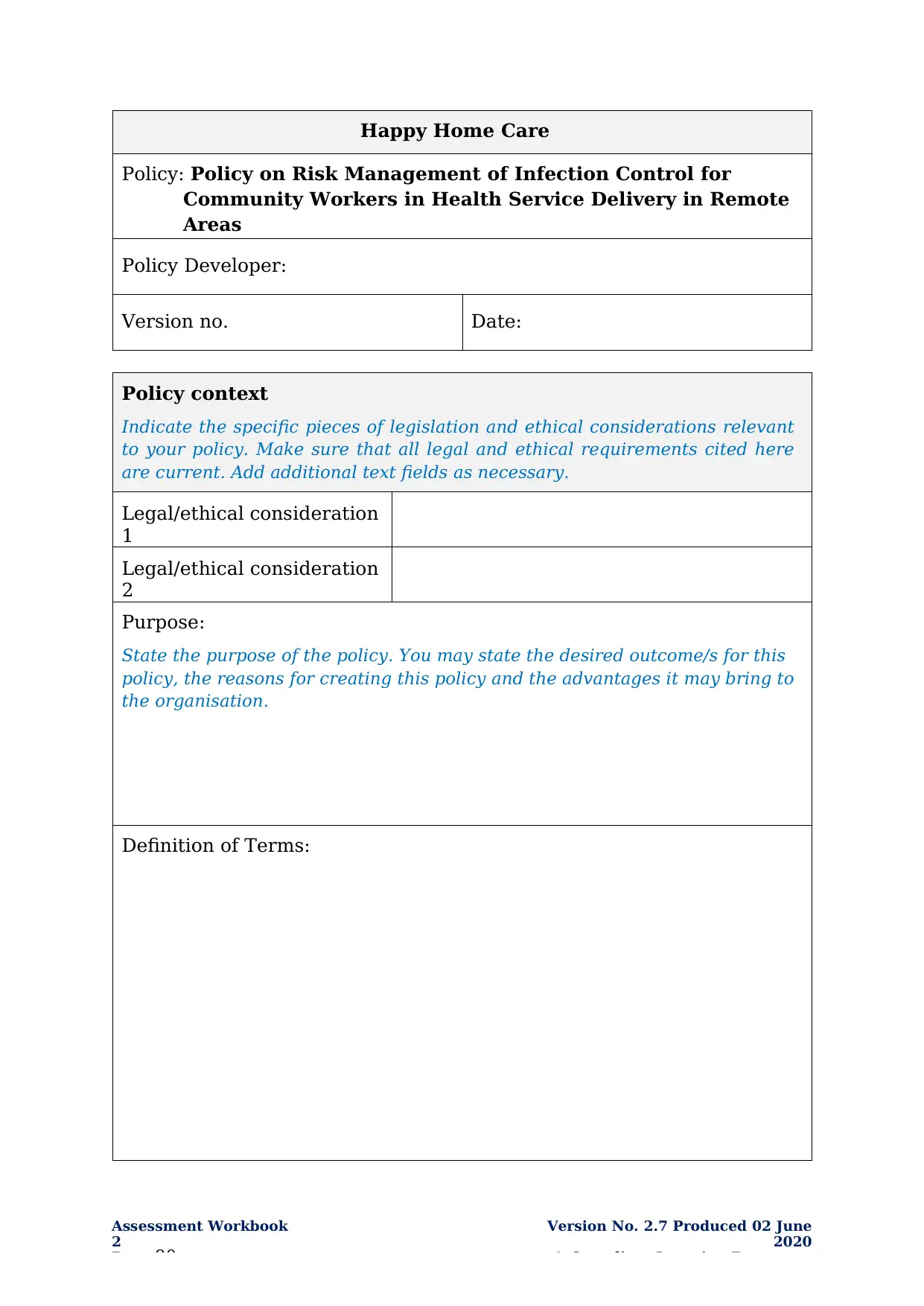
2
Page 90
Version No. 2.7 Produced 02 June
2020
© Compliant Learning Resources
Happy Home Care
Policy: Policy on Risk Management of Infection Control for
Community Workers in Health Service Delivery in Remote
Areas
Policy Developer:
Version no. Date:
Policy context
Indicate the specific pieces of legislation and ethical considerations relevant
to your policy. Make sure that all legal and ethical requirements cited here
are current. Add additional text fields as necessary.
Legal/ethical consideration
1
Legal/ethical consideration
2
Purpose:
State the purpose of the policy. You may state the desired outcome/s for this
policy, the reasons for creating this policy and the advantages it may bring to
the organisation.
Definition of Terms:
Paraphrase This Document
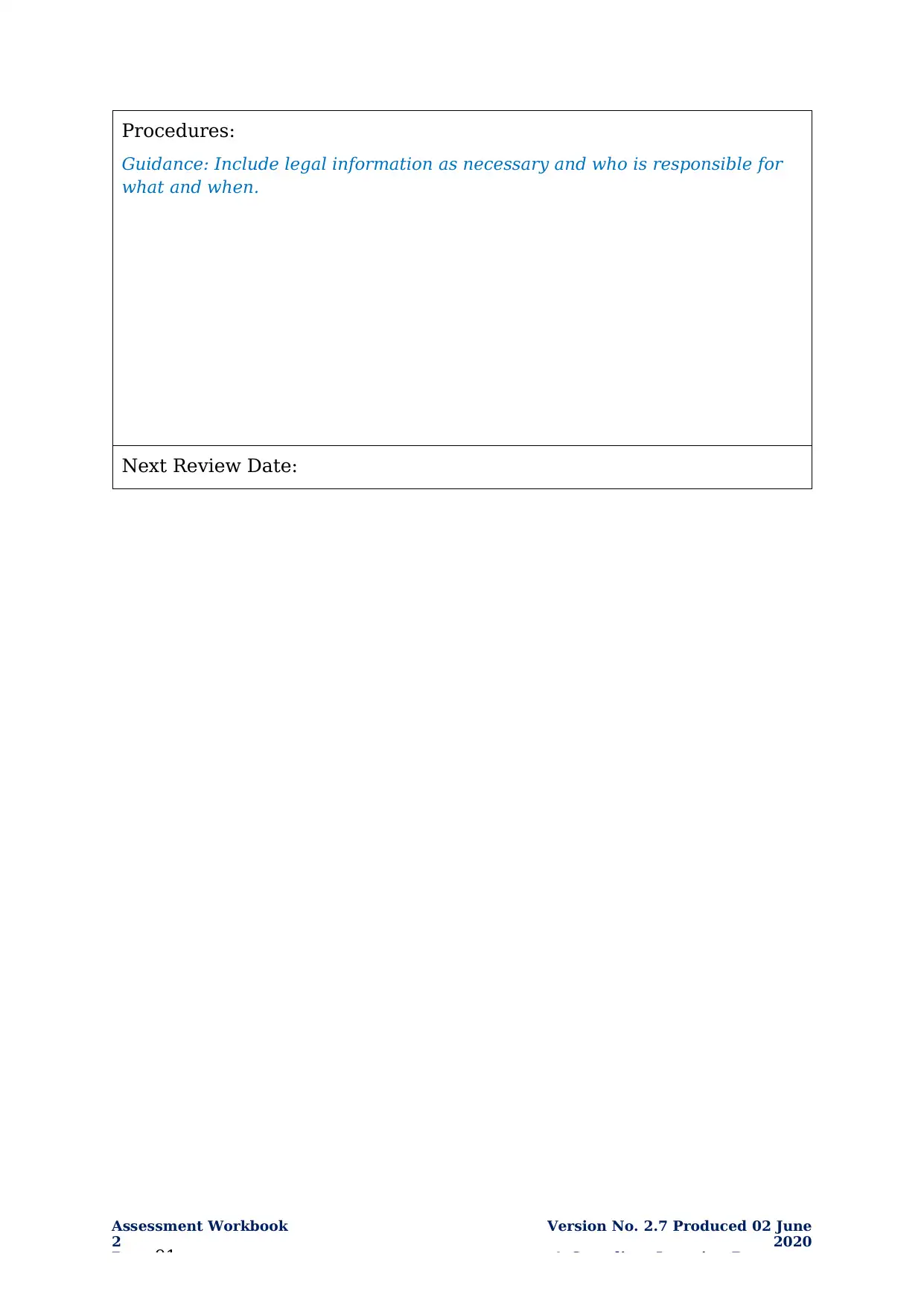
2
Page 91
Version No. 2.7 Produced 02 June
2020
© Compliant Learning Resources
Procedures:
Guidance: Include legal information as necessary and who is responsible for
what and when.
Next Review Date:
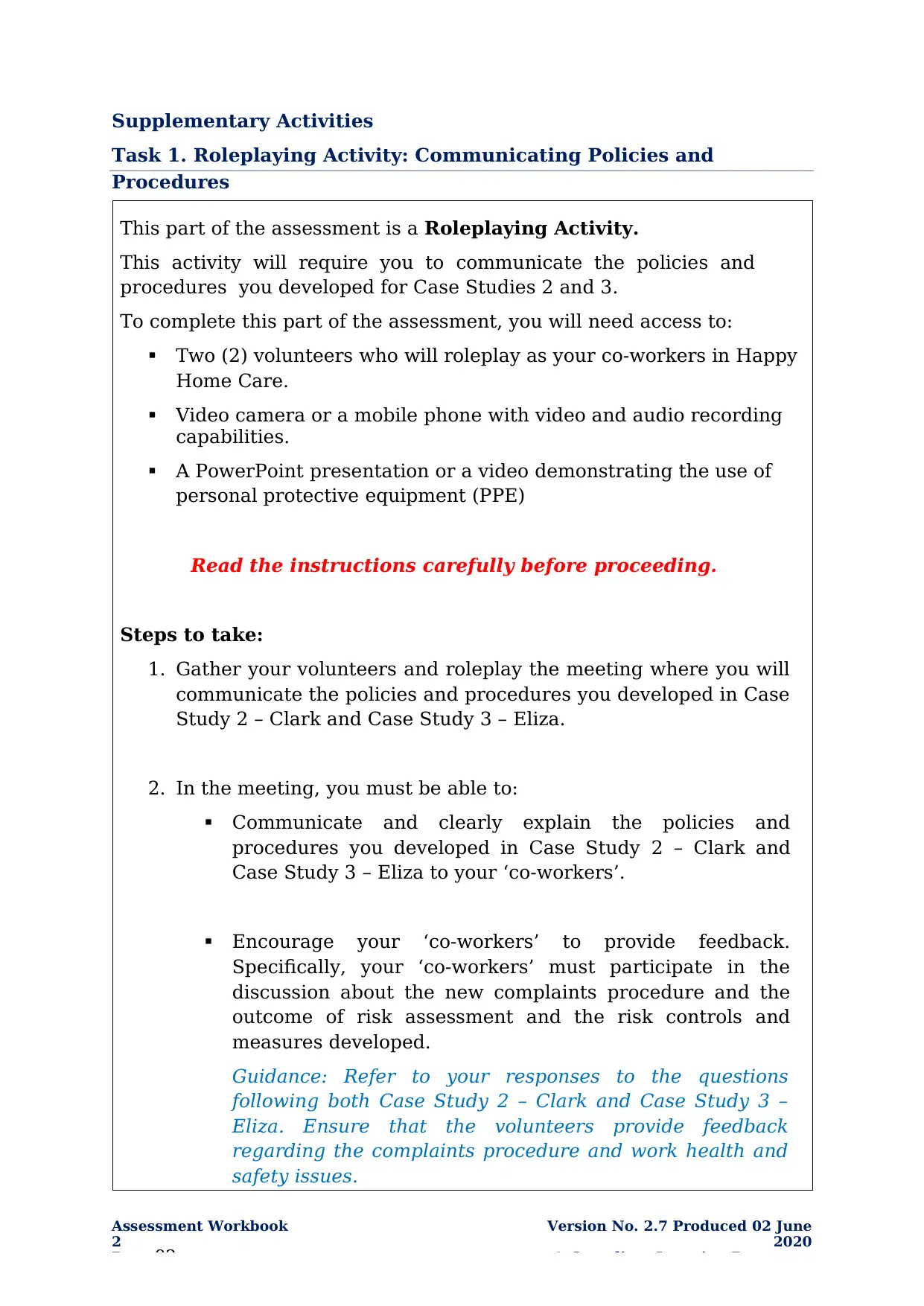
2
Page 92
Version No. 2.7 Produced 02 June
2020
© Compliant Learning Resources
Supplementary Activities
Task 1. Roleplaying Activity: Communicating Policies and
Procedures
This part of the assessment is a Roleplaying Activity.
This activity will require you to communicate the policies and
procedures you developed for Case Studies 2 and 3.
To complete this part of the assessment, you will need access to:
Two (2) volunteers who will roleplay as your co-workers in Happy
Home Care.
Video camera or a mobile phone with video and audio recording
capabilities.
A PowerPoint presentation or a video demonstrating the use of
personal protective equipment (PPE)
Read the instructions carefully before proceeding.
Steps to take:
1. Gather your volunteers and roleplay the meeting where you will
communicate the policies and procedures you developed in Case
Study 2 – Clark and Case Study 3 – Eliza.
2. In the meeting, you must be able to:
Communicate and clearly explain the policies and
procedures you developed in Case Study 2 – Clark and
Case Study 3 – Eliza to your ‘co-workers’.
Encourage your ‘co-workers’ to provide feedback.
Specifically, your ‘co-workers’ must participate in the
discussion about the new complaints procedure and the
outcome of risk assessment and the risk controls and
measures developed.
Guidance: Refer to your responses to the questions
following both Case Study 2 – Clark and Case Study 3 –
Eliza. Ensure that the volunteers provide feedback
regarding the complaints procedure and work health and
safety issues.
You're viewing a preview
Unlock full access by subscribing today!

2
Page 93
Version No. 2.7 Produced 02 June
2020
© Compliant Learning Resources
Nominate the roles and responsibilities to workers as
written in the policies you developed (e.g. what are their
roles and responsibilities in the policies and procedures?).
Demonstrate the use of personal protective equipment
(PPE) as part of the policies and procedures developed
through a PowerPoint presentation or a video. The
presentation may be created before starting the roleplay;
the video may be sourced online beforehand.
Share updated knowledge and legal information in
relation to the policies developed.
Guidelines
1. To demonstrate your completion of this activity, the meeting must
be recorded. Save the recorded video using the filename:
[Last Name, First Name]_CHC43115 Subject 2 – Case
Study 3 - Roleplay Activity
For example, as seen below:
Smith, John_CHC43115 Subject 2 –
Case Study 3 - Roleplay Activity.avi
2. Your video submission must not be longer than fifteen (15) minutes
in length. Any submission longer than fifteen (15) minutes will be
considered not satisfactory.
3. There is no specific script to be followed in the roleplaying activity.
However, you must be able to demonstrate all steps outlined
above. Moreover, your submission will be assessed against the
checklist provided below.
Paraphrase This Document
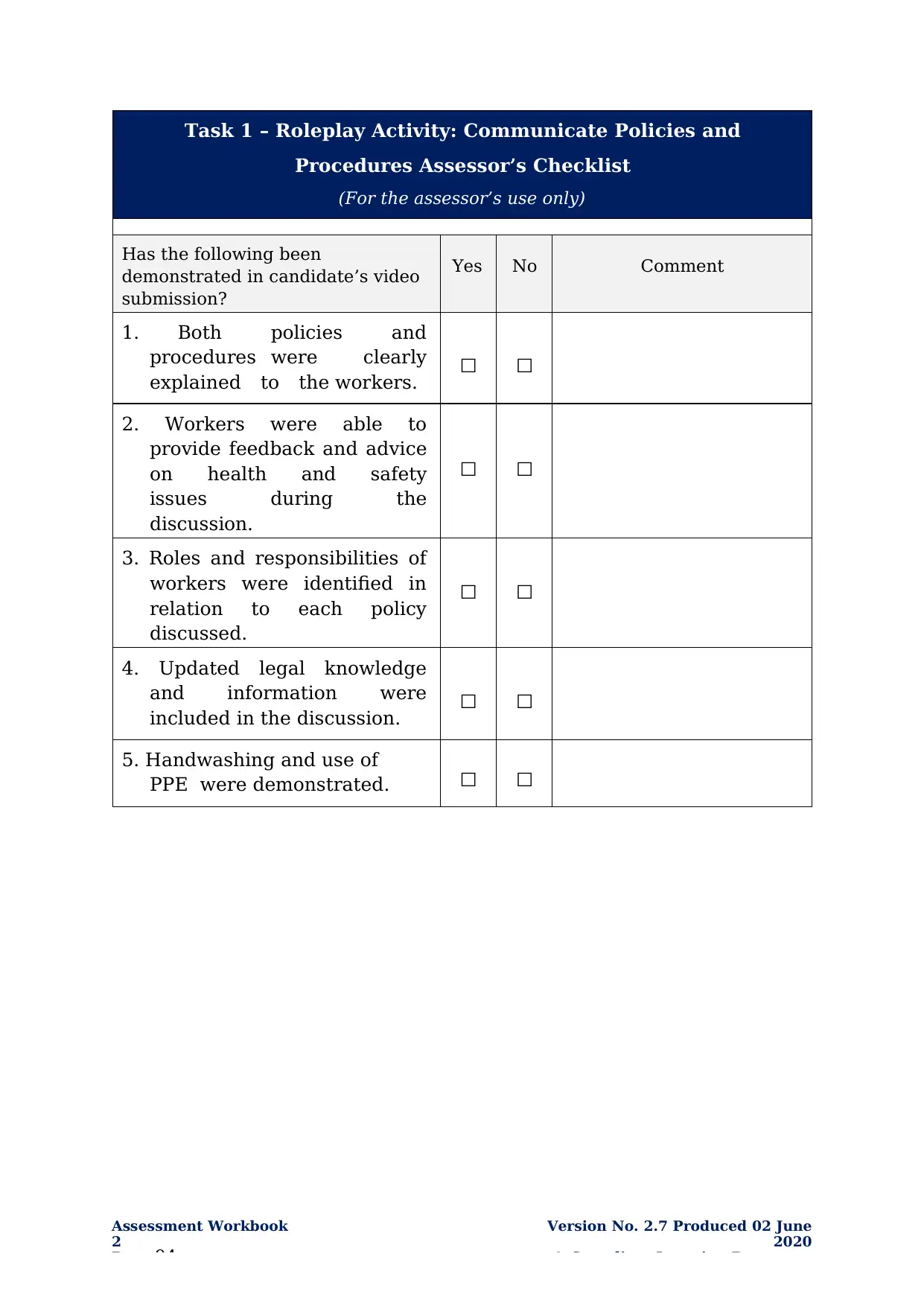
2
Page 94
Version No. 2.7 Produced 02 June
2020
© Compliant Learning Resources
Task 1 – Roleplay Activity: Communicate Policies and
Procedures Assessor’s Checklist
(For the assessor’s use only)
Has the following been
demonstrated in candidate’s video
submission?
Yes No Comment
1. Both policies and
procedures were clearly
explained to the workers. ☐ ☐
2. Workers were able to
provide feedback and advice
on health and safety
issues during the
discussion.
☐ ☐
3. Roles and responsibilities of
workers were identified in
relation to each policy
discussed.
☐ ☐
4. Updated legal knowledge
and information were
included in the discussion. ☐ ☐
5. Handwashing and use of
PPE were demonstrated. ☐ ☐
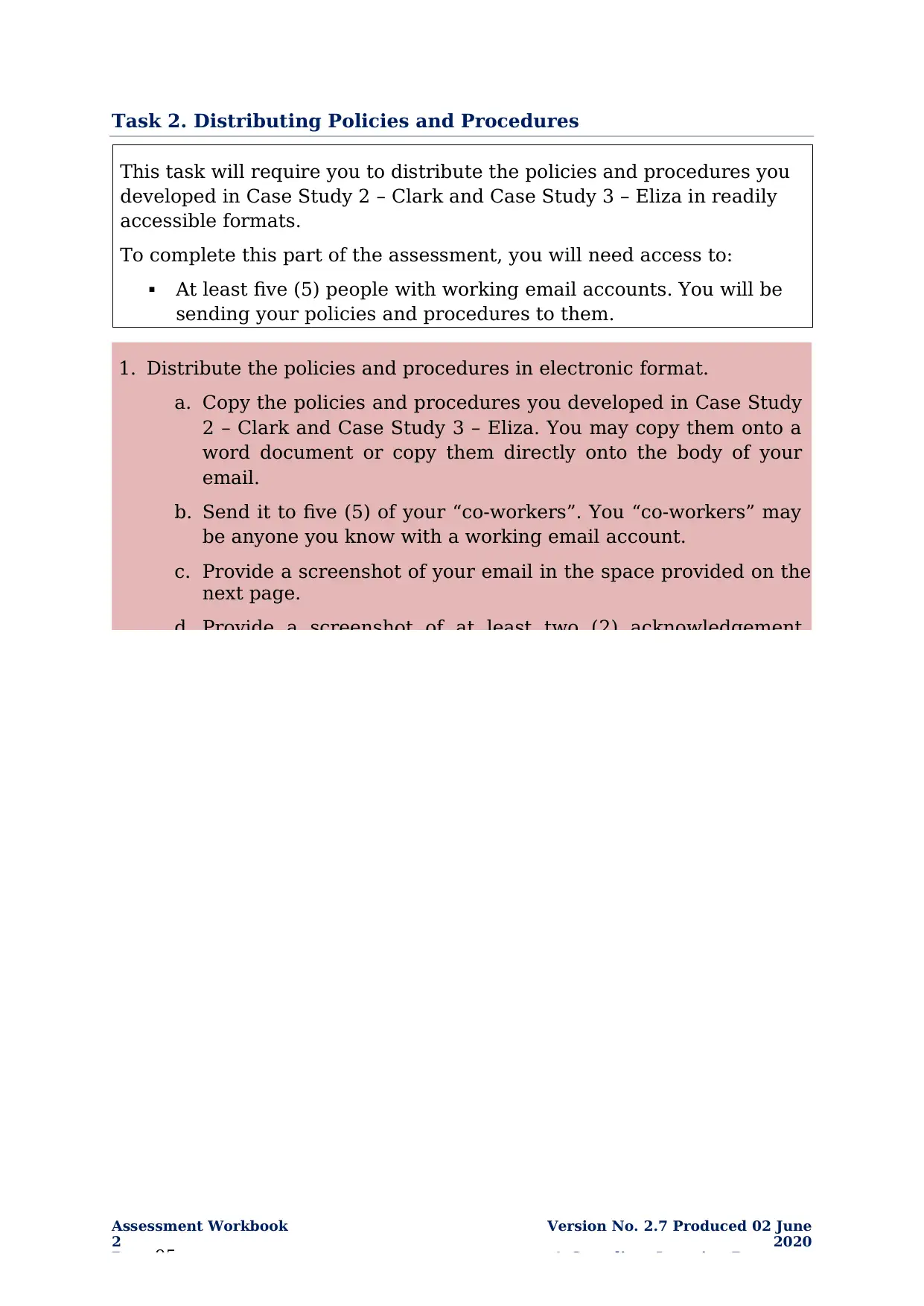
2
Page 95
Version No. 2.7 Produced 02 June
2020
© Compliant Learning Resources
Task 2. Distributing Policies and Procedures
This task will require you to distribute the policies and procedures you
developed in Case Study 2 – Clark and Case Study 3 – Eliza in readily
accessible formats.
To complete this part of the assessment, you will need access to:
At least five (5) people with working email accounts. You will be
sending your policies and procedures to them.
1. Distribute the policies and procedures in electronic format.
a. Copy the policies and procedures you developed in Case Study
2 – Clark and Case Study 3 – Eliza. You may copy them onto a
word document or copy them directly onto the body of your
email.
b. Send it to five (5) of your “co-workers”. You “co-workers” may
be anyone you know with a working email account.
c. Provide a screenshot of your email in the space provided on the
next page.
d. Provide a screenshot of at least two (2) acknowledgement
You're viewing a preview
Unlock full access by subscribing today!
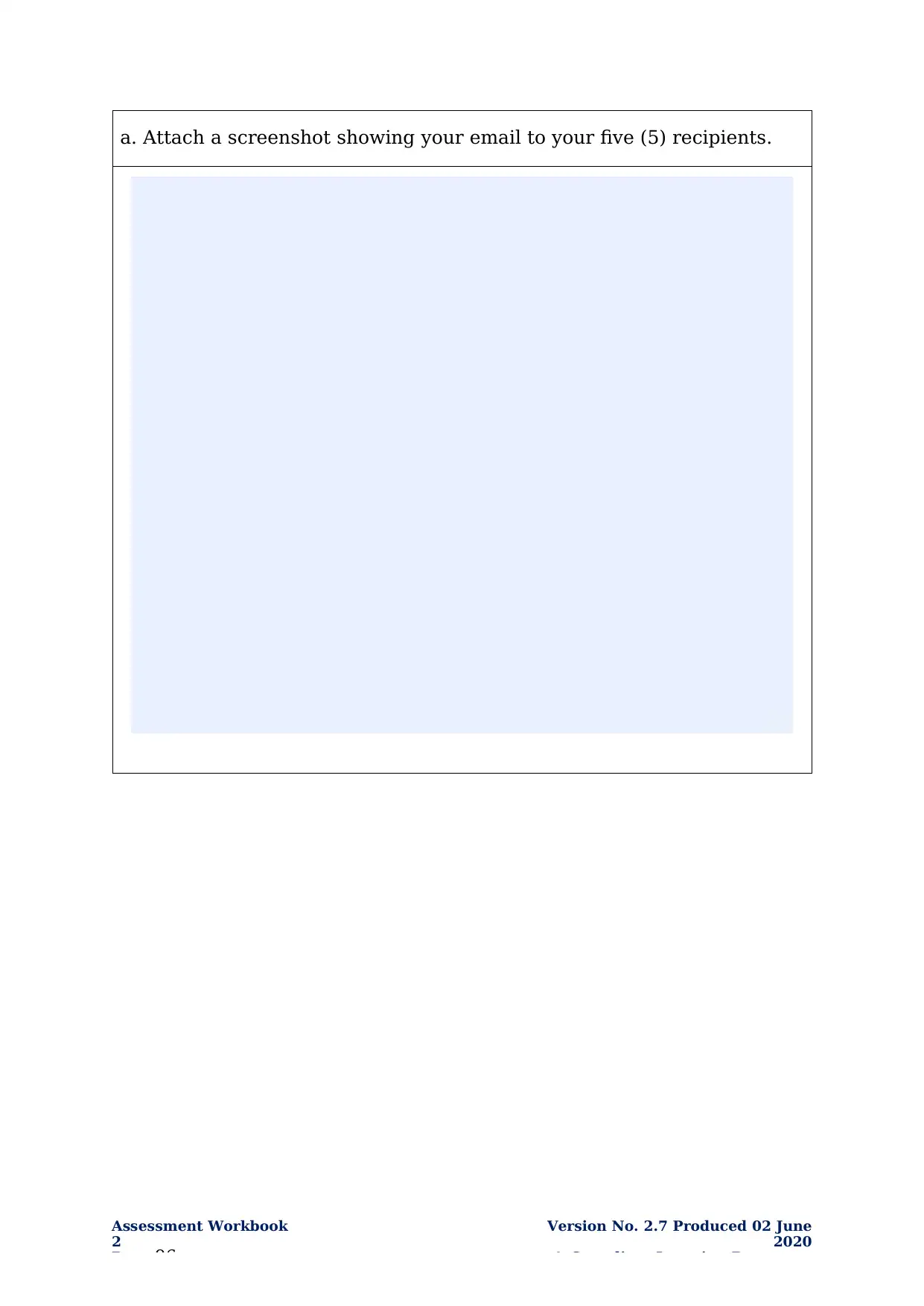
2
Page 96
Version No. 2.7 Produced 02 June
2020
© Compliant Learning Resources
a. Attach a screenshot showing your email to your five (5) recipients.
Paraphrase This Document
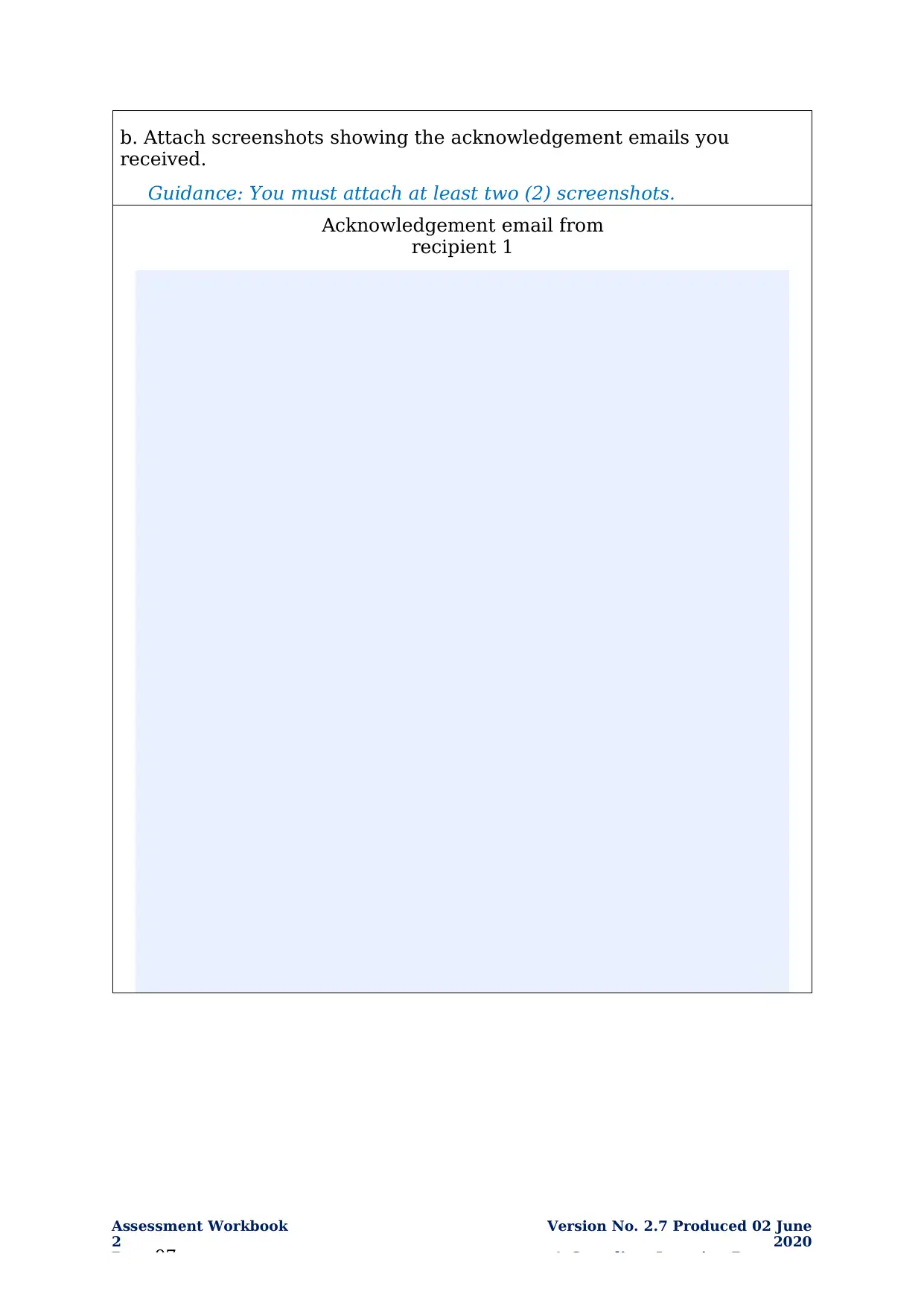
2
Page 97
Version No. 2.7 Produced 02 June
2020
© Compliant Learning Resources
b. Attach screenshots showing the acknowledgement emails you
received.
Guidance: You must attach at least two (2) screenshots.
Acknowledgement email from
recipient 1
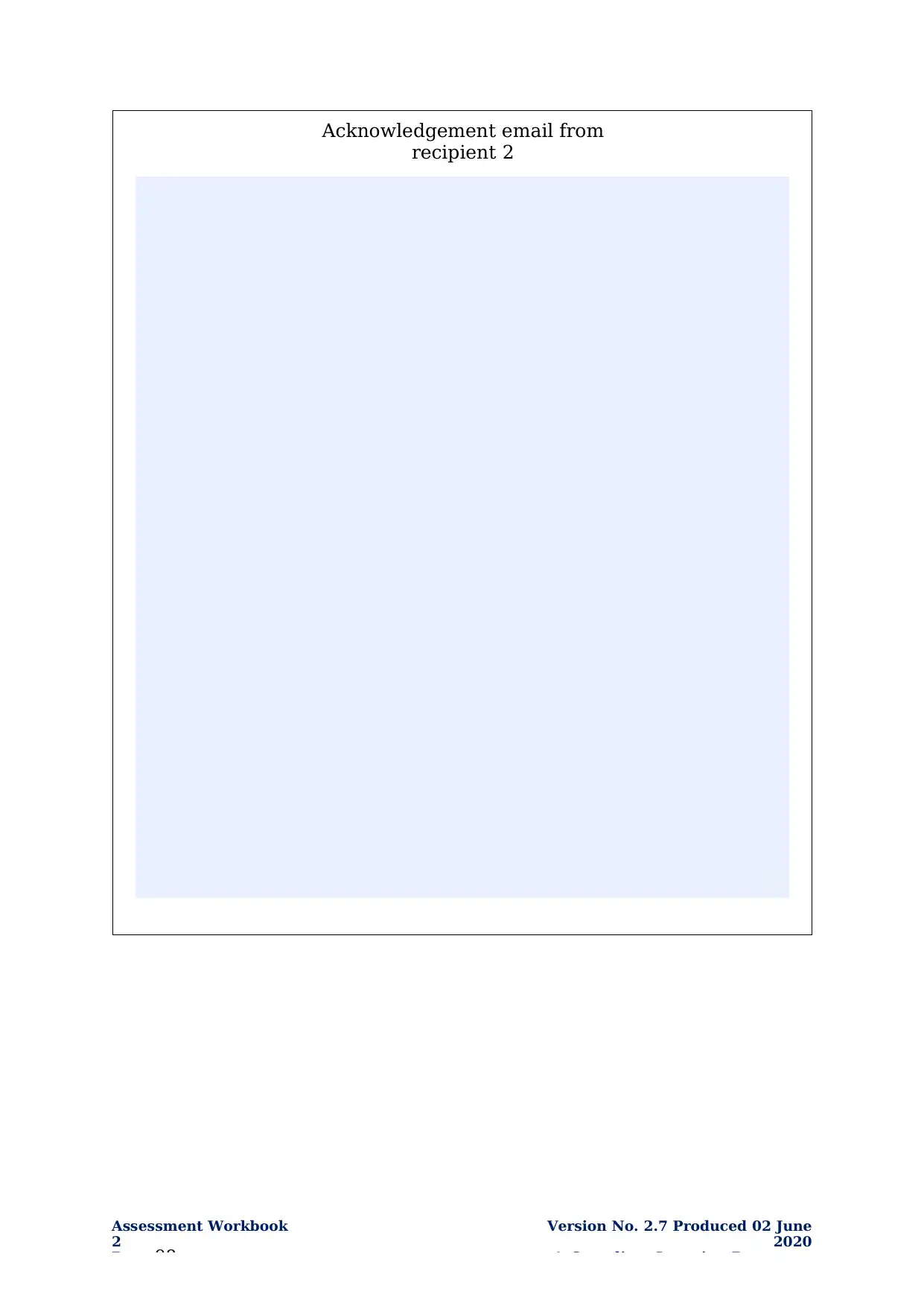
2
Page 98
Version No. 2.7 Produced 02 June
2020
© Compliant Learning Resources
Acknowledgement email from
recipient 2
You're viewing a preview
Unlock full access by subscribing today!
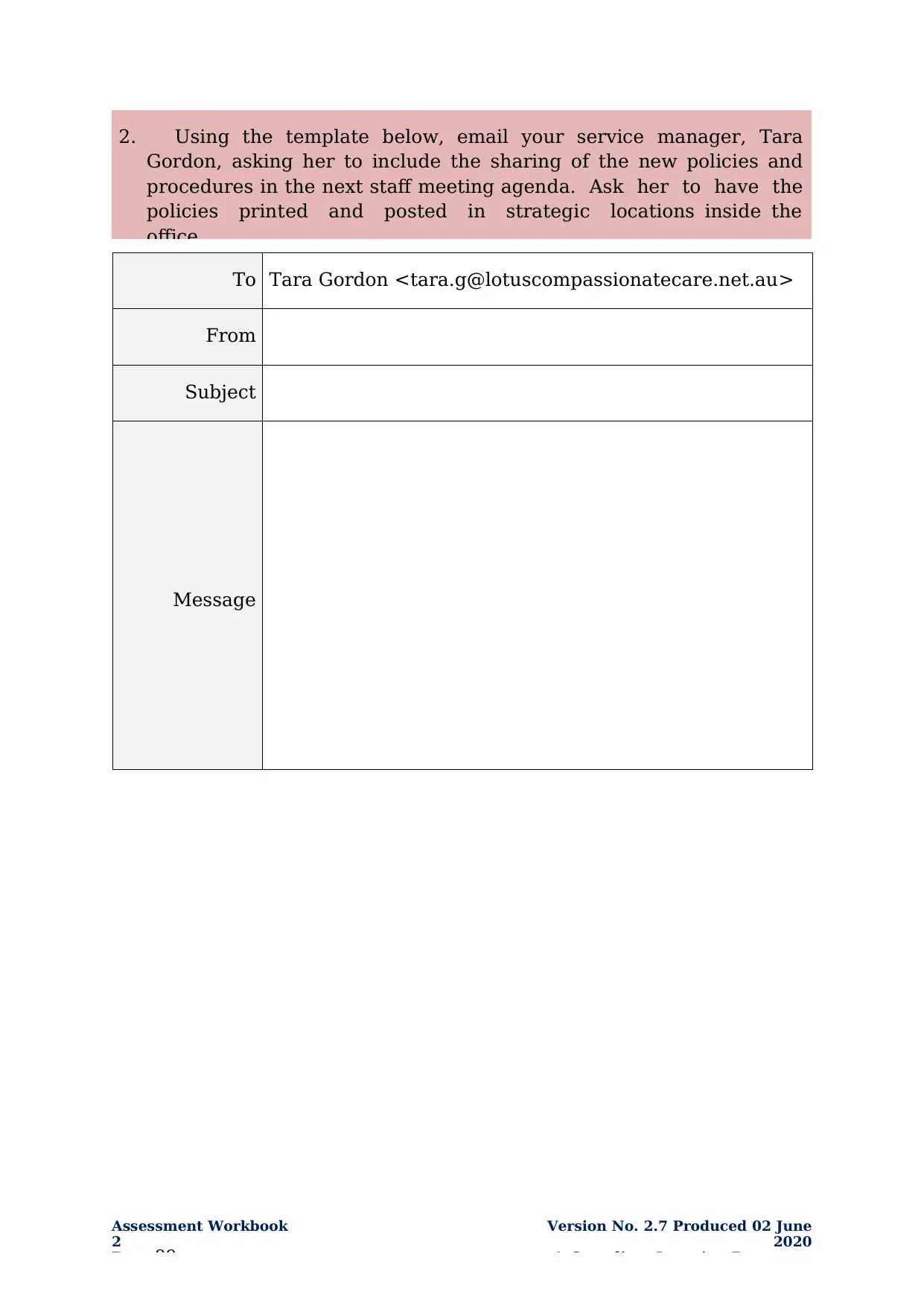
2
Page 99
Version No. 2.7 Produced 02 June
2020
© Compliant Learning Resources
To Tara Gordon <tara.g@lotuscompassionatecare.net.au>
From
Subject
Message
2. Using the template below, email your service manager, Tara
Gordon, asking her to include the sharing of the new policies and
procedures in the next staff meeting agenda. Ask her to have the
policies printed and posted in strategic locations inside the
office.
Paraphrase This Document
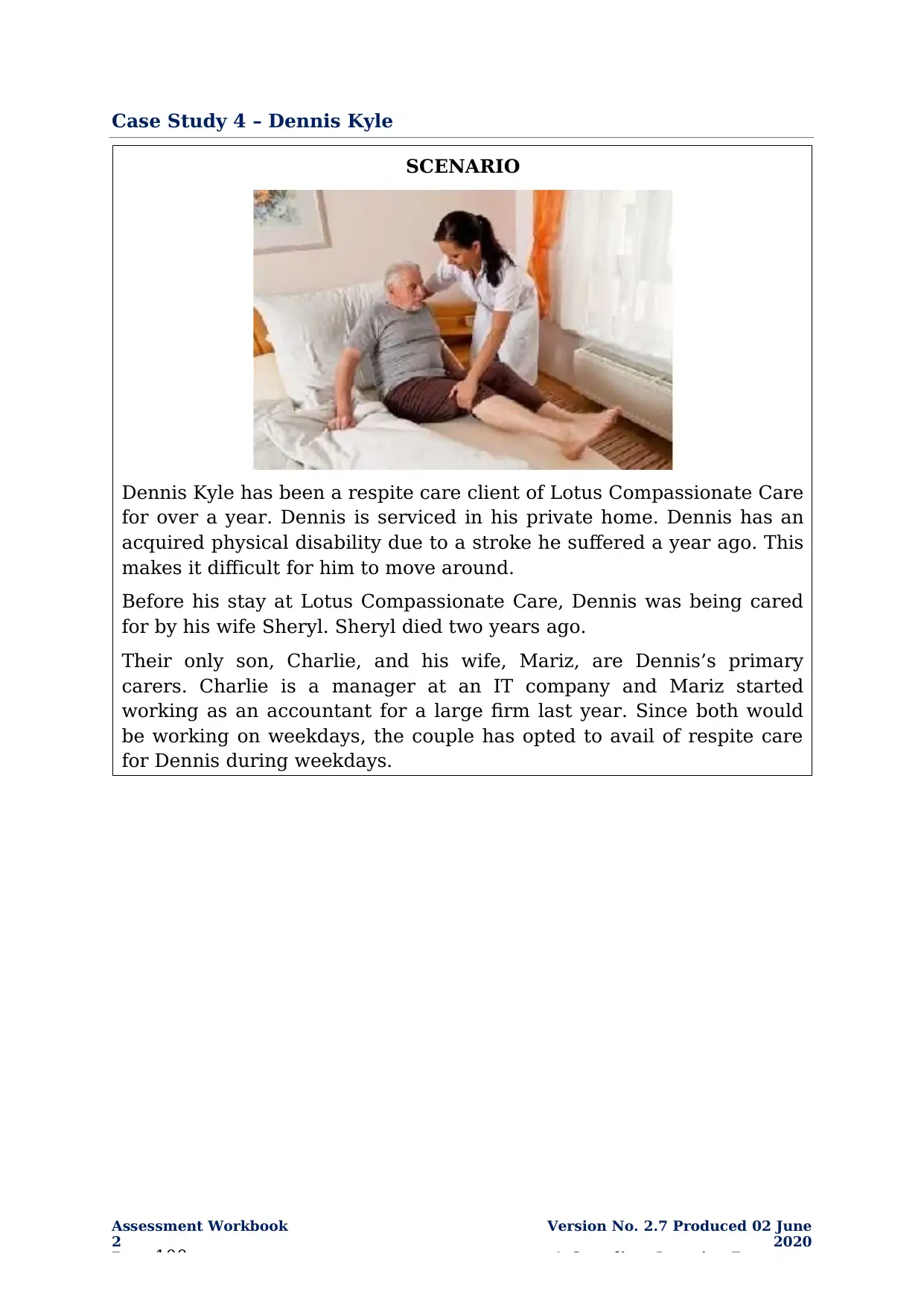
2
Page 100
Version No. 2.7 Produced 02 June
2020
© Compliant Learning Resources
Case Study 4 – Dennis Kyle
SCENARIO
Dennis Kyle has been a respite care client of Lotus Compassionate Care
for over a year. Dennis is serviced in his private home. Dennis has an
acquired physical disability due to a stroke he suffered a year ago. This
makes it difficult for him to move around.
Before his stay at Lotus Compassionate Care, Dennis was being cared
for by his wife Sheryl. Sheryl died two years ago.
Their only son, Charlie, and his wife, Mariz, are Dennis’s primary
carers. Charlie is a manager at an IT company and Mariz started
working as an accountant for a large firm last year. Since both would
be working on weekdays, the couple has opted to avail of respite care
for Dennis during weekdays.
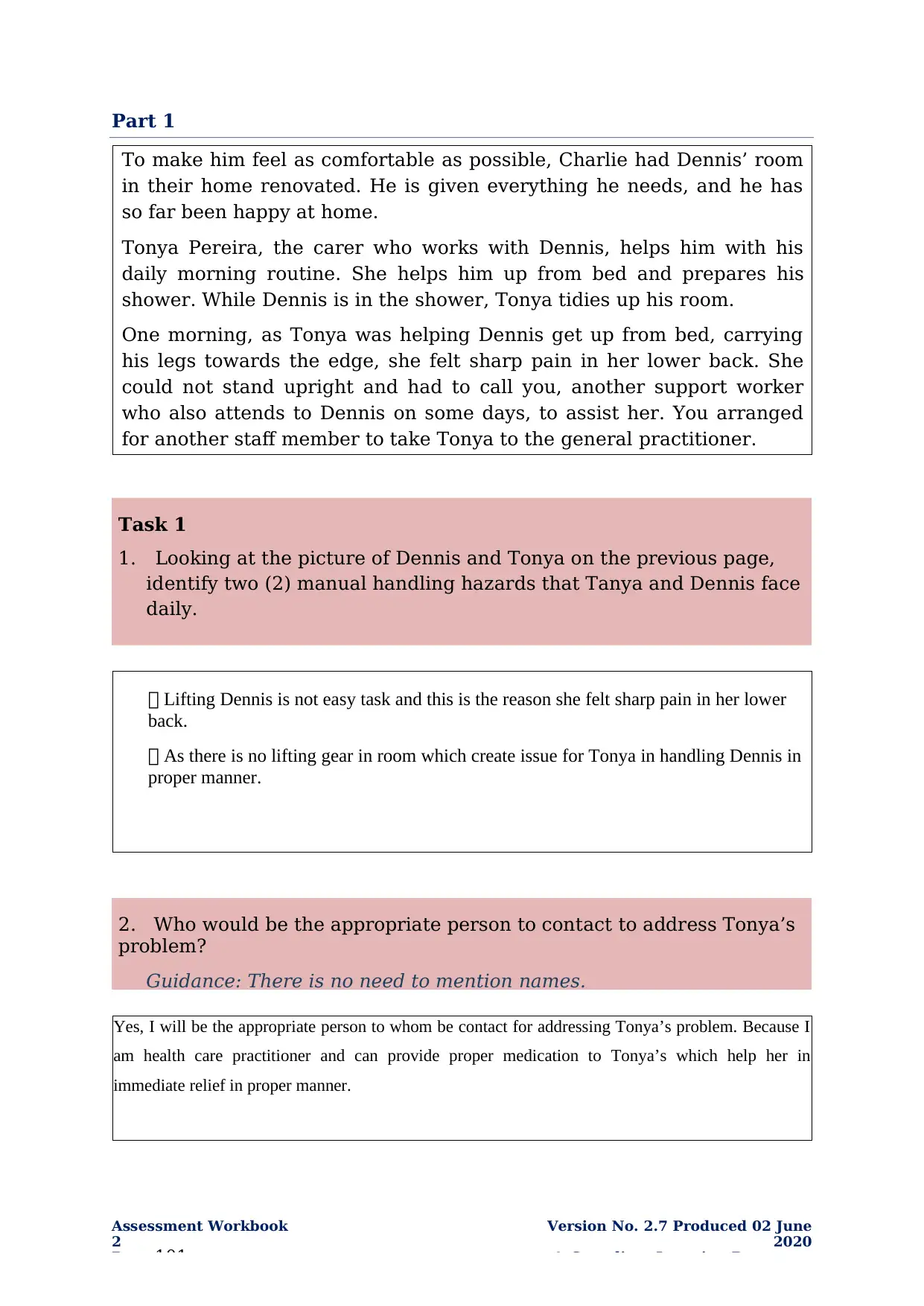
2
Page 101
Version No. 2.7 Produced 02 June
2020
© Compliant Learning Resources
Part 1
To make him feel as comfortable as possible, Charlie had Dennis’ room
in their home renovated. He is given everything he needs, and he has
so far been happy at home.
Tonya Pereira, the carer who works with Dennis, helps him with his
daily morning routine. She helps him up from bed and prepares his
shower. While Dennis is in the shower, Tonya tidies up his room.
One morning, as Tonya was helping Dennis get up from bed, carrying
his legs towards the edge, she felt sharp pain in her lower back. She
could not stand upright and had to call you, another support worker
who also attends to Dennis on some days, to assist her. You arranged
for another staff member to take Tonya to the general practitioner.
Lifting Dennis is not easy task and this is the reason she felt sharp pain in her lower
back.
As there is no lifting gear in room which create issue for Tonya in handling Dennis in
proper manner.
Yes, I will be the appropriate person to whom be contact for addressing Tonya’s problem. Because I
am health care practitioner and can provide proper medication to Tonya’s which help her in
immediate relief in proper manner.
Task 1
1. Looking at the picture of Dennis and Tonya on the previous page,
identify two (2) manual handling hazards that Tanya and Dennis face
daily.
2. Who would be the appropriate person to contact to address Tonya’s
problem?
Guidance: There is no need to mention names.
You're viewing a preview
Unlock full access by subscribing today!
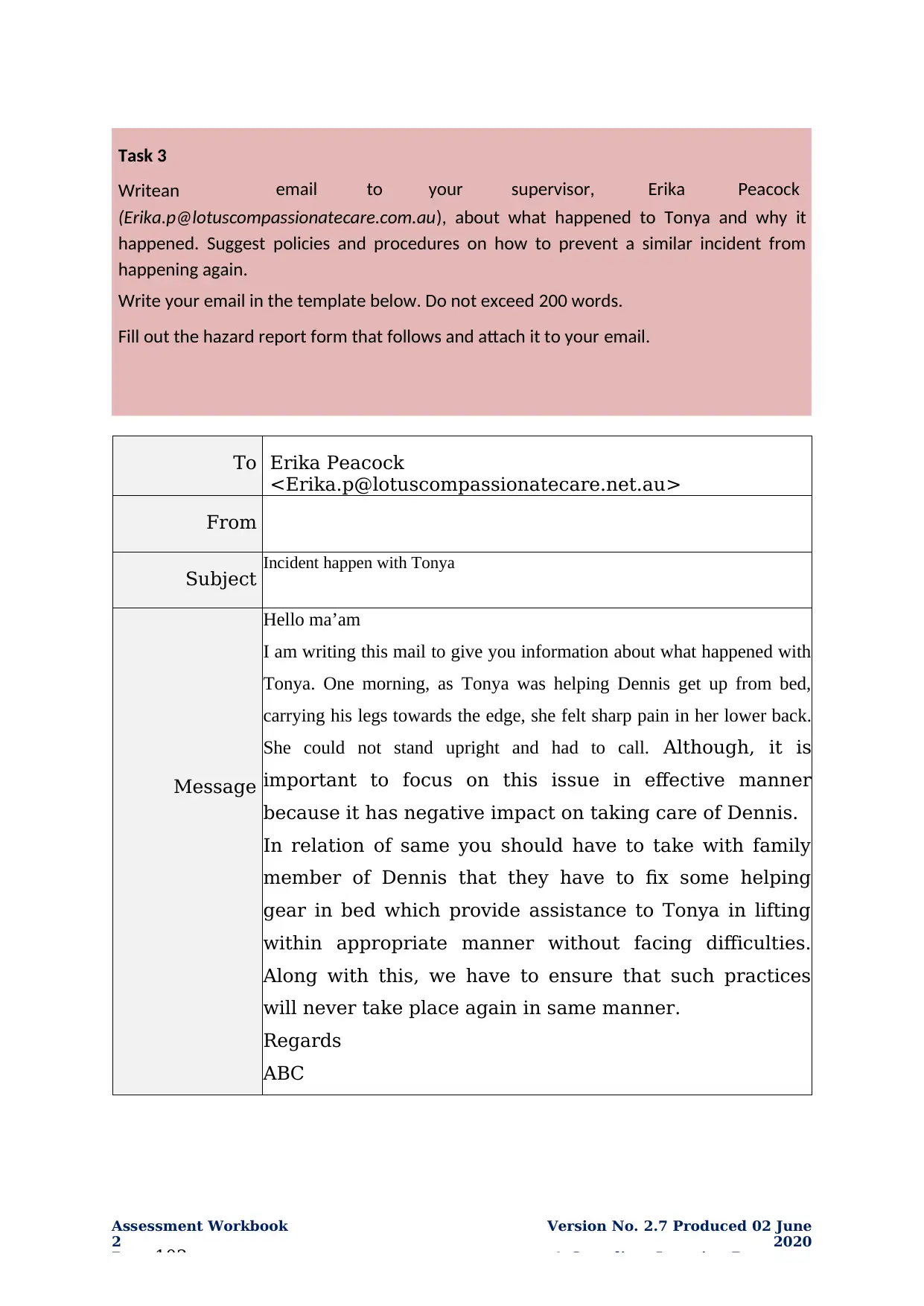
2
Page 102
Version No. 2.7 Produced 02 June
2020
© Compliant Learning Resources
To Erika Peacock
<Erika.p@lotuscompassionatecare.net.au>
From
Subject Incident happen with Tonya
Message
Hello ma’am
I am writing this mail to give you information about what happened with
Tonya. One morning, as Tonya was helping Dennis get up from bed,
carrying his legs towards the edge, she felt sharp pain in her lower back.
She could not stand upright and had to call. Although, it is
important to focus on this issue in effective manner
because it has negative impact on taking care of Dennis.
In relation of same you should have to take with family
member of Dennis that they have to fix some helping
gear in bed which provide assistance to Tonya in lifting
within appropriate manner without facing difficulties.
Along with this, we have to ensure that such practices
will never take place again in same manner.
Regards
ABC
Task 3
Writean email to your supervisor, Erika Peacock
(Erika.p@lotuscompassionatecare.com.au), about what happened to Tonya and why it
happened. Suggest policies and procedures on how to prevent a similar incident from
happening again.
Write your email in the template below. Do not exceed 200 words.
Fill out the hazard report form that follows and attach it to your email.
Paraphrase This Document
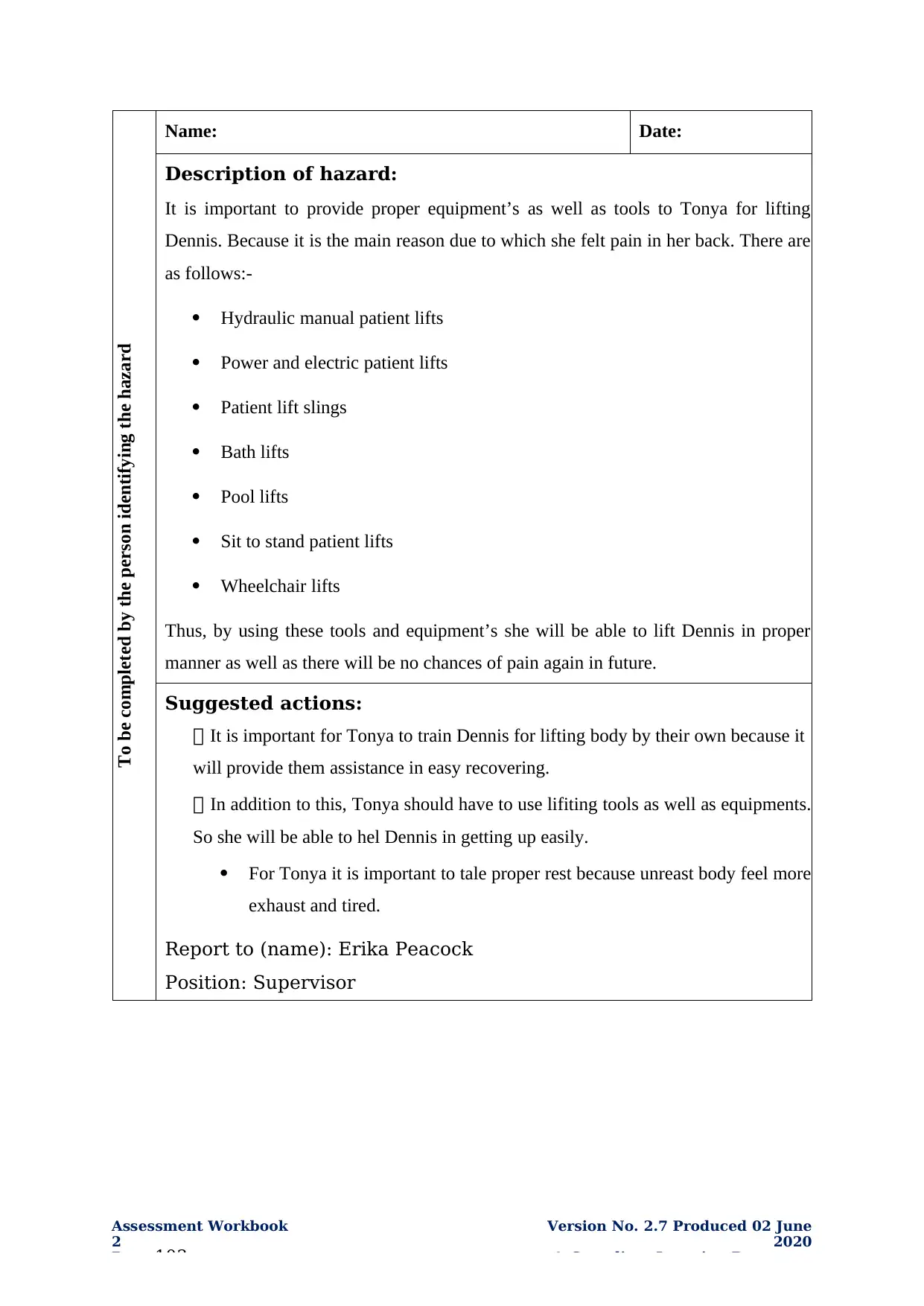
2
Page 103
Version No. 2.7 Produced 02 June
2020
© Compliant Learning Resources
To be completed by the person identifying the hazard
Name: Date:
Description of hazard:
It is important to provide proper equipment’s as well as tools to Tonya for lifting
Dennis. Because it is the main reason due to which she felt pain in her back. There are
as follows:-
Hydraulic manual patient lifts
Power and electric patient lifts
Patient lift slings
Bath lifts
Pool lifts
Sit to stand patient lifts
Wheelchair lifts
Thus, by using these tools and equipment’s she will be able to lift Dennis in proper
manner as well as there will be no chances of pain again in future.
Suggested actions:
It is important for Tonya to train Dennis for lifting body by their own because it
will provide them assistance in easy recovering.
In addition to this, Tonya should have to use lifiting tools as well as equipments.
So she will be able to hel Dennis in getting up easily.
For Tonya it is important to tale proper rest because unreast body feel more
exhaust and tired.
Report to (name): Erika Peacock
Position: Supervisor
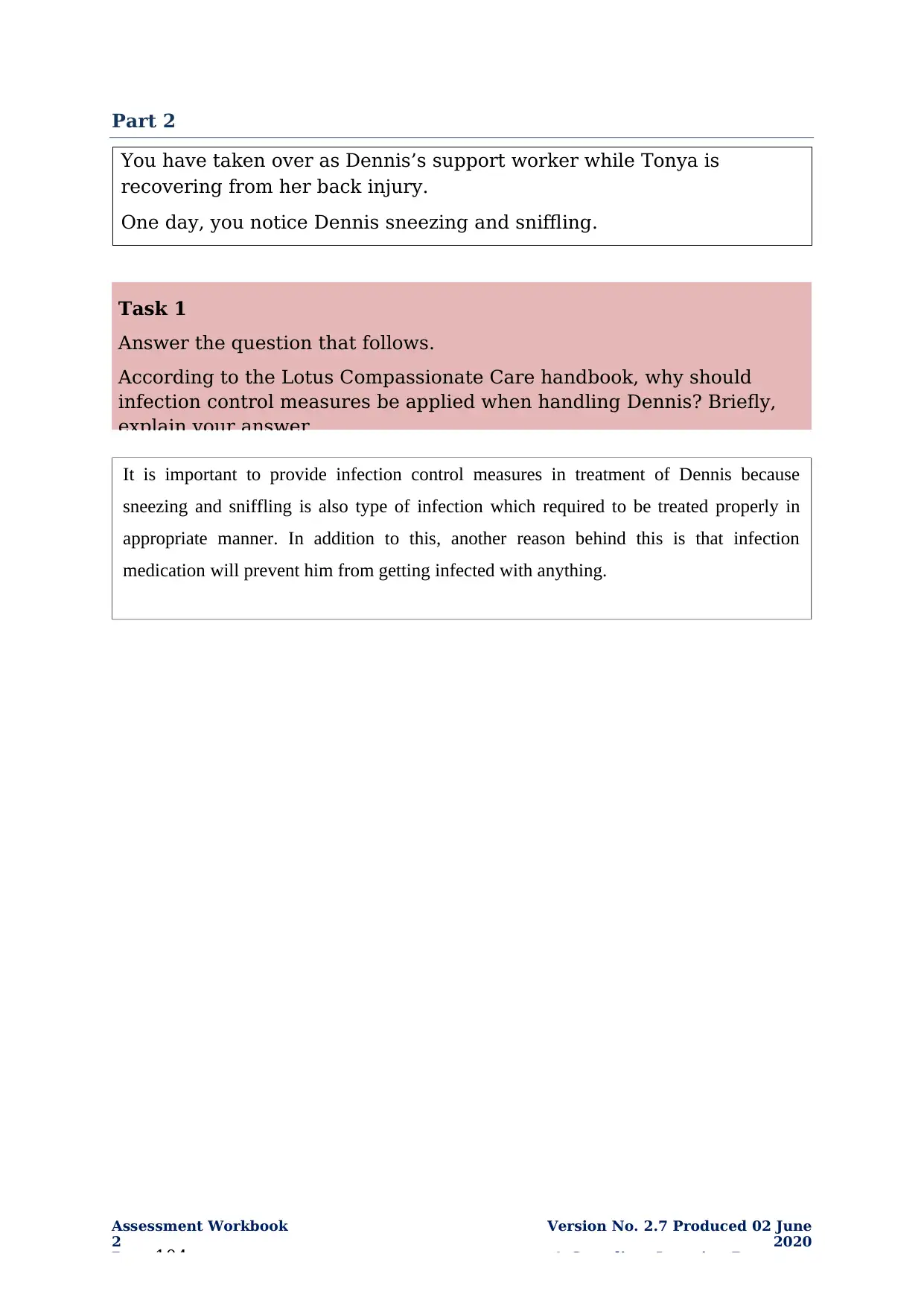
2
Page 104
Version No. 2.7 Produced 02 June
2020
© Compliant Learning Resources
Part 2
Task 1
Answer the question that follows.
According to the Lotus Compassionate Care handbook, why should
infection control measures be applied when handling Dennis? Briefly,
explain your answer.
It is important to provide infection control measures in treatment of Dennis because
sneezing and sniffling is also type of infection which required to be treated properly in
appropriate manner. In addition to this, another reason behind this is that infection
medication will prevent him from getting infected with anything.
You have taken over as Dennis’s support worker while Tonya is
recovering from her back injury.
One day, you notice Dennis sneezing and sniffling.
You're viewing a preview
Unlock full access by subscribing today!
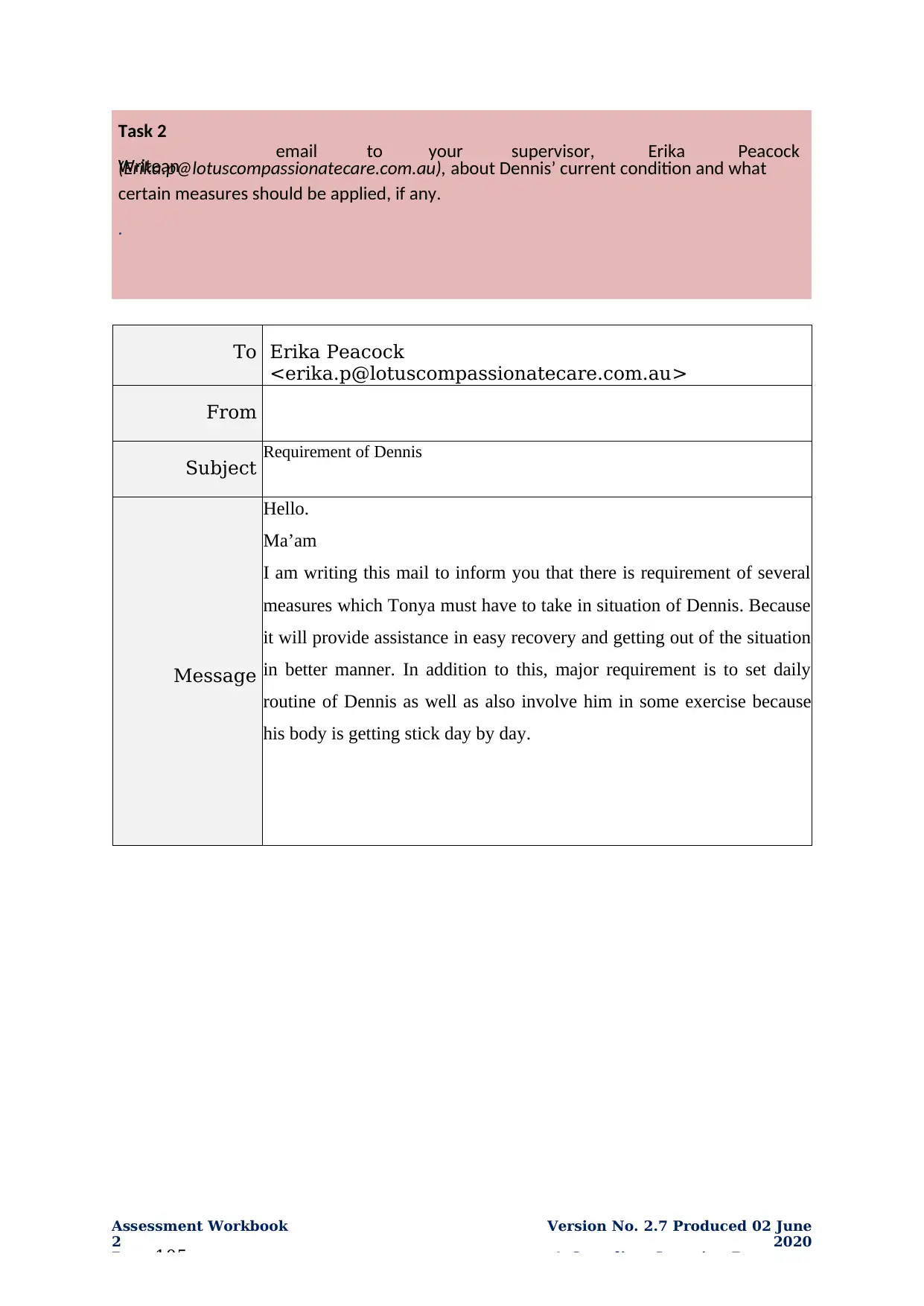
2
Page 105
Version No. 2.7 Produced 02 June
2020
© Compliant Learning Resources
To Erika Peacock
<erika.p@lotuscompassionatecare.com.au>
From
Subject Requirement of Dennis
Message
Hello.
Ma’am
I am writing this mail to inform you that there is requirement of several
measures which Tonya must have to take in situation of Dennis. Because
it will provide assistance in easy recovery and getting out of the situation
in better manner. In addition to this, major requirement is to set daily
routine of Dennis as well as also involve him in some exercise because
his body is getting stick day by day.
Task 2
Writean email to your supervisor, Erika Peacock
(Erika.p@lotuscompassionatecare.com.au), about Dennis’ current condition and what
certain measures should be applied, if any.
.
Paraphrase This Document

2
Page 106
Version No. 2.7 Produced 02 June
2020
© Compliant Learning Resources

2
Page 107
Version No. 2.7 Produced 02 June
2020
© Compliant Learning Resources
You're viewing a preview
Unlock full access by subscribing today!
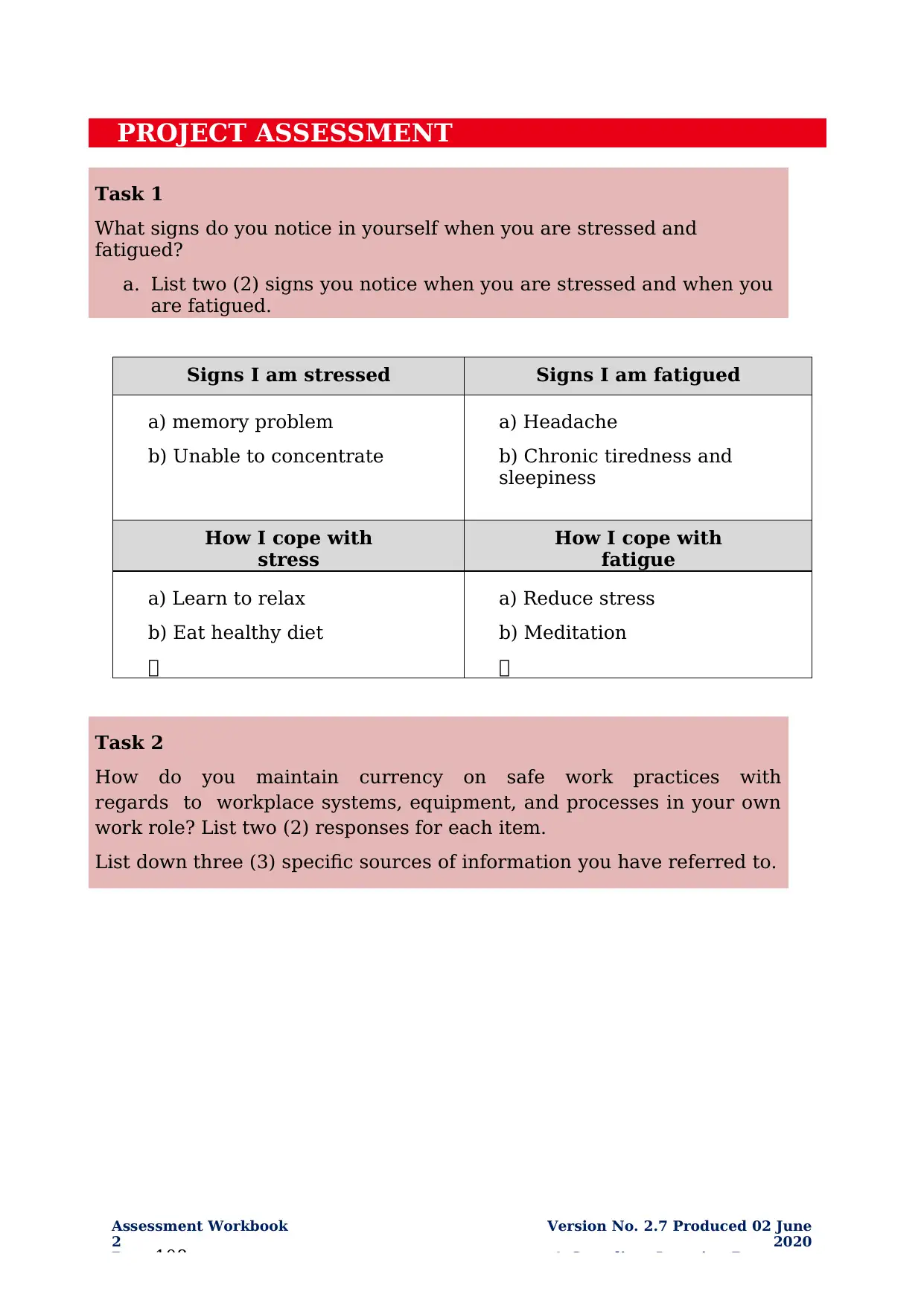
2
Page 108
Version No. 2.7 Produced 02 June
2020
© Compliant Learning Resources
PROJECT ASSESSMENT
Signs I am stressed Signs I am fatigued
a) memory problem
b) Unable to concentrate
a) Headache
b) Chronic tiredness and
sleepiness
How I cope with
stress
How I cope with
fatigue
a) Learn to relax
b) Eat healthy diet
a) Reduce stress
b) Meditation
Task 1
What signs do you notice in yourself when you are stressed and
fatigued?
a. List two (2) signs you notice when you are stressed and when you
are fatigued.
Task 2
How do you maintain currency on safe work practices with
regards to workplace systems, equipment, and processes in your own
work role? List two (2) responses for each item.
List down three (3) specific sources of information you have referred to.
Paraphrase This Document
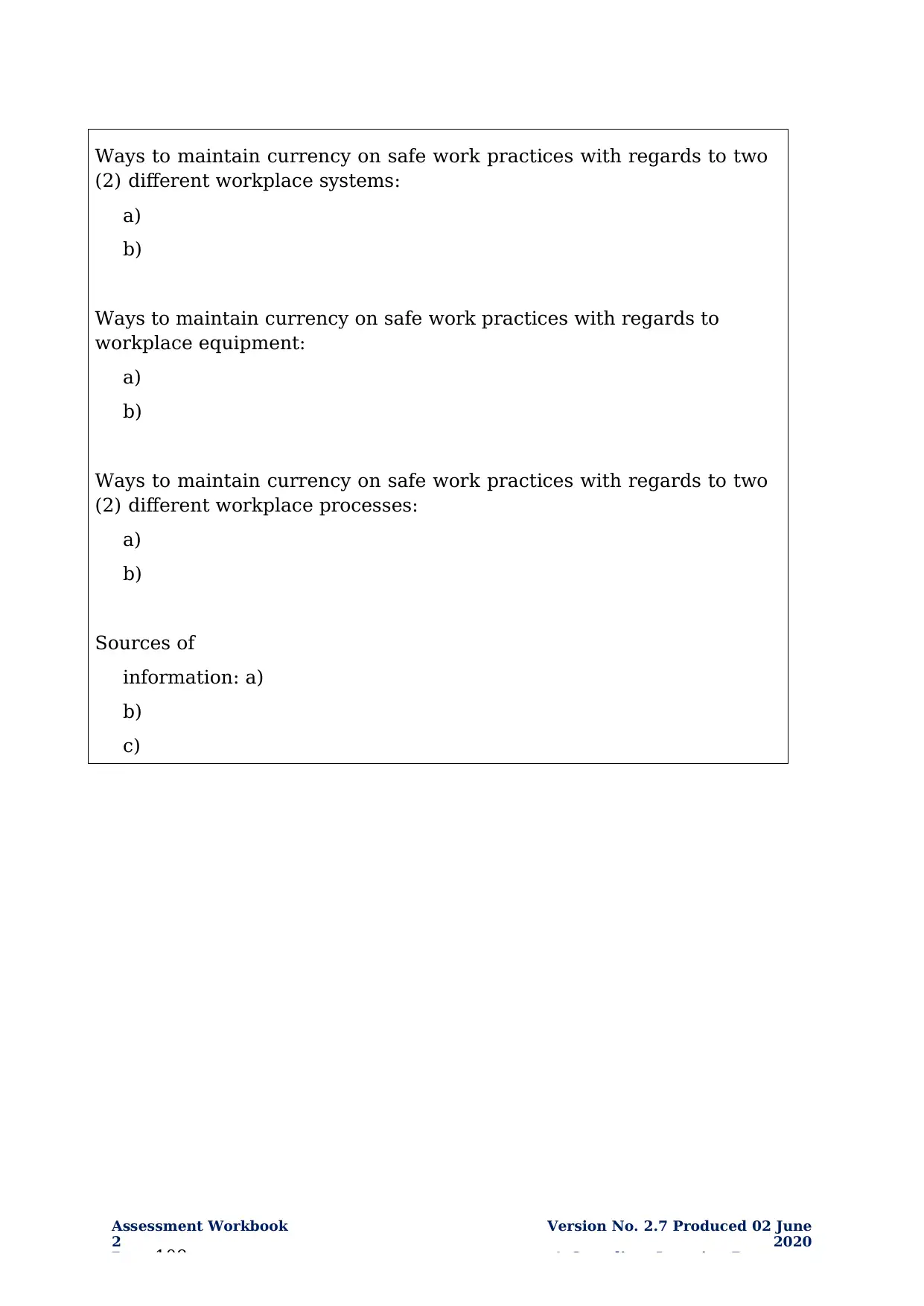
2
Page 109
Version No. 2.7 Produced 02 June
2020
© Compliant Learning Resources
Ways to maintain currency on safe work practices with regards to two
(2) different workplace systems:
a)
b)
Ways to maintain currency on safe work practices with regards to
workplace equipment:
a)
b)
Ways to maintain currency on safe work practices with regards to two
(2) different workplace processes:
a)
b)
Sources of
information: a)
b)
c)

2
Page 110
Version No. 2.7 Produced 02 June
2020
© Compliant Learning Resources
You're viewing a preview
Unlock full access by subscribing today!

2
Page 111
Version No. 2.7 Produced 02 June
2020
© Compliant Learning Resources
Paraphrase This Document

Related Documents
Your All-in-One AI-Powered Toolkit for Academic Success.
+13062052269
info@desklib.com
Available 24*7 on WhatsApp / Email
![[object Object]](/_next/static/media/star-bottom.7253800d.svg)
© 2024 | Zucol Services PVT LTD | All rights reserved.





